Australian
and international
exploratory
performance and
media arts
Why is bad theatre so excruciating? Why is it so much worse than bad film? This question vexes many of us who spend a reasonable amount of our professional lives sitting in uncomfortable spaces enduring the slings and arrows of tragic theatre. So when the word gets out that something good is happening, we are prepared to endure a stinking hot night and a venue renowned for back-breaking seating and zero oxygen. Who and what was the cause of all this selfless devotion? Blame Matthew Lutton, whose outstanding physical and truly absurd production of Ionesco’s The Bald Prima Donna, had audiences in raptures during the 2003 WA Fringe Festival. Not surprisingly, it was awarded Best Fringe Production.
Lutton has packed a lot into his young life. At a mere 19 years of age, his credits include director, writer and performer. As a performer, he has been clown, acrobat, puppeteer and actor. With his company, ThinIce Productions, he has adapted and directed several productions. In 2002, he wrote and directed the sell-out physical theatre piece Trading Fates at the Blue Room Theatre and presented a self-devised work at PICA during Putting on an Act. So far this year, Lutton has directed the epic masked production of George Orwell’s Animal Farm and worked as assistant director on Be Active BSX’s Six Characters in Search of an Author and Black Swan Theatre Company’s The Merry Go Round in the Sea. In 2004 he is looking to direct Bed, a new script by Sydney writer Brendan Cowell in a multi-dimensional, audio visual and visceral production at PICA. Lutton is definitely across the boards (sic). He has just been appointed Director of BSX, a company for young artists producing new and contemporary theatre works with professional support from Black Swan Theatre Company. Oh, did I happen to mention that Lutton is currently completing his 2nd year of Theatre Arts at WAAPA. Long live good art.
RealTime issue #57 Oct-Nov 2003 pg. 32
© Sarah Miller; for permission to reproduce apply to realtime@realtimearts.net
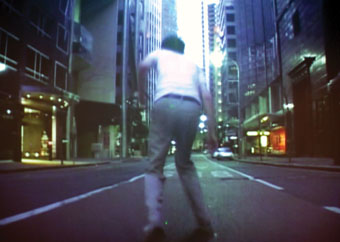
TV Moore, The Dead Zone
In a small, darkened sideroom in Sydney's Artspace, 2 large screens face each other. You sit on a padded seat between, turning to take one in and then the other, adjusting to 2 close views of a man running slo-mo through an empty Sydney CBD. Because he’s running backwards and because the speed isn’t modified to the point of mere artifice, and because the man keeps turning his head to see where he’s been/heading, there’s a loping anti-gravitational lyricism to The Dead Zone that adds to the doomsday suggestiveness of empty streets and time undone. Or, as Moore notes, “this barefooted man is certainly terrified but perhaps he is in fact running from himself.” The work was exhibited at the recent showing of Helen Lempriere Travelling Art Scholarship 2003 finalists at Sydney’s Artspace and was Highly Commended by the judges. With relatively simple means, Dead Zone exploits our cinematic awareness to maximum effect, multiplying meanings in a short time and lingering much longer than its 3 minutes 30 seconds duration. We’ll be watching more TV Moore.
RealTime issue #57 Oct-Nov 2003 pg. 39
© RealTime ; for permission to reproduce apply to realtime@realtimearts.net
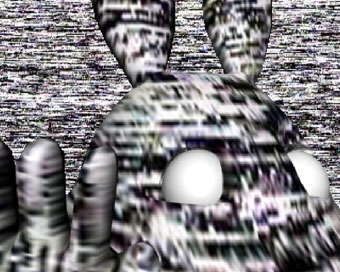
Mel Donat, Memory Play Back
Combining the warmth of analogue audio and video equipment with the calculated cool of their digital offspring, 4 Sydney artists explore a range of transitional/crossover/meeting points—between sound and image, personal and public, past and future, remembering and forgetting, observer and observed… Andrew Gadow, Mel Donat, Tim Ryan and Phil Williams emerged from Honours level electronic arts studies guided by senior lecturer Peter Charuk at the School of Contemporary Arts, University of Western Sydney. This year they will have an exhibition, Digital Decoupage, at First Draft Gallery, December 3-14. With varied interests, they work separately as well as on collaborative projects.
Gadow explores the translations from sound to vision and vice versa, generating pulsating video images from analogue synth keyboards, and making sounds from video footage. Most recently he exhibited in Tracking at Bathurst Regional Gallery. Gadow’s next appearance is at the upcoming Electro-fringe festival in Newcastle. Donat, working primarily in animation and installation, uses “subversion and contradictions to explore issues that may be considered disconcerting.” The installation—to be shown at First Draft—Memory Play Back, incorporates a hand-made soft toy rabbit, which operates as an interactive interface via which the viewer manipulates 3D imagery and sound. Donat’s experimental piece Trigger Displacement screened in the 2003 St Kilda Film Festival. Williams works mainly with sound in performance and installation, and for Digital Decoupage he continues with themes developed in the recent installation approaching silence at Casula Powerhouse, “a site specific meditation on the pursuit of absence.” Ryan’s work is a kind of minimal video. His Crash Media is currently touring New Zealand in the show Dirty Pixels. Ryan says the new piece, Future Proof, is concerned with ideas of obsolescence in the digital age.”[I]n this work I use defunct and faulty video technology to de-construct analogue footage.” Future Proof will show in Digital Decoupage in December, and, with Donat’s Bathing in A Warm Glow of Nothing will also be exhibited in Brainfeed at the Penrith Regional Gallery and Lewers’ Bequest, Oct 5-Nov 30.
RealTime issue #57 Oct-Nov 2003 pg. 39
© Linda Wallace; for permission to reproduce apply to realtime@realtimearts.net
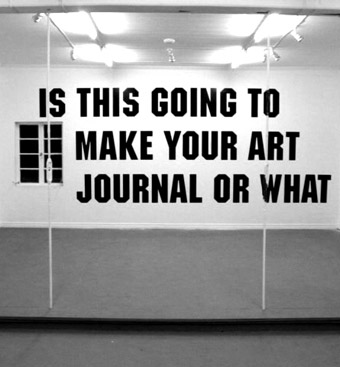
Sebastian Moody from 100% expression
In the text-based practice of Brisbane emerging artist Sebastian Moody there is a consistent concern with viewers and their reactions. With gestures both grand (such as the imposing statement “BUILT UNDER THE SUN” at Brisbane’s South Bank) and slight (the text “Primal man craves fire‚” posted in newspaper personal classifieds), Moody continually seeks a response, and considers each a little victory. However the response Moody seeks is never specific as his text works are fragmented, ambiguous and their precise intent continually debateable. What is important then, when encountering Moody’s work among the city’s landscape of advertising slogans, is the priceless freedom of choice that they wish to provide. In his most recent exhibition Generation: Point, Click, Drag, produced collaboratively with Craig Walsh as part of Moody’s 2003 Youth Arts Queensland Mentoring Program, the significance of the viewer’s response was again highlighted. Presenting gas masks and body bags emblazoned with the Nike logo, Walsh and Moody questioned the legitimacy of the audience’s, and also their own, ideological freedom within contemporary historical, social and economic contexts and the War on Iraq. Linking recreational sport and the war on terror, the show suggested the game of our current condition and the possibility that only a finite set of choices and responses exists. This gesture, intending to provoke a response, was not however predetermined as perhaps the response which commodity slogans endorse or games sanction. Rather, in his practice Moody seems to continually seek to conserve the reader’s free will in this increasingly authoritarian society.
RealTime issue #57 Oct-Nov 2003 pg. 39
© Sally Brand; for permission to reproduce apply to realtime@realtimearts.net
Like Camilla Hannan, Thembi Soddell is a grit/throb/atmosphere artist whose compositions featured in the early work of RMIT’s ((tRansMIT)) collective, helping to establish the Liquid Architecture festival. Where Hannan’s sound and installation work often has a cinematic, foley quality, laid out within spacious, hissy caverns (eg 4-Way Dam in 360 degrees: Women in sound, 2003), Soddell’s is arguably more abstract and mysterious. Her most recent piece—the superb installation Intimacy (also in 360 degrees)—was characterised by sudden jumps and cut-offs in sound, stochastic drop-outs in volume which revealed, on subsequent listening, a pre-existing subtext of sound now rising within the mix. The setting of Intimacy within a dark, claustrophobic alcove, bordered by heavy, red felt curtains, exaggerated its erotic and, at times, genuinely frightening trajectories. Soddell’s CV reveals her particular interest in the subconscious, psychological transformation of sound and space, which she prompts in the listener using processed field recordings and by exploring thresholds of perception. From an apparently ‘silent’ audio space comes a terrifying point of sound which then vanishes before it reaches such a conclusion that allows tension to be released. Although Intimacy represents the summit of this approach, Soddell has been moving towards it in pieces featured in the Document 03-Diffuse compilation (Dorobo, 2001) and the gallery showing and recording Gating (West Space, 2002). In her frightening fluxion between the organic (processed water sounds, air, etc) and the electronic, Soddell incites tense listening.
RealTime issue #57 Oct-Nov 2003 pg. 37
© Jonathan Marshall; for permission to reproduce apply to realtime@realtimearts.net
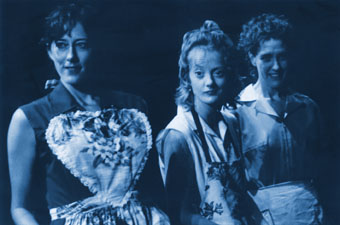
SacredCOW (Dawn Albinger, Scotia Monkivitch and Julie Robson) The Quivering
photo Suzon Fuks
SacredCOW (Dawn Albinger, Scotia Monkivitch and Julie Robson) The Quivering
SacredCOW (Dawn Albinger, Scotia Monkivitch and Julie Robson) is a Brisbane-based theatre ensemble that formed in 2000 to devise adventurous performance with strong physical and sonic scores. As they explain, “While touring and salsa dancing in the wild zones of Colombia, we dared each other to work together for 30 years.” And they’ve taken the dare seriously by establishing clear long term aims and direction for sustaining their fruitful collaboration. Inspired by “divas, lamenters, lullaby-makers and monsters”, SacredCOW became part of the Brisbane Powerhouse Centre for Live Arts’ Incubator program, designed to support local artists working on long-term laboratory style training and performance building. From here, the ensemble worked with Sydney-based director Nikki Heywood to devise The Quivering: a matter of life and death. SacredCOW’s creative partnership for The Quivering has since grown to involve Mount Olivet Hospice and the Creative Industries of Queensland University of Technology. With a history of assistance from Arts Queensland, the Australia Council and Playworks, The Quivering is scheduled for full production and a 2-week season at the Brisbane Powerhouse in November 2003. SacredCOW are also co-founding members of Magdalena Australia, part of an international network of women in theatre, and were coordinators for the recent International Magdalena Australia Festival in Brisbane.
RealTime issue #57 Oct-Nov 2003 pg. 34
© Mary Ann Hunter; for permission to reproduce apply to realtime@realtimearts.net
Frances Rings is an experienced dancer who is now emerging as a significant choreographer. She joined Bangarra Dance Theatre after graduating from NAISDA in 1993, 2 years after Stephen Page became artistic director. She performed in Page’s first full-length work, Praying Mantis Dreaming, and has continued to dance with the company, developing a remarkable onstage partnership with the late Russell Page. In 1995 she studied at Alvin Ailey American Dance Theatre, an experience that has strongly influenced her dancing and choreography. Ring’s first major choreographic work was Rations for the 2002 Bangarra double bill Walkabout, a narrative piece including an inventive use of props. Her pieces in the recent Bangarra work Bush were standouts: Slither, Stick and her own solo, Passing. Clear and inventive choreographic themes combined with traditional subjects in Slither and Stick, the latter featured a very effective use of stilt-like props, while Passing read as a moving eulogy for her former dance partner. As artistic director, Stephen Page encourages his dancers to develop their choreographic skills and this is evident in the opportunities he has given both Rings and Albert David. Rings has 2 major choreographic projects lined up for the coming year and is clearly keen to continue developing her craft both inside and beyond the Bangarra fold.
RealTime issue #57 Oct-Nov 2003 pg. 34
© Erin Brannigan; for permission to reproduce apply to realtime@realtimearts.net
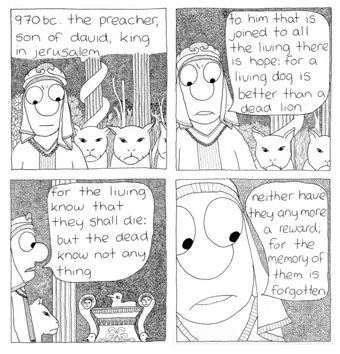
Rainer Mora Mathews, Dead Lions
Rainer Mora Mathews has exhibited as a cartoonist since he was 10. Now in his late 20s, he’s been working on Dead Lions (from the verse in Ecclesiastes: “for a living dog is better than a dead lion. For the living know that they shall die, but the dead know not anything”) for several years. It’s extraordinarily ambitious: a 300-page investigation of how we relate to our ancestors. The narrative stems from Mora Mathews’ fascination with his own ancestry: the experiences of his father’s family as Jewish Holocaust survivors and his mother’s Australian forebears’ role in removing Aboriginal people from their land.
Woven into this narrative is a series of archetypal myths from the Jewish and Western European tradition that reflect on ancestral relations. The comic form, which is a key creative paradigm for Mora Mathews (“this is not a novel nor a storyboard for a film”) enables a visual progression through which the ancestors or ‘dead lions’ take shape in the background, becomingly increasingly involved with the ‘live’ action in the foreground. This isn’t visual philosophy of the ‘Freud for Beginners’ variety but the telling of stories in ways that elicit philosophical reflection. The fusion is understandable. Mora Mathews’ mother, Freya Mathews, is one of Australia’s leading eco-philosophers. His father, Philippe Mora, the filmmaker, once drew comics, and his grandmother, Mirka Mora’s paintings seem strongly influenced by the comic form. Rainer Mora Mathews has hibernated north of Bendigo for the past 6 months, finishing his opus. Dead Lions is an epic of the Euro-Australian experience.
–
RealTime issue #57 Oct-Nov 2003 pg. 34
© Richard Murphet; for permission to reproduce apply to realtime@realtimearts.net
Pseudo Sound Project is an experimental fusion of DIY technology within performance initiated by SA-based media artist and event-architect Kristian Thomas. PSP has evolved over the last few years in a progression of rooftop performances, clubs, artist-run galleries, festivals and master classes, in collaboration with local and internationally-based video artists and musicians. With a love for the techno-aesthetic, Thomas’ performances are obscure and bombastic, slipping between glitch-pop, the moving image, hardcore electronica and rhythmic nature sampling. With a wide variety of electronic video and audio artists invited to PSP events, Thomas’ performances are chaotic, sublime and often grating, impressing upon his audiences a predilection for real-time experiences bordering on the spiritual. As a travelling performance sphere, the techno-playground of Thomas’ iconic mobile icosahedron rig stands in sharp relief against natural backdrops, yet with an obvious reverence for the chosen landscape. Nature themes have figured prominently within many PSP festivals and shows, with PSP no 8 featuring the successful planting of 1000 native trees. Pseudo Space is an interactive gallery and shop set up by Thomas and his partner Kerry Scarvelis, a cool-hunting nu-fashion designer. Pseudo Space is a home base for PSP events, outlet for local moving art, electronica and emerging designers. It’s also the sole distribution point for Thomas’ unusual beer recipes. Blends such as VegieGarden–a wheat beer with coriander and orange–notorious to the regular patrons of Pseudo Space opening nights, has recently caught the interest of brewers and local café owners. With a smattering of Epicureanism and an ardour for all things glitchy, Pseudo Space has added some vigour to the quickening pulse of experimental art, design and hospitality in South Australia.
RealTime issue #57 Oct-Nov 2003 pg. 33
© Samara Mitchell; for permission to reproduce apply to realtime@realtimearts.net
Compared critically with brilliant artists DJ Shadow, The Beastie Boys, Tricky and David Lynch, The New Pollutants are making a big impact on the live arts scene in Adelaide and beyond. Featuring the talents of Benjamin Speed aka Mr Speed (vocals), and Tyson Hopprich aka DJ Tr!p (the 8-bit Wonder), The New Pollutants are intellectual hip-hop with an experimental edge. These guys have their own sound, it’s global and it’s local and it has evolved from who these artists are. In this sense, the experience of their work is intimate, leaving their audiences gasping—for air and for more! The New Pollutants recently
released their independent EP at Minke Bar in Adelaide—Urban Professional Nightmares, following their critically acclaimed debut album Hygene Atoms. These guys take lo-tech augmentation to the extreme, using the obsolete Commodore 64 S.I.D. Chip soundcard in the bedroom studio. The resulting sound is altered, embracing lo-fi technology with a familiar flavour. The New Pollutants are best experienced live, where the sensory atmosphere is addictive and the beats are phat. The live experience integrates visual experiments with original sound and a theatrical, interactive edge. The New Pollutants produce an honest sound with grounded ideas driving the creation of their work. There’s no doubt these guys are going to be huge, but only as huge as they want to be.
RealTime issue #57 Oct-Nov 2003 pg. 33
© Rachel Kent; for permission to reproduce apply to realtime@realtimearts.net
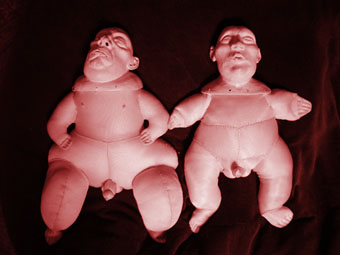
Rachael Guy, Doughboys
Over the past decade Rachael Guy has worked across several disciplines. Formally trained as a visual artist, her voice has been in demand in contemporary music theatre circles and she has been a soloist in Ihos Opera productions. Writing is another passion. For a long time Guy has wanted to create a body of work that incorporates all these practices. She began exploring the concept of adult puppetry and in 1999 produced a series of erotic dolls with highly detailed porcelain heads and hand stitched lingerie bodies. Disquieting and fascinating to look at, these little figures became conduits for Guy's themes of transgression, appetite and ambiguity. Seeing them in an installation, or being held or regarded by people (usually with a mixture of curiosity, revulsion and humour), gave her the idea for Torrington’s Buttons, a solo show which will lie somewhere between performance art and theatre. The piece provides a vehicle through which Guy explores her experience as an adolescent, grappling with a sense of acute isolation in the suburbs of Launceston and how she dealt with this by forming an intense emotional and imaginative attachment to a deceased sailor (a member of the Franklin Expedition to find the Northwest Passage in 1845-8). In 1986, the perfectly preserved remains of the young sailor, John Torrington, were exhumed from permafrost. His image appeared in the media and struck a profound emotional chord with Rachel Guy during a difficult adolescent period. She intends to tell this story of adolescent love survival through a theatre work that combines narrative, song and puppetry in a minimal theatrical setting.
RealTime issue #57 Oct-Nov 2003 pg. 33
© Susanne Kennedy; for permission to reproduce apply to realtime@realtimearts.net
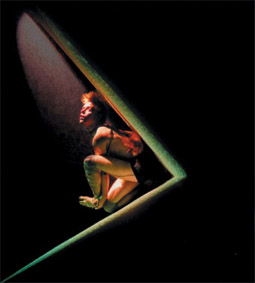
Ninian Donald The Obcell
photo Mark Gordon, Garry Barnes
Ninian Donald The Obcell
Fiona Malone’s career is a model of multi-skilling . She’s worked in Australia and Europe in all manner of dance forms from folkloric to dance theatre to movement research with an abiding interest in live multimedia performance. Before joining the Australian Dance Theatre in 2000, she toured Europe for 5 years with Belgian multimedia dance and technology company, Charleroi Dansers directed by Frederic Flamand. Last year, as well as being nominated in the Outstanding Female Dancer category at the Australian Dance Awards for her performance in the ADT’s The Age of Unbeauty, Fiona presented her site-specific work Bamboo Bathing at the Contemporary Art Centre of SA. Recently she spent a month in Birmingham as part of the DanceExchange program working with choreographers Henry Oguike and Akram Khan on the research and development of new ideas and movement.
This year Fiona was awarded an Australian Choreographic Centre fellowship to develop The Obcell, an interactive dance/theatre/multi-media performance addressing issues of human testing, manipulation and solitary confinement. The dancer wears the Diem Dance System, a new sensor-based technology designed for the use of dancers and composers at the Danish Institute of Electro-acoustic Music. Stage 1 of The Obcell was presented in the Risky Manoeuvres season at Canberra Theatre Centre earlier this year. In September, Stage 2 manifest as a collaboration between Malone and 4Bux:Progressive Arts, another multi-faceted Adelaide outfit. Performed by Ninian Donald with sound and technology by Peter Nielsen and dramaturgical input from director-designer Ross Ganf, early response suggests that while the themes of The Obcell need some refinement, the use of multimedia in live performance makes this a team to watch.
RealTime issue #57 Oct-Nov 2003 pg. 33
© Virginia Baxter; for permission to reproduce apply to realtime@realtimearts.net
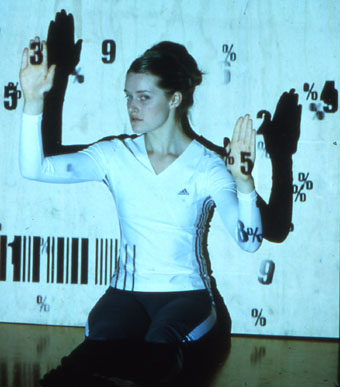
Stephanie Lake
photo Virginia Cummins
Stephanie Lake
Melbourne has been a centre for muscular, bony and often violently articulated choreography. Stephanie Lake is not new to this scene. She has danced for Phillip Adams (balletlab), Lucy Guerin, and Gideon Obarzanek (Chunky Move), and the influence of all 3 choreographers can be seen in her own pieces. Now that the physical characteristics of this trend within Melbourne dance have become fairly well defined, there has been a return to theatricality amongst such practitioners and it is here that Lake’s distinctiveness is most apparent. Her work is closest to Adams’ in its movement style and dramatic, violent energies, but if Adams’ dramaturgy is as much defined by the juxtaposition of theatrical ideas and elements as by anything else, then his is arguably a non-aesthetic, rather than a style per se. As such, this broad field of dance leaves plenty of room for Lake to invent her own mad imagery and strangely funny, off-kilter scenarios. Lake’s full-length work Love is the Cause (2001) represents the summit of her independent career to date, while her short study The Loop was the highlight of Chunky Move’s recent Three’s a Crowd program (2003) and exhibited considerable potential for development in its wryly angular, contemporary ballet. Lake has also collaborated with James Brennan on his staged events (namely Piglet, 2001). In the spaces between theatre and dance, surreal comedy and the avant-garde, Stephanie Lake has emerged as an important and invigorating new artist.
RealTime issue #57 Oct-Nov 2003 pg. 32
© Jonathan Marshall; for permission to reproduce apply to realtime@realtimearts.net
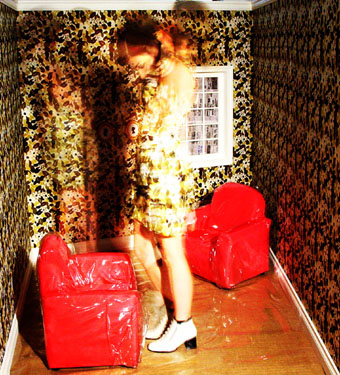
Anna Tregloan
It is apt that, among other projects, theatre-maker Anna Tregloan is adapting the writing of Borges. Like Tregloan, he often employed spatial devices as metaphors for social, philosophical and literary ambiguities: a map so detailed that it covered the landscape it represented, the library as labyrinth. Tregloan’s most recent piece is the still-embryonic performance installation, The Long Slow Death of a Porn Star. Along with design commissions ftom Danceworks, Circus Oz and The Three Interiors of Lola Strong, Tregloan has been devising her own installation-like productions such as Mach (2000) and Skinflick (2001). LSDPS is partly a sequel to the latter, in that both employed a series of voyeuristic scenarios to produce wonder, unease, discomfort, pleasure and seduction. Context and conjunction produce the theatrical content here.
In Skinflick the audience charmingly and somewhat vulnerably observed the performance at eye level, with their heads extending to the height of the stage from beneath the rostra. The staging of LSDPS was less restrictive–the performance had no formal beginning or end, offering spectators several linked spaces to traverse, or rest within. At the top of a staircase, beyond a tight hallway, and through a doorway draped with bordello-esque beads, lay a snug viewing hall peppered with mounted illustrations. At the other end sat a foreshortened recreation of a 1950s/60s chic domestic interior. To one side lay a small, white room containing a mounted crayon, endlessly describing a circle. In the hall before entering, a sign signalled that all objects were for sale, with a description and price of each. Art as stylish sexual commerce.
Within the toy-like domestic annex, 2 women–saturated with a sublime ennui-idly posed, gazed vacantly outwards, or collapsed in upon themselves and 2 little chairs. Much of the ‘action’ was provided by David Franzke’s gently scorifying, contemporary musique concrète score, composed of sounds of breath, inflation, deflation, moans, crackles, laughter and something akin to male masturbation.
It has been argued that pornography is inherently avant-garde because, to infuse viewers with feelings of masculine potency, pornographers strive to represent female orgasm, allowing the viewer to fantasise that he has produced this reaction in the subject of his gaze. Femal orgasm is however impossible to satisfactorily represent visibly or audibly. Despite the apparent explicitness of pornography, what makes something pornographic is in fact precisely what remains forever absent but alluded to within pornography itself. Tregloan’s interaction with and referencing of pornography (presented in a book available within the performance space) was not particularly satisfactory, but in producing this sense of pornographic absence, both Skinflick and her newer project were wonderful successes. Sex is never visible in Tregloan’s works, but it is one of the themes she virtuosically recreates through staging an absence of overt action, associated with a dark, explicitly voyeuristic audience relationship. Her circle-drawing machine was, in this context, the quintessential pornographic object, its aesthetic frottage terminally spirally around issues of sex and the feminine grotesque.
The Long Slow Death of a Porn Star—The prequel, director/designer/concept Anna Tregloan, performers Caroline Lee, Victoria Huff, music/sound David Franzke, Hush Hush Gallery, July 23-25
RealTime issue #57 Oct-Nov 2003 pg. 40
© Jonathan Marshall; for permission to reproduce apply to realtime@realtimearts.net
Video was one of the strongest components in the recent showing of Helen Lempriere Travelling Art Scholarship 2003 finalists at Sydney’s Artspace. In his finely shot and beautifully edited Pablo Velasquez Shoeboard Remix, Matthew Tumbers’ anonymous protagonist does everything you’d like to do with a skateboard— without actually using one. Feet skid assuredly across surfaces, the body twists and glides with the trademark crouch and angularity, the camera goes closeup on the virtuoso ride. Is this for real? Tumbers writes that his video “mimics and parodies a form, namely skateboard manoeuvers with elements of ‘street dance’, creating a fictional form that could well be real and achievable.” It’s pretty convincing, but the pleasure beyond surprise is in the dexterity of the very making. It’s a witty variation on other skateboard videos doing the rounds. Tumbers is a COFA graduate who has exhibited solo at Block and TAP galleries and whose Gumnut Xanadu 3: Expanding Conglomerates opens soon at Kudos Gallery.
RealTime issue #57 Oct-Nov 2003 pg. 31
© Keith Gallasch; for permission to reproduce apply to realtime@realtimearts.net
Jane McKernan is best known for her work as one of The Fondue Set, which she founded with Elizabeth Ryan and Emma Saunders in 2000. McKernan’s solos work in a more subtle register, still confronting the audience but drawing us in to share delicate observations and actions. She performed in Mobile States last year in a powerful solo, I Was Here and took the ideas behind this piece to Dancehouse in July this year where she performed an improvisation at Dance Card, an informal season featuring 5 dancers each week. She also appeared with Eleanor Brickhill in Waiting to Breath Out at Antistatic 2002, at Performance Space in Sydney. McKernan currently has “a Sigourney Weaver thing” and is developing a piece with Lizzie Thomson called Working Girl.
RealTime issue #57 Oct-Nov 2003 pg. 31
© Erin Brannigan; for permission to reproduce apply to realtime@realtimearts.net
Jodi Smith is a writer, photographer and filmmaker whose video Redux? Part 1 was in the recent showing of Helen Lempriere Travelling Art Scholarship 2003 finalists at Sydney’s Artspace. After working in Australia, New Zealand and the US as a camera assistant on such films as The Matrix, Smith has been accepted to study for an MA in Fine Art at The Slade School of Fine Art in London where she hopes to make a feature length film. Redux? Part 1 plays engagingly with our knowledge of Francis Ford Coppola’s Apocalypse Now and the constellation of masculine values that gravitate relentlessly around it. Smith remakes the first 6 minutes of the film, blending the original with carefully constructed scenes that mimic it closely but with a different protagonist—a woman. The effect is much more surprising and enduring than you’d first imagine. Smith writes, “Over the last year I have been dealing with the history of war and specifically how gender roles both define and are defined by war. A key issue within my filmmaking practice is the issue of female subjectivity—particularly the lack of it within the cinema and how this is a reflection of first world society.”
RealTime issue #57 Oct-Nov 2003 pg. 31
© RealTime ; for permission to reproduce apply to realtime@realtimearts.net
I remember the video as intensely coloured and almost hallucinogenic in its rainbow effects. The idea of someone videotaping the sun has a pathos and strange logic that is a defining feature of Kajio’s work. Often an intensely colourful and multi sensory experience, Kajio’s work uses heightened video colour effects or coloured light reflections. In her 2002 exhibition Forest of Invisible Waves, at the Contemporary Art Centre of SA, installation components such as water showers, acrylic rods and mirrors were used to create an immersive space of reflected and multidirectional projected light. Sound was used throughout the space, further dislocating reality. Kajio writes, “Reality is not something that is perceived directly…My work usually plays on this abstraction or distortion to create a kind of space between the viewer and my piece, in which they can experience an alternative ‘reality’.” In 2003 Kajio curated Electtroni Nessun Senso, at Downtown Art Space. In her work for this exhibition projected light swims up the walls, LCD lights are refracted through a glass fish bowl with oxygen bubbler. One interpretation (there are several) of the exhibition title is “electrons with no sense of direction.” Yoko Kajio was born in Kyoto, Japan. Since graduating from the South Australian School of Art in 2000 she has exhibited in Roslyn Oxley9 Gallery, Sydney, CACSA, the Physics Room and the Experimental Art Foundation. Kajio has also been a core member of performance art group shimmeeshok since 1998.
RealTime issue #57 Oct-Nov 2003 pg. 31
© Bridget Currie; for permission to reproduce apply to realtime@realtimearts.net

Sally Rees, video still, The Groove, 2003
Matt Warren is a multimedia artist who creates work for solo shows and collaborative pieces for performance installation and theatre. Awarded a Samstag scholarship in 1999, he completed a MFA at Simon Fraser University in Vancouver. He is currently a recipient of an Australia Council New Media Arts Board grant. Warren has recently returned from 8 weeks research in Germany and a grant from Arts Tasmania has enabled him to also work in the Czech Republic where he collaborated with a performance poet and an electro-acoustic composer to produce a performance installation for the Cultural Exchange Station total recall festival. Warren’s work has evolved from his initial explorations around the concept of absence, culminating in on the run (2002). His current concerns are exploring the ideas inherent in transcendence, the sublime and the supernatural. Sally Rees is a pop music fan who incorporates single channel video and installation in works that use autobiography and self-portraiture. Her recent video The Groove (2003) and research focus on popular culture through exploring the emotional investment of its consumer audience. Rees’ developing practice includes a newly discovered capacity to perform in her video projects. She aims to move beyond the constraints of the rectangular screen and develop richer ways of using and viewing the medium. Rees collaborated with Matt Warren on the theatre piece Pop for IHOS Experimental Theatre Laboratory in 2002.
RealTime issue #57 Oct-Nov 2003 pg. 31
© Sue Moss; for permission to reproduce apply to realtime@realtimearts.net
Here is a new event on its second outing, and of major significance for Australian live art/performance art. The intensification of the relationship between Australian and international performance scenes is building rapidly with the emergence of Time_Place_Space (see page 28), the Performance Space-PICA-Arnolfini (Bristol, UK) Breathing Space connection, and the visits of Blast Theory (2002) and Forced Entertainment (2004 Adelaide Festival). The welcome consolidation of this rich pattern of exchange is more than evident in The National Review of Live Art Midland, Perth’s international festival dedicated to the presentation and exploration of live art practice. Established in 2002, the NRLA Midland is a collaboration between the City of Swan and New Moves International (UK), producers of NRLA Glasgow, Europe’s longest running and most influential festival of Live Art.
This will be an unconventional festival, with works that will take you beyond the niceties of neat timetabling into the time-space loop of durational performances and installations offering contemplative experiences, new ways of regarding the body, movement and issues of the moment. The program includes Hideyuki Sawayanagi (Japan); sculptor and performance artist Richard Layzell (UK), also conducting workshops; Dutch choreographer Angelika Oei and sculptor RA Verouden (with <> “in which a spinning dancer causes notions of time to vanish”), lone twin (UK) and Alastair MacLennan (UK, Professor of Fine Art at the University of Ulster) in a 5-day durational performance/ installation. With Edith Cowan University's School of Contemporary Arts, NRLA Midland 2003 has also commissioned new works by Perdita Phillips, Gregory Pryor, Domenico de Clario, cAVity, Lyndal Jones and Geoff Overhew and Singaporean artist Chandrasekaran. Nikki Milican, Artistic Director of New Moves International, will be on hand as will Mary Brennan, courageous and incisive dance and live art critic for the Glasgow Herald, conducting a workshop with local writers.
Midland Railway Workshops, Oct 22-26
RealTime issue #57 Oct-Nov 2003 pg. 30
© RealTime ; for permission to reproduce apply to realtime@realtimearts.net
Inside the Angel House (scheduled for a short season in November) is a new multimedia performance being developed by Theatre of Speed, a group of young performers with disabilities, as part of the Geelong-based Back to Back Theatre’s workshop program. The workshops, led by director Marcia Ferguson and animator/filmmaker Rhian Hinkley, are focused on the skill development in performance, improvisation, animation and photography. Just before he left with Back to Back for their European tour—he created the projected imagery that surrounded audience and players so powerfully in Soft—Hinkley wrote, “Theatre of Speed is an amazing opportunity to work with some of the most innovative and creative artists in Australia. The work that these guys create is unlike any other. I received a research grant from the Australia Council New Media Arts Board which has allowed me to spend more time with the group than I previously would have and to investigate the production of graphics and video that recreate Downs Syndrome…not as an actual representation of the syndrome, rather as an indication of the creative possibilities and benefits that genetic abnormalities can produce. The actors have had a chance to look at and use some great new technology which has been really exciting for all of us: a large Wacom tablet, a new G4 laptop, video projector, large screen TV, DVD players and burners. The actors take to new technology without any fear or preconceptions; this leads to really exciting levels of development that other groups don’t reach.
“The Wacom was really excellent for a number of reasons. Firstly, the actors loved the concept of being able to draw in multiple colours and with different brushes while using the same pen. Also the concept of filling areas in with a single click was something that really excited them. Another interesting element was the handwriting recognition with Wacom and OSX. This produced some really interesting translations and with a simple Applescript program I could make the computer translate their writings and then read it back in a number of voices.
“In producing the animations we used 2 processes. The first is hands-on, direct input and control by the actors. In this scenario the actors devise, create and animate the work. We did everything from basic cut-out and puppetry, from scratch animation directly on 16mm film to Flash from drawn animations. This produces raw and energetic pieces that are unpredictable and follow unique paths designated by the actors.
“The second process was to use myself as a tool and let the actors create works as directors or collaborators, giving them access to the full power of the technology. By directing me to make changes to their work or to create things for them we could work in 3D, and use software that is normally too complex to pick up within a short timespan. This resulted in works that have a slicker edge …but still retain the orginality of concept and direction.”
RealTime issue #57 Oct-Nov 2003 pg. 30
© Keith Gallasch; for permission to reproduce apply to realtime@realtimearts.net
A graduate of the Canberra Institute of the Arts (ANU), Somaya Langley is a composer, instrumentalist and digital artist. She also collaborates as radio presenter and producer on Therapy, the national electronica show on 2XX FM. Her interactive work, Disjointed Worlds (2000) is an email fiction that gently plots the psychic space between separated lovers. As a composer she ranges ably and inventively across acoustic, electroacoustic and digital domains. Langley is part of the HyperSense project (with Alistair Riddell and Simon Burton), who perform compositions in wearable flex sensor suits. The group recently appeared on ABC FM’s New Music Australia.
RealTime issue #57 Oct-Nov 2003 pg. 30
© Keith Gallasch; for permission to reproduce apply to realtime@realtimearts.net
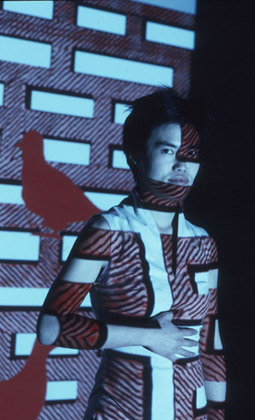
Chi Vu
photo Ponch Hawkes
Chi Vu
Migrant writing, as Sneja Gunew pointed out some years ago, is often shaped by nostalgia, that psychic force that requires the subject to return repeatedly to the place of origin in the hope of recovering an identity that connects body, self and homeland. For the child of migrants, or those whose own memories are immature, the remembered country is secondhand, more or less a product of their parents’ nostalgia. If she returns to that place as an adult visitor, she must put together the childhood stories lived on the inside with a jumble of new languages, rhythms and sights that represent a different outside.
The premise of Vietnam: a psychic guide is that Vietnam can only be an imaginary location, as seen through the eyes of a young Vietnamese-Australian woman writing postcards back ‘home’ to Australia. “The journey of importance is not the physical one. The real journey is in the heart and in the mind.” Written backwards in a strange red book that becomes her tourist guide, this instruction is given to Chi Vu by a postcard seller. Her departures, her returns, from the City of Lakes, Halong Bay, Café of Babel, Hanoi or the City of Face generate poetic rhapsodies that attempt to capture fleeting impressions, to take snapshots or make song like the melodic tune of the plain brown birds. Indeed this performance began as a series of prose poems published in Meanjin. Although now in a stylish theatrical production complete with multimedia projections, the vignette-like format remains as the postcards are delivered–winged through the air by 2 chorus members at the beginning of each scene. Received by her father, played by older Vietnamese actor Tam Phan, and Jodee Murphy, as best friend Kim, Chi Vu herself appears as the narrator or as other kinds of cultural transmitter-postcard seller, motorbike rider, train traveller, café customer. Through them she carries the action—of discovery and excitement—whereas the other characters re-enact this different Vietnam, or with Murphy’s mime-dance style, animate the sensations of this new world.
In this committed bilingual performance, I enjoyed the musical, sometimes competing, layers of Vietnamese and English particularly when Tam Phan sings like an old crooner in both languages. A Vietnamese spectator noted that the Vietnamese was antiquated, far from the contemporary mix of North-South dialects and popular expression one hears in postmodern Vietnam. Perhaps the script reflects the proper speech of translator Ton That Quynh Du—also a long-term Australian resident—or that of the older male actor and thus its linguistics stand in for the 1950s voice of the father that Chi Vu knows. Rather than visiting a new Vietnam, it seems that the text oddly revives a traditional symbolic order.
By way of contrast, the computer graphics (Ruth Fleishman) project abstracted images of ponds, birdcages, or Oriental architectures as iconic shapes that slide up or down or open like barn doors. They flatten the landscape, leaving more space for the gap between a Vietnam lost and a Vietnam reconstructed to appear. This place remains overly idealised, and although we witness a momentary electrocution and the old man swallowing papers, it is difficult to locate this trauma either in her father’s history or in the young traveller’s streetscape.
While there is much experimentation with form, the performance never breaks from the circuit of nostalgia. Its structural repetitions give us too many beginnings and the endings tail away. I wonder if more speed or intensity could be accumulated by seeing where one image collides with another or whether the messages from Vietnam could psychically and physically disrupt the neat separation of ‘home and away.’ As a writer Chi Vu commands a delicate poetic register but this production makes me think that for each generation of migrant experience, the Greeks and Italians in the 1980s or the Vietnamese in 2000, the pleasure of returning might always be left in deficit rather than in credit. Particularly unless writing becomes a theatre of the present.
Chi Vu, Vietnam: a psychic guide, text Chi Vu, director Sandra Long, North Melbourne Town Hall, Aug 22-31
RealTime issue #57 Oct-Nov 2003 pg. 30
© Rachel Kent; for permission to reproduce apply to realtime@realtimearts.net
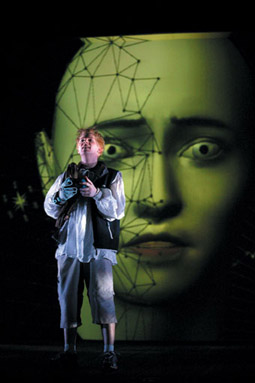
Cameron Goodall, The Snow Queen
photo Tony Lewis
Cameron Goodall, The Snow Queen
Windmill Performing Arts is an important new Adelaide-based national venture with international ambitions. The company’s Creative Producer Cate Fowler has had a long and significant history of creating and developing festivals and performances for young people in Australia. Fowler expertly brings together different creative teams for each of the company’s productions. The latest is a version of Hans Christian Andersen’s The Snow Queen celebrating the 200th anniversary of the writer’s birth. The concept for the show came from Wojciech Pisarek, the creator of the show’s virtual world, who writes, “The Snow Queen is a ruler of virtual reality and computer games rather than snow, frost and ice. We show 2 journeys and 2 different ways of gaining experience and knowledge. Gerda goes through the real world, Kay [a boy] through the virtual. It is not about which one is better, it is about a balance between them.” Based on his PhD research at Flinders University (see RT#52, p32 for a detailed account), “5 years of experimentation”, Pisarek says, “are to be tested for the first time in a commercial theatre production. The Snow Queen character is purely digital. Some characters will have both physical and virtual representation. All the 3D characters and the digital environment will run in real time–nothing is pre-recorded.” Pisarek describes this as “a scary exercise–we will have 2 independent computer set-ups to run the show, in case one crashes.” The Snow Queen is directed by Julian Meyrick, written by Verity Laughton, designed by Eamon D’Arcy and Mark Thompson, with music by Darren Verhagen. The eagerness of Windmill to engage with new technologies in works for new audiences is a sign of a healthy embrace of innovation.
The Snow Queen, Adelaide Sep 26-Oct 4; Sydney, Apr 22-May 9 2004
RealTime issue #57 Oct-Nov 2003 pg. 29
© Keith Gallasch; for permission to reproduce apply to realtime@realtimearts.net
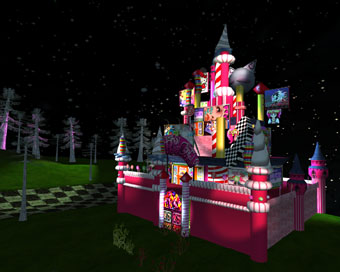
Anita Johnson, Underland
Brisbane-based Anita Johnson is a multi-disciplinary artist working with new and old media. With a background in graffiti, illustration and music videos, she has been integrating these formal and vandal art styles into contemporary and interactive videogame technologies. Curious about “faerytale vs impossiblity”, her work “re-contextualises (un)familiar fragments into virtual (3D) pop culture nightmares and wonderlandesque daydreams.” In June 2003, she participated in a candy-themed residency in Canada, where she began development of the first in her Underland series, an immersive 3D adaptation of Hansel and Gretel. Underland is currently being developed into an online 3D environment filled with secret lands; the next instalment will be launched in early October, 2003. Johnson is temporarily based at The Banff Centre, in Canada, where she is collaborating with a team to develop educational science toys.
http://anitafontaine.com/content/
RealTime issue #57 Oct-Nov 2003 pg. 29
© RealTime ; for permission to reproduce apply to realtime@realtimearts.net
Multi/inter/cross/hybrid are notions that intrigue and drive the work of Brisbane-based artist Luke Jaaniste. Having explored and experimented with diverse artforms, contexts and media since graduating in musicology from the Queensland Conservatorium in 1999, Jaaniste’s practice traverses the fields of sound installation, performance and public art. He has created work for concert hall, radio, CD, gallery, theatre, public sites and festivals using a broad range of materials including acoustic instruments, digital media, text, video, found objects, sculpture and the human body. Recent works have been presented at Small Black Box, a sonic performance event at the Institute of Modern Arts, and the Datum Video Show at Metro Arts. Jaaniste also co-directs the national composers group COMPOST, collaborates with Julian Day as juaanellii, and is currently Composer Affiliate with the Queensland Orchestra. The idea of space is central to Jaaniste’s PhD research in Creative Industries at QUT, which he began this year. “My key term at the moment is ‘making space’: physical, sensory, corporeal space, and cultural or communal space. Not ‘filling space’, which is a compositional notion (image within a frame, sculpture in a space, plot within a story, words on a page) but something more positional in actually composing the frame.” Jaaniste extends this approach to making space in his public and corporate work and in his many advisory roles in the industry: “I really enjoy thinking and discussing and planning on a policy development and ‘big picture’ level, and see that part of my future practice will be teaming up with others to make space for artistic practice to grow and flourish.”
RealTime issue #57 Oct-Nov 2003 pg. 44
© May Ann Hunter; for permission to reproduce apply to realtime@realtimearts.net
Looking around and not really knowing where to find new documentary filmmakers (even though, I realise now, they’re all around us, except I don’t always think of them in that way—new/old etc—I mean, does that really matter?) I’m introduced fortuitously to a new series of half-hour documentaries on SBS called Inside Australia. All new directors, several with little or no broadcast or filmmaking experience, and a determined push to put them up the front of the schedule—7pm on a Sunday. What could be better? Let’s see…
Meet George from Aurora Scheelings’ The Trouble with George (the first film on the schedule) except he’s not really trouble, he’s a delight, albeit maddening, infuriating, a handful, 2 handfuls even. George is 81 with the mental age of a small child. Brian finds him living in a bus shelter so he takes him home to his wife, Jennifer, and they look after him. Now, several years on, Brian and Jennifer have parted but Jennifer is still caring for George. “Why?” you might ask, as this film does. George is a character but you know he’s hard work-imagine an irascible old man with a toddler’s temperament-although you can also see why he’s still with Jennifer after all this time. It’s an unusual relationship, partly mother/child but also one of companionship and mutual need, an irresistible emotional call and response. The film’s strength is that it makes sense of it all without wrapping it up too neatly–in the end, we don’t really know what will happen to George and Jennifer but that’s okay.
In Me Me Me and ADHD, directed by Shelley Matulick, Ben is a 21-year old with, that’s right, ADHD—he’s practically bouncing off the insides of my TV, so much energy pouring down the tube. Not that Ben is going down the tube, he’s right there dead centre—I mean, of course, there’s a documentary being made about him-who else? His family are there too, although rather more battle weary and circumspect. They don’t really come alive to the same degree as Ben but that would be hard to do anyway (only the boy who lives down the road, also diagnosed with ADHD, comes close). The film works because it doesn’t try to airbrush ADHD but manages, mainly, to show what it’s like to live with it on both sides, inside and out.
Disturbing Dust (director Tosca Looby) is a very ordinary story in that it is about a woman, Robyn Unger, dying of cancer, an everyday occurrence for somebody, somewhere, and something that is oddly banal for all its awfulness. In this instance, Robyn has mesothelioma, which she contracted as a result of handling asbestos sheeting 25 years earlier. There’s understandable anger that an activity as innocent and matter-of-fact as building a house should lead to such painful consequences decades later, but it’s to the credit of everybody involved that this outrage doesn’t obscure the central, inevitable process of somebody dying with whatever dignity is allowed. In one scene, Robyn farewells her work colleagues who, watch wide-eyed and dumbfounded by what’s happening, even as Robyn chats matter-of-factly about her cancer. At times, Robyn and her husband, Peter, appear incongruously cheery as they prepare for death, in the manner of people trying to jolly themselves along in the midst of great pain because the alternative doesn’t bear thinking about.
There’s nothing lightweight about these topics and the rest of Inside Australia promises more of the same but on the evidence of the first 3 episodes, the effect is undeniably positive. It’s continually amazing–what people can do—and this is something the directors all seem to recognise and value. The episodes are pacey and taut as befits a half hour slot, no gradual unfurling or leisurely settling in-the subjects fill the space and the screen and the immediacy is an obvious counterpart to the intimacy between the directors and their protagonists. The filmmakers are savvy, as are the subjects.
Obviously, in half an hour, there are going to be elisions and lacunae–you sense there must be more to George and Ben and Robyn and their situations (there are hints of this in the films anyway)—but I guess we’re mature enough now in our viewing to understand that this is television and half an hour with these people is far, far better than nothing at all.
The 3 opening episodes, for all their differences, document the pressures of living together today, especially when those pressures are intensified by specific challenges; Inside Australia, in this instance, means indoors, in the family home, and the dramas played out in bedrooms and kitchens. Other episodes promise to take us outdoors, but the focus remains tight-individuals, families, small communities-as if these are the basic units with which to build an understanding.
‘New’ documentary, in this instance, means staying close to home and watching the daily dramas of people trying to get by in the extraordinary everyday. Perhaps these documentaries are a reaction to the seamless gloss of ‘lifestyle’ and faux reality where a simple makeover can seemingly make everything okay. Undoubtedly, too, it’s easier logistically to make these ‘home’ movies, especially for first-time directors. ‘New’ means something well-formed but fresh, a personal engagement that doesn’t necessarily equal ‘SBS documentary’ but ends up there anyway. It takes a fair bit of passion to make documentaries this way-why else would you do it?–but the results speak for themselves.
Inside Australia was commissioned at SBSi by Commissioning Editor Marie Thomas who is upbeat about the state of the documentary as exemplified by the directors in this series: “At the moment I think Australians have every reason to be positive about their industry. I think that it is on the move and we are on the crest of a new wave of creativity. Certainly at SBSi we feel that we have been allowed to renew our remit to invent and change. I sense that the industry is loosening its stays. There are a host of really bright, committed new filmmakers out there-under 35, full of fight, ideas and attitude. Just what an industry needs to thrive.”
Directors mentioned by Thomas as the ‘tip of the iceberg’ (not just new but emerging talent) include Aurora Schellings, Emma Crimmings, Melanie Byres, Zane Lovett, Kate Hampel, Shelley Matulick, Rebecca and Jonathon Heath, Sean Cousins, Tosca Looby, Faramarz K-Rahber and Anthony Mullins and producers Melanie Coombs, Anna Kaplin and Celia Tait.
The challenge now is to ensure that the ‘new wave’ translates into something sustained and sustainable for these directors, with enough impetus, perhaps, to push them toward more, bigger and better projects. Thomas believes that the local documentary scene has been playing it “a bit safe” lately, leaving it to overseas sources to develop new forms and reinvigorate old ones. “Worst of all, this conservatism isn’t bred by lack of funds. That’s fumbling with fig leaves. We’re the cause of it. Filmmakers and broadcasters alike,” she says.
“When I arrived in Australia, I was fresh from the frontline of the terrestrial UK market where a lot of the broadcasters’ time is spent considering who will watch and why, balancing ‘should-be-made’ with ‘it’s-what-they-want’ programming. On my arrival, I was shocked by the ‘bugger ‘em’ attitude towards the viewer that I found amongst filmmakers here. It seemed so counter productive.
“First and foremost, television is a medium that needs to be watched in order to be effective and second, we are dealing with viewers who have been watching television for half century and documentary for longer than that. To assume they can’t make informed choices seems to me to be arrogant. Good ratings don’t equal dumbing down-and yet that was the regular war cry I heard from all around.
“Recently SBSi and the independent sector have been given the thumbs up by the channel’s television management. Ned Lander, Senior Commissioning Editor, and I have been told to give our TV instincts and new ideas a go-ideas that perhaps a year or 2 ago may not have been seen to be fitting or ‘the thing’ for the channel to do. Personally I feel that we are being allowed to open the door to new players and fresh content and being given the opportunity to widen the vernacular of documentary output. From now on, programs can come in different shapes and sizes, as will budgets. We have been given the opportunity to play with light and shade in the schedule.”
Inside Australia isn’t going to change the scenery overnight but it is a good start. Stay tuned.
Inside Australia Sundays 7pm, SBS from October 12
RealTime issue #57 Oct-Nov 2003 pg. 16
© Simon Enticknap; for permission to reproduce apply to realtime@realtimearts.net
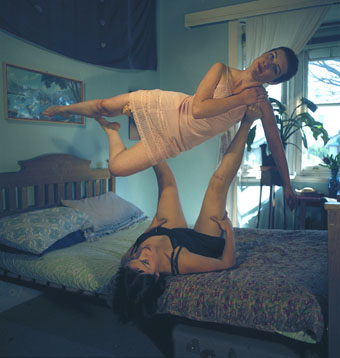
Madeleine Donovan, Bedroom Acrobatics
Madeleine Donovan has performed in several Australian circuses and this year worked with the Womens Circus in Ghosts at the Melbourne Docklands. Her photographs featured in the 2002 Summer Salon at the Centre of Contemporary Photography, Melbourne. Based in Canberra, she is studying honours at the Australian National University School of Art and is a circus and physical theatre trainer/director with Canberra Youth Theatre.
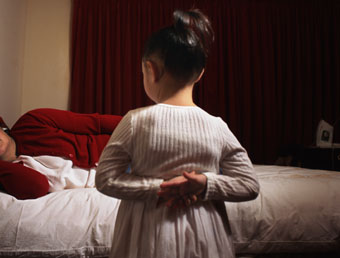
Koky Saly, Untitled, lambda print from series How Much longer Will You Live Like This 2003/2004
Koky Saly is a Melbourne-based photographer who documents her Cambodian community. The series was shown at We Call This Paradise, First Site Gallery, Melbourne in August this year. Saly was awarded the Gabrielle Emma Hayne Memorial Award acquisitive prize for great potential in photographic art in 2002 and in 2001 was named Student of the Year in the Experimental Category by the Victorian Institute of Professional Photography. She is an honours student at the Royal Melbourne Institute of Technology.
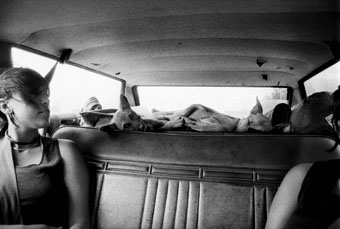
Tamara Dean, from series Friends
In 2003 Tamara Dean’s work was selected for Art and About, an outdoor photographic exhibition of emerging and established artists in Sydney’s Hyde Park–and shortlisted for the 2003 Josephine Urlich Portrait Prize. Based in Sydney, Dean is a staff photographer for The Sydney Morning Herald. Friends was shown in Reportage, Sydney’s annual photojournalism festival, 2001.
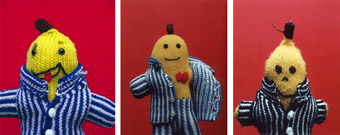
David Wills, B3, 18 images of handknitted Bananas in Pyjamas found in Op shops, garage sales and markets
David Wills, from B3, 18 images of handknitted Bananas in Pyjamas found in Op shops, garage sales and markets.
David Wills has had several solo shows, most recently Bird Fancier at First Draft, Sydney 2003. His work has featured in numerous group exhibitions including Amnesty International's Faces of Hope at Womad, Adelaide in 2003 and Proximity at Chrissie Cotter Gallery in 2002. He is studying honours in visual art at the Australian National University, Canberra.
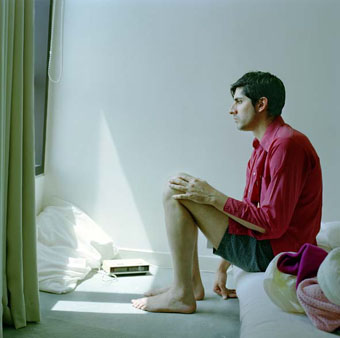
David van Royen, David from series him self, CCP, Melbourne 2002
David van Royen’s clutch, gear and silence series (video and still prints) was exhibited at West Space Gallery in 2002 and features in the latest issue of Photofile. Based in Melbourne, van Royen did an undergraduate diploma and Honours at Royal Melbourne Institute of Technology where he is completing a Masters in media arts.
RealTime issue #57 Oct-Nov 2003 pg. 35-36
© RealTime ; for permission to reproduce apply to realtime@realtimearts.net
Every year at this time we survey new work. Since 1999 our focus has been on new media arts both onscreen and performative. For 2003 we’ve taken a bigger, bolder step, selecting over 100 artists from all fields, mostly in their 20s, the majority working in the small to medium arts sector, their work exciting us, our contributing editors and writers. What is striking about these artists is their often direct, sometime provocative engagement with the world, the ease of their deployment of new media and the capacity to generate hybrid practices, and not a few adopt intriguing personae.
Any selection on this scale and across huge distances is necessarily impressionistic, and print space limits the number of new artists, companies, venues and events we can cover. However, beyond the artist/company profiles (a mix of critical appreciations, self-penned biographies and brief reviews) you’ll find more key names in reports on new filmmakers (p15,16), emerging film producers, the Time_Place_Space hybrid performance workshops (p28), and the recently opened Primavera at Sydney’s MCA (p21). Some of the new companies are ventures established by experienced art workers (Windmill, p29), some new works represent a mature artist (like Greg Leong, p29) moving in a new direction. Some regionally-based artists have been included but we’ll survey more in a forthcoming edition.
Although we’re surveying the work of young artists (a remarkably flexible category that has run up to 35 years of age for novelists since the advent of the Vogel Australian Literary Award decades ago) we don’t analyse the impact of youth arts policies as developed by the Australia Council and some state governments. We’ll do that at another time. However, even a casual reading of the artist profiles will tell you that there has been growing support for young artists, not big money but siginificant incentives, like the Australia Council schemes, Write in your face, Start you up, 2 EXCITE-U and Run_way (p24), along with various state government programs, Asialink grants and the many opportunities in film provided by the Australian Film Commission and state-based programs, like the NSW FTO Young Filmmakers Fund. Larger scale opportunities come via the likes of Samstag fellowships (Astra Howard, p14) and the Helen Lempriere Traveling Arts Scholarship (Paul Cordeiro & Clare Healy, p8) which have contributed enormously to the development of young artists. Often young artists gain most support from working with established practitioners in formal or informal mentoring relationships, or by being offered opportunities within companies, for example choreographing for the likes of ADT’s annual Ignition season or as part of the Australian Choreographic Centre program, or through the support of an artists’ collective (Christian Bumbarra Thompson and Boomalli, p40).
Putting SCAN 2003 together has been a challenging and exhilarating task. Thanks to our editors and writers and all the artists who responded to this opportunity to register the breadth and complexity of new Australian art. RT
–
RealTime issue #57 Oct-Nov 2003 pg. 3
© RealTime; for permission to reproduce apply to realtime@realtimearts.net
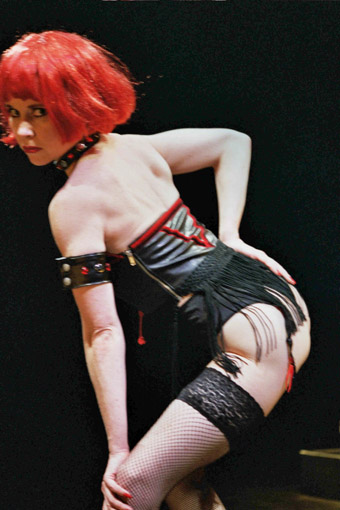
Wendy McPhee, Private Dancer
Q: How do you subvert a strip show?
A: Start nude.
Performed on a traverse stage, with a lucky wheel at one end and a changing room at the other, Wendy McPhee’s Private Dancer exists somewhere between an RSL and a sex club. Through a series of episodes and costume changes that highlight the ways we dress flesh, Private Dancer explores the commerce and social construction of female sexuality.
One of the first acts McPhee performs is a faux-lucky number spin-the-wheel sequence designed to split the audience according to gender. By the end McPhee is situated in the middle of a literal divide between the women and the men. From where I sat Private Dancer became a performance about women looking at men looking at the dancer. Men of all types, the beaming man, the gum-chewing guy, the old bloke who had to retrieve his glasses in order to read the instructions McPhee gave him and the young guy who, after slow dancing with McPhee, gave his female partner an apologetic shrug from across the room. Not that McPhee neglected her female audience: in one of the few moments of vulnerability performed to a cyclical voiceover she engaged them literally as her hand trailed across the front row of women.
The performance created a tangible complicity among the audience—both women and men wisecracked across the divide. In one sequence McPhee remained off-stage while each audience watched separate TV monitors. While our side laughed loudly at bad jokes like: “How do you know when your wife’s dead? The sex is the same but the dishes pile up”, the men stayed surprisingly silent. When one of the women snuck over to the men’s side and reported back that they were watching porn, the incongruous silence resonated.
Private Dancer is particularly successful as a demonstration of how the female body is packaged. With the nude sequences performed under full houselights, McPhee’s deathly pale flesh became a costume of its own. In a performance that employs masks of all kinds her commedia dell’arte-like dildo seemed highly appropriate. McPhee’s work may not be particularly radical (compared to someone like Annie Sprinkle it seems relatively tame), but there are moments where her particular blend of cabaret, dance, burlesque and striptease generates a unique experience for the audience.
Private Dancer (episode 2), softcore inc. in association with the Judith Wright Centre of Contemporary Arts & QUT Creative Industries, creator & performer Wendy McPhee, director Mary Sitarenos, designer Ina Shanahan, sound Myles Mumford, Judith Wright Centre of Contemporary Arts, Brisbane, September 10-11
RealTime issue #57 Oct-Nov 2003 pg. 47
© Leah Mercer; for permission to reproduce apply to realtime@realtimearts.net
For the past few years, para//elo has been engaged in a series of collaborative projects with European artists on the theme of distance. These have included workshops, email conversations, a website, and sound and video compositions, culminating in the “live art experience”, In the Time of Distance. The Victorian-era Queen’s Theatre in Adelaide, little more than a heritage-listed shell of its former self, was transformed by James Coulter’s installation into an intimate and immersive space. Video projections covered most of one wall, soundscapes (by Scanner and Jason Sweeney) emanated from the opposite side of the venue, while a bar, computer monitors and television screens (peeking out from 1950s petrol pumps) completed the eclectic setting for this multi-faceted work.
The audience, seated on couches and chairs, were scattered around the centre of the venue. Performers moved freely through the audience, stopping occasionally to quietly impart fragments of the text (“days like this the simplest things fail to make sense”). Lines were delivered into microphones at the front of the space, with the audience hearing them from speakers at the rear. Hypnotically looped images, sounds, text and movement shifted slightly through every iteration, states of being changed gradually so that it was impossible to distinguish where one ended and another began. These techniques evoked the feeling of being inside someone’s head, their thoughts and memories washing over you, varying from lyrical evocations of a remembered Eden to chanted propaganda: “Be wary! Distrustful! On guard!”
One central theme of the performance was the nature of the migrant experience—alienation from the original culture, and from the new. Much of the subject matter depicted emotional responses to the changes brought by distance, especially those journeys that were forced or undertaken with mixed feelings. When emotions this fundamental to our nature are explored, some truths that result are necessarily banal, but no less true for our having heard them before.
In the Time of Distance was a lament, an evocation of the injustices of the past and present without offering more than a glimmer of hope in the future. Remembered stories of rape, torture, forced dispossession and imprisonment unsettled the audience and darkened the mood. This was a confronting and thought-provoking work distinguished by strong performances from Elena Carapetis, Irena Dangov, Astrid Pill and Jason Sweeney.
para//elo, In the Time of Distance, co-directors Teresa Crea, Laurent Dupont, installation James Coulter, soundscapes Scanner, Jason Sweeney), live image manipulation Lynne Sanderson, photography Peter Heydrich, Queen’s Theatre, Adelaide, Sept 4-13 http://www.parallelo-distance.net
RealTime issue #57 Oct-Nov 2003 pg. 47
© Ali Graham; for permission to reproduce apply to realtime@realtimearts.net
Being nothing and everything Told via her clown-dag persona, Donna Carstens’ Thirty Years In a Suitcase is a litany of the trials of growing up as a girl who looks like a boy in the straight world of Brisbane suburbia circa 1980s. This one-woman show is about “not being black, not being white, not being gay, being forgotten, being remembered, not being funny, being nothing and becoming everything you ever wanted to be.” It is ultimately a feel-good story and Carstens knows how to charm an audience and keep them on her side.
In 2000 Carstens received a Lord Mayor’s Fellowship Grant from the Brisbane City Council and made her first international trip to study with several international artists (at the Del’Arte International School of Physical Theatre in San Francisco and festivals in Geneva and Frankfurt). This travel provides the light frame upon which she places her autobiographical story told as a series of flashbacks. Combining family snapshots, shadow puppets, juggling, the strategic use of music (including an unforgettable performance of Desperado on ukulele), Thirty Years In a Suitcase unfolds through a series of narrated stories and Carsten’s interaction with several suitcases that take on different roles.
The show doesn’t shy from the bleaker side of her life including Carsten’s initial estrangement from her mother after coming out, the domestic violence that shaped her mother’s childhood and the revelation that her grandmother, who was jailed for murder, was one of the Stolen Generation. Helped by its hometown audience whose recognition of local places helps to win them over, Carstens’ style of storytelling is direct and heartfelt.
Thirty Years In A Suitcase, Donna Carstens with Metro Arts, co-director/sound Tamsin McGuin, puppeteer Lynne Kent, lighting Veronica Joyce, projection Amanda King, audio Guy Webster, Brisbane, Aug 27-Sep 6
The project was part of MetroArts' The Independents program supporting emerging and fringe artists.
RealTime issue #57 Oct-Nov 2003 pg. 47
© Leah Mercer; for permission to reproduce apply to realtime@realtimearts.net
There are 2 things you can’t afford to miss in Robyn Archer’s 2003 Melbourne Festival—a small cluster of important overseas works and a huge range of great Australian dance. For RealTime readers, top of the list of must-sees will be provocative artists with long track records and the capacity still to unnerve, excite and to rethink form. They are Belgian performance-maker Jan Fabre with I am Blood, A Medieval Fairytale, and, from Japan, multimedia performance virtuosi Dumb Type in Memorandum. Both have been seen in Australia before—Adelaide audiences walked out in droves or dared not go near Fabre’s The Power of Theatrical Madness in the 1986 festival (allowing others of us repeated viewings of great art understood as barely controlled violence) and Dumb Type packed us in at Sydney’s MCA in 1992 with pH where we peered down into a deep pit to watch a machine churning out projections, relentlessy traversing the space regardless of its hapless human co-habitants.
One-time Pina Bausch dramaturg, the performer, writer and choreographer Raimund Hogue triggers 60s recall using popular and classical music in the 2 hour reverie, Another Dream. Those who have seen Hogue in Edinburgh, and queued to see him again, warn us not to miss this show. Another Edinburgh attraction has been solo performer (and Robert Lepage collaborator) Marie Brassard in her cross-gender realisation, Jimmy, which she is presenting in this festival. A third solo, performed in an installation by Vera Rhom, comes from Catalan dancer and choreographer, Cesc Gelabert, in his reconstruction of the late German choreographer, Gerhard Bohner’s acclaimed In the (Golden) Section 1.
From the Schauspielhaus Vienna (see RT#56 p8) comes Barrie Kosky’s The Lost Breath, performed in English, German, Hebrew and Yiddish. The work brings together 3 stories by Franz Kafka, the reflections of escapologist Harry Houdini and the Robert Schumann song cycle, Dichterliebe in a music hall fantasia with Kosky himself on piano. Many will want to see what new dimensions there are to his work now that he’s based in Europe—and hot on the heels of his huge success with Ligeti’s Le Grande Macabre for Berlin’s Komische Opera.
From France, as part of the Franco-Australian Contemporary Dance Exchange, which last year showed Chunky Move, Gravity Feed, Rosalind Crisp and Tess de Quincey to Parisian audiences (see RT#53, p4-7), there are 3 works. Centre Choreographique National de Franche-Comte a Belfort present Trois Boleros, choreographed by Odile Duboc. Yes, that’s Ravel’s Bolero danced 3 times, to 3 different orchestral interpretations. Using acrobatics, dance and film, the young performance company Kubilai Kahn Investigations evokes the agony of the refugee and the homeless in Tanin No Kao. From Burkina Faso in West Africa comes Salia Ni Seydou, fusing traditional and contemporary dance, song and percussion.
On the Australian front, there’s much to relish. Archer gives top billing to Acrobat, all too rarely seen in Australia these days, the Australian Dance Theatre’s prize-winning The Age of Unbeauty, Chunky Move’s new work, Tense Dave (“as the stage turns, [the characters] are caught in the spotlight of unexpected scrutiny, performing acts that usually pass unseen”), the Leigh Warren-State Opera of South Australia realisation of Philip Glass’ Akhenaten and Stalker Theatre Company’s Incognita.
The key festival dance figure though is Lucy Guerin. Involved in 3 works in the festival, she is directing and choreographing Plasticine Park, a collaboration with visual and new media artist Patricia Piccinini; choreographing Delia Silvan’s performance in Stravinsky’s The Firebird (Melbourne Symphony Orchestra); and co-choreographing the Chunky Move premiere. Plasticine Park will be presented in ACMI’s Screen Gallery with 8 soloists working in projected spaces created by Piccinini, Stephen Honegger, Laresa Kosloff and David Rosetzky. Let’s hope that this festival commission is a prelude to more new media performance at ACMI.
Other Melbourne-based dance and performance works in the program all deserve attention. At the Malthouse’s Beckett Theatre, there’s a strong triple bill from Gerard Van Dyck (Collapsible Man), Christopher Brown (the return of his charismatic mass media idiot savant, Mr Phase, RT#49 p11) and Cazerine Barry (in her the new media dance theatre work, Sprung recently premiered in Adelaide). Choreographer Christos Linou and visual artist Robert Mangion screen their CBD interventions at fortyfivedownstairs in part 4 of their Intertextual Bodies series. At the same venue, Yumi Umiumare and Tony Yap, whose duets have developed impressively in recent years, appear with their new, unpronounceable Butoh company, “_”, design by Michael Pearce, in in-compatibility. Phillip Adams’ Balletlab always intrigues. In Nativity, at Dancehouse, the company invokes the museum diorama as a site for exploring the human/animal dichotomy. In another work about transformation (“from animal to angel, from gremlin to diva”), also at Dancehouse, the wonderfully inventive and idiosyncratic Ros Warby presents SWIFT re-frame, with design by Margie Medlin. At North Melbourne Town Hall, Kate Denborough directs Kage Physical Theatre in the premiere of Nowhere Man. a timely journey into the loss of meaning —“the story of an ordinary man’s transformation, where nothing feels familiar.” At the Atheneum II, Danceworks are celebrating 20 years of work with Symptomatic, which reads like a good companion piece for Nowhere Man—“characters struggle to negotiate competing demands on mind and body, never quite getting it right.” Transformation and breakdown are tellingly recurrent themes in these and other festival works, with bad old Humanism continuing its struggle to reassemble itself and the neuropathology of everyday life paralleling the distress of political disorientation.
Archer’s 2003 festival is a celebration of dance and movement. While it cannot make up for the sorry lack of a recurrent national dance festival, and can but hint at the range of Australian dance, it nonetheless does a mighty job. The vision of dance is enlarged by the inclusion of curator Erin Brannigan’s Body on Screen program. On screens inside ACMI and outside in Federation Square, the program ranges from Maya Deren’s innovative short films and Leni Riefenstahl’s Olympia to Singin’ in the Rain, to films about the body at its performative limits, the disappearing body, the body as narrator and, in Body of Work, leading international and Australian choreographers as filmmakers. The program also premieres Michelle Mahrer and Nicole Ma’s Dance of Ecstasy, complementing the visit to Australia, and this festival, of the Whirling Dervishes. And there’s more, a series of forums providing dance artists and afficionados from across Australia the opportunity to meet for serious dance discussion.
There’s a 90 minute symposium on drama and dance in Asia (featuring members of Dumb Type and Cloudgate’s Lin Hwai-min), a 3 day forum on skills and choreographic training and the future of dance in Australia, and a day long “research forum on contemporary dance and choreographic cognition.” The Australian Indigenous Choreographers Project will bring together Australian and Asian artists. As well there are workshops with Kubilai Khan Investigations, Odile Duboc, Salia Ni Seydou, Cesc Gelabert, Chunky Move and Raimund Hogue. Not performing in the festival (a real pity), but running workshops are Sydney artists Tess de Quincey, Gravity Feed and Rosalind Crisp. Add to this a number of key dance presenters from around the world invited by the Audience & Market Development Division of the Australia Council and you have what adds up to a potentially significant moment for Australian dance.
There’s more to the program in music and theatre and works-in-progress. The visual arts program looks strikingly empathetic to the festival’s body theme. Last, but not at all least, there’s Neil Thomas and Katy Bowman’s The Blue Thong Club (Black Box, Arts Centre). From the Museum of Modern Oddities curators comes this “late night demi-monde”, a club where the likes of Paul Granjon (“hair technologist”), Paul Gazzola (“live art meister”), The Fondue Set, improvisers and dance artists will entertain and mingle in the context of the world’s “second largest collection of thongs.” Away from this nightly live art haven, the festival opens and closes with big public dance events. David Atkins will teach the steps, en masse, for Singin’ in the Rain on the opening night, and, on closing night there’s Bal Moderne, a well-tried European success, an evening of mass choreography at the Melbourne Royal Exhibition Building. You learn dances by Lucy Guerin, Kate Denborough and Gideon Obarzanek. This is a festival where you can see dance, talk dance and dance yourself silly.
Melbourne International Festival of the Arts, Oct 9-25, www.melbournefestival.com.au
RealTime issue #57 Oct-Nov 2003 pg. 46
© Keith Gallasch; for permission to reproduce apply to realtime@realtimearts.net
For the past 5 years hybrid video artists Mark Cornelius and Dianna Graf have been incorporating fine and digital arts to produce installations, sculpture, 8 and 16 mm film and computer animation for solo and collaborative projects. Their projects have included work with IHOS Opera (The Rapture, 1999, Tesla-Lightning in His Hand, 1999), Terrapin Puppet Theatre (Succulent, 2001) and in 2002 a 5-minute film, Thibaud and the Red Violin, for SBS Independent, which will be broadcast in 7 countries later this year. They both exhibited new media installations, Anxiety and Luminae, respectively, in a group show with Matt Warren and Sean Bacon, Immediate, (Plimsoll Gallery 1999). In 2000, an interactive digital collaboration from this show was exhibited in Stockholm and Belgrade. Cornelius has produced video and film installations, Somnambulistic Vision (1998) and Three Worlds (Hobart Centre for the Arts), working with Matt Warren who created soundscapes. In her solo work, Graf has primarily created immersive sculptural environments using film, video, sound and custom fragrance, produced with Jonathon Midgely of Damask Perfumery: Something Old, Something Red, Something Borrowed, Something Dead (1997) and Be Brave (1998). Cornelius and Graf are currently producing a short animated film with Tom Samek. Their work has been widely exhibited in Hobart and Brisbane, and internationally. illuminati explore the synthesis of art, science and technology in works examining hypnosis, illusion, history and fear.
RealTime issue #57 Oct-Nov 2003 pg. 45
© Sue Moss; for permission to reproduce apply to realtime@realtimearts.net
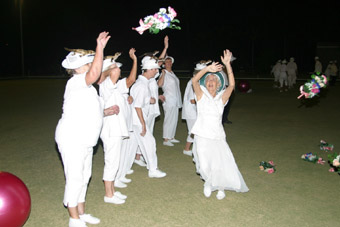
Tracks, A Bowls Club Wedding
Darwin audiences have been thrilled and uplifted by A Bowls Club Wedding, a recent production of TRACKS. Featuring the Grey Panthers, an older women’s performance group, this raucously amusing theatrical entrepot of song, dance and music enjoyed a sell-out season during the 2003 Darwin Festival. A Bowls Club Wedding successfully courted new audiences by using a local landmark as its venue–the historic Darwin Bowling Club. A humble example of 1960s architecture, this clubhouse has withstood the test of time, fashion and recent threats of development proposals. The undercover clubhouse patio provided the perfect setting for the quintessential Australian wedding function—including lewd telegrams, cocktail onions and a bouquet snatching flower girl—to transport the audience back to another time. The production used the adjacent bowling green as a counterpoint to the familiarity of the wedding reception antics. Flooded with light and choreographed to emphasise the grace of bowling, the green was used to depict the strategic bowling manoeuvers, intense club rivalry and in the case of the happy couple, the conquest of the heart over bowling club alliances!
A Bowls Club Wedding melded the polished performance talents of the Grey Panthers, with new and emerging Darwin dance artists, Joshua Mu, Julia Quinn, Mark Taopo and Byron Low. The pulse and verve of these young dancers juxtaposed with the grace and charm of the Grey Panthers created a work where dance, in various genres and forms, took centre stage.
From a spontaneous participatory audience round of the Pride of Erin to the unified glide of the Bridal Waltz by bride and groom (Audrey Gorring and Kevin Gould) all proceedings seemed well in hand. However, the happy couple was soon usurped by a lasciviously and technically adept tangoette performed by the self-absorbed flower girl (Julia Quinn) and debonair groomsman (Joshua Mu). Then, the pageboys turned proceedings upside down by dancing on tabletops, thrilling the audience with spins and gyrations as the wedding function lost all sense of decorum. Nonetheless the Grey Panthers made the point that they too can thrust, with bust and with dancers young enough to be their grandsons.
Dueling MCs gave some sense of order to the proceedings. Representing the Mindil Monitors—the bride’s club—was the taciturn Lori (Gail Evans). Officiating on behalf of the groom’s club—The Top End Terrors–was the bumptious Gil (Yoris Wilson). Throughout proceedings they vied for the “top” position with gags, putdowns and sly remarks threatening to overstep the competitive mark and destroy the newlyweds’ happy day.
It was the contrast between young and old–dance of the past and dance of present—that gave A Bowls Club Wedding its distinctive edge. With comedy and wit, different generations were united through the dance styles that mark their era, conveying the continuum of dance as a social form of expression and enjoyment. A Bowls Club Wedding was well received by Darwin audiences. The “dancing grannies” and “grunge ’n groove grandsons” made a potent cocktail that left its audience with a mellow afterglow.
A Bowls Club Wedding, TRACKS & the Grey Panthers, director & choreographer David McMicken & Tim Newth, Darwin Bowling Club, Aug 14-24
RealTime issue #57 Oct-Nov 2003 pg. 45
© Joanna Barrkman; for permission to reproduce apply to realtime@realtimearts.net
Perth is a city of skyscrapers that closes down almost completely after 5pm. Wandering the dead heart of its central business district may have provided the stark inspiration for Sam Fox, a young choreographer and creator whose most recent work to date has combined dance, music, and digital animation on the rooftops of Perth’s multi-storey carparks. The Tall Concrete Project premiered at the Artrage Festival in 2002, taking advantage of the deserted, open-air stages of the city. This collaborative work juxtaposed, improvised and prepared movement against the fractured glass skyline, accompanied by live electronic music and projected chaotic images of technology jarring against the body. Fox has recently been accepted into a mentorship program—through the Australia Council and Youth Arts Queensland he will undertake a 9 month professional creative development with Marcus Canning, the Director of Artrage. His work will focus on the development of a new hybrid performance, Concrete Junction, with his collaborators in the Tall Concrete Collective for the Midland, Urban Edge Festival, as well as the delivery of a program of contemporary performance at Artrage’s Black Box space. Fox’s pursuit of hybrid, movement-based theatre is grounded by a short, yet action-packed career. His education in different art forms began with a certificate in music theatre. Fox has performed works by artists and companies as diverse as Sue Peacock, Derek Kreckler and Kompany Kido, and choreographed Public Jargon as an emerging artist with STEPS Youth Dance Company for their season, Movement Safari.
RealTime issue #57 Oct-Nov 2003 pg. 45
© Bec Dean; for permission to reproduce apply to realtime@realtimearts.net
Paul Zivkovich is a wonder to watch. He flies. He is unafraid. He’s got something to say, and not only as a dancer but now as an emerging choreographer. Born in Canberra, Zivkovich trained as a gymnast for 4 years and in 1999, aged 16, he began to dance with The Australian Choreographic Centre’s Quantum Leap Youth Choreographic Ensemble, as well as performing in Luke Hockley’s Folding On Forever. Last year Zivkovich completed his studies at Queensland University of Technology where he worked with choreographers such as Csaba Buday, Tiina Ali-Haapala and Anna Smith. During this time he also danced with Opera Queensland and appeared on singer Darren Hayes’ video clip Crush 1980 Me. This year Zivkovich joined the Australian Dance Theatre as guest artist to perform in Nothing, choreographed by Garry Stewart for the Womad Festival in Adelaide, and The Age of Unbeauty for the Adelaide season and Melbourne Festival. Circling back to his Quantum Leap roots, he is now commissioned emerging choreographer for The Australian Choreographic Centre (and the first Quantum Leaper to do this). Zivkovich choreographed The Pull of Weight for Quantum Leap’s season Out of Bounds at the Canberra Theatre Centre’s Playhouse in July/August. This delicate and sensitive moment of grace, near stillness, but with all the gravitas of knowledge, was beautifully rendered for and by the boys of the ensemble. It shone like a jewel, spoke volumes: there go I.
RealTime issue #57 Oct-Nov 2003 pg. 45
© Francesca Rendle-Short; for permission to reproduce apply to realtime@realtimearts.net
When Experimenta director Liz Hughes and House of Tomorrow executive producer, Serafina Maiorano, visited the Perth Institute of Contemporary Arts in June this year, Tan Teck Weng’s work was showing as part of the Hatched National Graduate show. After some hasty negotiations, Teck’s gaming consoles, collectively titled Panopticon, have been included in the recently launched House of Tomorrow touring exhibition. Teck’s work deals with user interface and interactivity in both art and gaming culture. It is cleverly simple— constructing internal environments with some moving parts in tiny boxes that are recorded by an in-built camera and projected large, or connected to monitors with gallery environments. His boxes have an entirely functional aesthetic: they can be approached and picked up by viewers in many different ways, from gleeful abandon by enthusiastic children, to cautious and almost frightened anticipation by others. The ‘user’ in this case is able to “play God” (an apt description by critic Robert Cook) with the almost primal and childish motion of shaking the box. A recent graduate from School of Art, Curtin University of Technology, Teck is presently the web-master for the Biennale of Electronic Arts in Perth as well as working on some of his own web-based artworks.
RealTime issue #57 Oct-Nov 2003 pg. 44
© Bec Dean; for permission to reproduce apply to realtime@realtimearts.net

Greg Leong, JIA
photo Andrew Charman-Williams
Greg Leong, JIA
Greg Leong is an established textile artist and designer. His inaugural performance, JIA (home) emerged from earlier exhibitions which explored his Chinese-Australian background through interweaving fabric and personal story. JIA is an ambitious move with Leong writing, performing songs, designing Princess Feng Yee’s costumes—including an original Peking Opera brocaded gown—and producing graphics incorporated into a panoply of screened images.Via chitchat and song, and through the personae of Closet Princess Feng Yee, Leong traces the emotional and intellectual hazards of his journey from Hong Kong to Tasmania. Directed by Robert Jarman, Princess Feng Yee stars in her own karaoke cabaret, with a theatricality that jibes and japes at the crude and the cruel. The targets are obvious, including Pauline Hanson’s racism looking for a policy, and the incipient exclusion each of us practices at different times in our engagement with the unfamiliar. Princess Feng Yee sings I Can Rrrrreally Rrrrroll My Rrrrr’s and we all sing along with Rrrrr’s rolling enthusiasm, laughing and wincing as we recognise our complicity.
Leong’s journey resonates with other iconic Chinese-Australian figures from public life and the arts, including William Yang, Dr Victor Chang, Bill O’Chee, Annette Shun-wah and Jenny Kee. JIA can be read as an implied paean to the success of these figures. It also uses elements of Leong’s own journey, tracing family connection and memory. Feng Yee revisits the old country in order to find out what and who she used to be. We “might be common, dowdy and so, so white” but this doesn’t prevent Feng Yee’s eventual return to Tasmania where she finally learns to call Australia home.
JIA incorporates diverse visual concepts imagined and created by Leong with technical direction by Andrew Charman-Williams. The audience is constantly drawn to the screen, in some cases necessarily so, after all this is a karaoke cabaret. The dilemma is that even the sumptuous and irascible Feng Yee is at times overshadowed by the constantly changing images. There are some wonderful visual moments including a shift from dense Hong Kong tower blocks pixellating away until the screen resembles the weave of cloth.
Through his hilarious, jostling commentary Leong continues to reflect and refract our dependency on tired icons. Feng Yee teaches us a Cantonese version of Click Go the Shears. We might be able to roll our rrr’s, but we are all at sea with Cantonese script romanised for our enunciation. Point made. We are bloody hopeless, and helpless with laughter. JIA is like nothing else we have seen or heard. Then again neither is Princess Feng Yee, who taunts with her basso profundo voice and fascinating on-stage costume changes. The culminating sequence is the Asianisation of Tom Roberts. Leong’s and other Chinese faces are superimposed on the hairy and sweaty shearers in Shearing the Rams, a classic moment of ringer/ring-in cultural inversion.
Greg Leong, JIA: a tale of two islands, Annexe Theatre, Launceston, June 26, Institute of Modern Art, Brisbane, Sept 4-5, Nexus Multicultural Arts Centre, Adelaide, Nov 21, Midsumma, Melbourne, Jan 2004, Goldsmiths College, University of London, Feb 2004
Leong’s work can be seen at Gallery 4A, Sydney until Oct 19.
RealTime issue #57 Oct-Nov 2003 pg. 29
© Sue Best; for permission to reproduce apply to realtime@realtimearts.net
There’s no doubt community radio announcers, including those on Sydney’s 2SER107.3 FM, can at times be grating, keenly repeating their names, the name of the show, the name of the station as if they’re doing Radio Broadcasting 101. Cinnamon Lippard is one of the many antidotes—her viscous voice places rather than dissociates, she speaks softly, and without seeming to vye for attention, gets it. Like a good yoga teacher. Lippard co-presents Friday Overdrive (4-6pm) and produces a half hour national current affairs show, Undercurrents (Mondays 6pm). Nippard writes, “Unlike Triple J which uses playlists for the majority of its music programming, 2SER has a music policy, but no playlist—this leaves the presenter scope to play music they are interested in, including demos. We can break new music as soon as the artist makes it. Because we’re really involved in a variety of Sydney music communities, eg hip hop, electronica, acoustic, indie etc at the grassroots level, we’re constantly talking to artists and getting their work out there.” Nippard started at 2SER in 1998, co-ordinating activist market stalls for Freaky Loops (the 2SER fundraiser party). After 6 months she began co-presenting a breakfast show and producing stories. She also participated in the noise youth media arts festival in 2001, has produced radio pieces for SBS's Alchemy and Triple J as well as DJ-ing. Producing a show at 2SER involves an amalgamation of literacies, how does it all come together? “I’m interested in a lot of different things, I get excited about music and arts as well as social/cultural events, but also feel compelled to do interviews on political issues. I feel as much as I want to find out about the projects of creative people, I also want to make change in the world and let other people know about positive initiatives eg for environmental change. Often creativity and social action cross over eg the ‘we-are-all-boat-people’ campaign, which is great.”
RealTime issue #57 Oct-Nov 2003 pg. 44
© Keri Glastonbury; for permission to reproduce apply to realtime@realtimearts.net
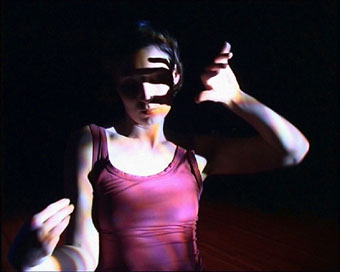
Nalina Wait
Nalina Wait was a founding member of Rosalind Crisp’s company stella b. with Lizzie Thomson. She has since made her mark outside that company, performing with Danceworks in Melbourne and Sue Healey in Sydney. Last year she performed a self-devised solo work in Mobile States, a program of young and emerging choreographers at Performance Space in Sydney. kew was Wait’s first major solo, a finely articulated improvisation traversing back and forth along a shaft of light. Currently Wait is working with an improvisation group, Devastation Menu, which includes Thomson (recently back from Europe) and musician Clayton Thomas. Wait has also made a film, Sole, with director Andrew Wholley of Mackaroon productions. Using a development grant from the Australia Council, she collaborated with lighting designer Richard Manner to create a film of 3 parts, each defined by a particular lighting state which Wait ‘inhabits’, linking the film to kew. She also performed in Sue Healey’s most recent film, Fine Line which is premiering at the 2003 Melbourne Festival, and Healey worked with her in the recent Space for Ideas choreographic program at the Drill Hall (a new venue for dance rehearsal and workshops in Rushcutters Bay, Sydney). Nalina Wait’s next project will be a tour to Canberra and New Zealand with Healey’s Fine Line Terrain.
RealTime issue #57 Oct-Nov 2003 pg. 43
© Erin Brannigan; for permission to reproduce apply to realtime@realtimearts.net
Ingrid Voorendt, Naida Chinner, Helen Omand and Astrid Pill are all making a significant impact on the South Australian dance and performance scene.
Ingrid Voorendt is developing her skills as a director in both theatrical and dance contexts. Using the setting of tasks, theatrical games and conversation to elicit material, she doesn’t impose movement material on those she works with, preferring to structure what the performers give her, thus foregrounding them. She works with both text and theme in this way. She is a warm, generous director, fantastic at structuring material using associative and visual logic. Her pieces are linked by a strong sense of spatial design, gestural language and playful games or physical tasks. Voorendt often contrasts spatial order with physically energetic improvisations that open out the space. She appears interested in metaphors and images that centre on but don’t ‘explain’ a theme and in the translation of ideas into visual, spatial design.
Naida Chinner is a choreographer and dancer with a background in gymnastics and contemporary dance training. She has a strong interest in the visual and often designs her performance environment. Her work lies somewhere between installation and dance performance and is marked by a nostalgia for innocence—childhood, dream love. She often uses love songs from the 40s, 50s and 60s. The work is almost romantic in the way of romantic comedies—laced with quirky, offbeat humour in the slapstick style of Doris Day and Rock Hudson movies. It also features whimsy, longing, dreaminess. In contrast, Chinner usually includes physical sequences that require considerable endurance and/or strength. This gives grit and abandon that offsets the whimsy in this very detailed and refined work.
Astrid Pill is primarily a performer but is also emerging as a writer of performance texts. She is a highly skilled singer, dancer and actor and moves fluidly between modes. Her texts are highly poetic in the manner of Jeanette Winterson. Pill is a classically trained singer with an enormous range. She is startlingly present and direct as a performer. A strong element is her capacity to move between song and speech supported by physical image or movement. Some experience in the Grotowski process and impulse work with Netta Yaschin plays a role. Pill is a highly intelligent and luminous presence, well versed in literary and musical traditions and borrowing from different genres.
Helen Omand’s performance interest is in improvisation and processes of moving. She uses contact and improvisational structures, likes the risk and chance of improvisation and doesn’t like movement work that has easy referents. She also enjoys ‘goofy’ play. Some of her work has been multimedia in which different texts run parallel—video, language, movement, light. Omand likes opening up questions rather than answering them.
RealTime issue #57 Oct-Nov 2003 pg. 43
© Anne Thompson; for permission to reproduce apply to realtime@realtimearts.net
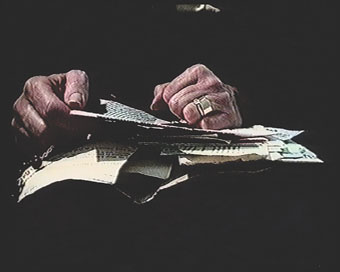
Kate Murphy, Prayers of a Mother, video still
Kate Murphy’s digital video Prayers of a Mother, 2001, featured in the remembrance + the moving image exhibition at the Australian Centre for the Moving Image in Melbourne (2003). Sydney-based Murphy graduated with honours from the Australian National University in 1999 and has been resident artist at the Canberra Contemporary Art Space and the Canberra School of Art. Fiona Tripp writes in the remembrance catalogue, “Central to Prayers of a Mother is the voice of Anne Murphy, mother to artist Kate and her 7 siblings. With great emotion, she describes the prayers she makes daily for her children and immediate family, expressing her hopes for their health and happiness, and specifically her passionate desire that they will all return to the Catholic faith. The mother occupies the central screen of the 5-screen installation, but rather than her face we see a close-up of her hands holding her prayer book and rosary, her gestures echoing the longing in her voice. On either side of this screen are 2 projections which show the children’s faces as they listen.” Prayers… is regarded by many as one of the most powerful video installation creations of recent times. Compared with the works of Viola et al, it is brief at 15 minutes but its potency is concentrated and the durably memorable. Murphy’s next work is eagerly awaited.
RealTime issue #57 Oct-Nov 2003 pg. 42
© RealTime ; for permission to reproduce apply to realtime@realtimearts.net
A recent arrival from Perth, and graduate of WAAPA, Paul Romano has been working consistently, alone and with others. He has just completed Stage One of a collaborative choreographic project, Transitions (with Simon Ellis, Anna Smith and Eleanor Jenkins), supported by Chunky Move as part of its Maximise Program assisting independent artists. Romano’s work indicates a sustained exploration into the possibilities of movement. He swings between 2 poles: fast, jointed movements, perhaps linked to a string of actions which travel across space; and still, very slow shifts which traverse a variety of bodily positions. His moments of stillness suggest an internal registration of corporeal feeling. He is in touch with his head and spine and their flexible possibilities, using these to construct movement pathways. I have the impression that Romano’s movement is composed of a series of positions that have been strung together to create a fluid whole or rather a series of shifts from one position to another. The result of such conjunction is that the pathways from one position to the next seem more focused on their endpoints than on the passage between them. What could be done to flesh out these pathways? Perhaps further variation in timing, quality and bodily tone/content would enrich them.
RealTime issue #57 Oct-Nov 2003 pg. 42
© Philipa Rothfield; for permission to reproduce apply to realtime@realtimearts.net
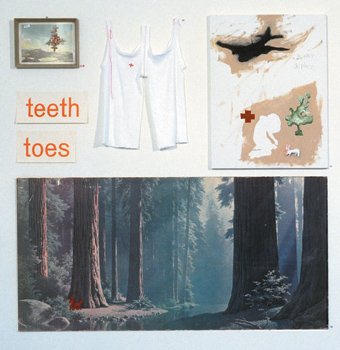
Heidi Lefebvre, installation view, 2003
photo Brenton McGeachie
Heidi Lefebvre, installation view, 2003
Joy and sadness. Giving shape to feeling. Heidi Lefebvre tackles things head on. Currently staging her first solo exhibition since graduating in 2002 with Honours from the National Institute of the Arts, School of Art in Canberra, she continues to engage with contemporary politics. Civilian Casualty at Canberra Contemporary Art Space, Manuka, in June, was the outcome of a NITA Emerging Artist Support Scheme (EASS) award, sponsored by CCAS. It represents a kind of ‘braving the world.’ Lefebvre knows now she is outside as she might put it, seeking opportunities, coming to terms with making art and making a living. Perhaps then the work speaks not only of these times, of itself, but of the positioning of the artist too, herself. Lefebvre’s exquisite works (a near sell-out) range across styles and media, from sketches and drawings to found jigsaw pieces, to bandages and blankets, to curious felt cutouts. The work evokes contrasting emotions; a sense of flight and trauma; comfort and shadows of grief; and as reviewer Russell Smith put it “a dream-like state where symbols of innocence contended with memories of pain or loss in the construction of a fragile sense of the self” (Muse Magazine, July 2003). A fitting start for any emerging artist.
RealTime issue #57 Oct-Nov 2003 pg. 42
© Francesca Rendle-Short; for permission to reproduce apply to realtime@realtimearts.net
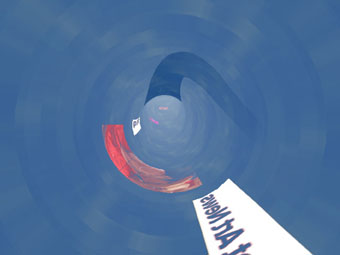
Tim Plaisted still from Surface Browser
A Rising Tide is a visual journey akin to racing down a winding narrow street at 120km per hour except that the street has become a graceful snake-like conduit that receives your queries as images and pastes them in fragments onto its inner skin. The transparent blue of this 3D space provides the participant with a distant view of the oncoming journey, which slides with myriad similes from the image bank of the internet. The speed and rush of the postmodern city and its pulsating ability to feed information through signs and symbols is a visual language analogous to the spatial environment created by the interactive elements of Brisbane artist Tim Plaisted’s new work.
A Rising Tide—An Internet Surface Browser attempts to provide a new ocular understanding of how search engines (such as Google) operate on the world wide web. In this application the user is confronted by a tube-like interface in which the web link or object query entered into the pathway becomes a page that moves across the surface of a pipe. The page acts as a kind of skin to a 3D object that dives and plummets through the pathways of the net. Loading images, the user navigates the links. Plaisted explains, “this is not a case of creating independent virtual 3D worlds but about re-mapping the existing visual aspect of the internet into an environment that can be entered and traversed. In this way, the solids representing pages can be seen as a way to give volume back to the millions of body images which make up so much of internet network traffic.” Plaisted’s Surface Browser seeks to provide a 3D visual experience of surfing the internet-a process that is otherwise formless or perhaps invisible to us as users.
Browser intervention is a recent exploration in new media art and one that Plaisted has entered from the perspective of visual social engagement. Much of his earlier work interrogated the simulated process of communicated reality. In 24hr Coverage TV news broadcasts appear as if pause is being repeatedly pressed–a newsreader emerges in a moment of repetitive distress with a barely audible stammer. The absence of content is highlighted yet we understand the image as a vehicle through which we are usually informed. Plaisted questions how decisions can be informed if they are “…made in terms of a society’s response to ‘the events of the day’ without full participation of the ‘public’ in an in-depth debate” (unpublished interview, 2001). For Plaisted, A Rising Tide is a valuable encounter. As a 3D visualisation of information it enables the user to understand, albeit in a somewhat abstract manner, how the web operates by indicating the journey of an enquiry.
RealTime issue #57 Oct-Nov 2003 pg. 42
© Zoe Butt; for permission to reproduce apply to realtime@realtimearts.net
The second Last Supper was one of the performance highlights of 2001, unruly and discursive, full of outrageous gags, wit, alcohol, songs and political barbs delivered by a team of experienced and new players. From the same company, Version 1.0, comes Questions to ask yourself in the face of others (Performance Space, May 30-Jun 8). It’s trim and taut, a 2-hander postmodern, post-apocalyptic parable as performed by Adam and Eve who happen to be performance artists and scouts in uniform. In a mix of deadpan declamation and neurotic outburst, David Williams and Beck Wilson play out the frayed couple’s return to the scene of the ‘original’ crime (a burnt-out bourgeois paradise) generating an increasingly loopy re-mythologising of their fate, counterpointed with a physical struggle that stops barely short of violence. They tell their audience, a jury of peers briefly back from the dead, “We were prepared, like good little scouts, but we weren’t ready enough…We performed poorly.” They are, it seems, seeking a verdict, “are we responsible for the world being fucked?” But is it absolution they’re after? “We may not be innocent, but we cannot stand to be guilty any longer.” A sometimes uneasy hybrid of script-driven schematism and rigorous physical performance, Questions to ask yourself… nonetheless hits home as conservative and right wing politicians continue to consign guilt and compassion to the rubbish bins of political correctness and history. In its rare outings, Version 1.0 is an important addition to the Sydney performance scene—we need to see more of them. Their next show, CMI (A Certain Maritime Incident), scheduled for March 2004 is now in development with Danielle Antaki, Nikki Heywood, Stephen Klinder, Christopher Ryan, Yana Taylor, David Williams and Beck Wilson in collaboration with Paul Dwyer, Samuel James, Simon Wise and members of Perth’s PVI collective.
RealTime issue #57 Oct-Nov 2003 pg. 41
© Keith Gallasch; for permission to reproduce apply to realtime@realtimearts.net
Kate Stevens’ current paintings are energetic and evocative streetscapes. She takes photographs while walking: mundane, even dull, images tracing incidental everyday experiences of passing through streets or other urban pathways. She then re-photographs these snapshots using a digital video camera. The video can shift the framing of an image, or clip a detail, or return a virtual movement to the scene as the camera tracks across or zooms closer to the surface of the photograph. In this way the video produces something like a filmic sequence of images from a single photograph: often the source of the sets and series she produces. Stevens also frequently uses filters on the video camera lens to transform distance and distort colour relationships in the image. She rephotographs frames from the video screen, resulting in small prints that will be the reference and source for her paintings. Walk and photograph, video and photograph: the work of painting then begins. The lush, rich impasto surface and the high-toned colour of Stevens’ paintings are thus at a great distance from the impetuous gestures or fevered imaginings of the expressionist painters they might recall. They hold in the play of paint a trace of a photographic image and the play of paint is constrained by that image. In some, the blur and distortion is such that if the paint were not applied with a precise discipline, the image might disappear. It is important that this does not happen for it is through this process that the surfaces of her paintings enact or model movement and memory, remembering the experience of walking and looking–for the image to disappear would be to forget.
Kate Stevens graduated with Honours, Canberra School of Art 2001. She was awarded an ASOC Scholarship in 2002 to travel to Japan and an Emerging Artist residency at Canberra Contemporary Art Space 2003.
RealTime issue #57 Oct-Nov 2003 pg. 41
© Gordon Bull; for permission to reproduce apply to realtime@realtimearts.net
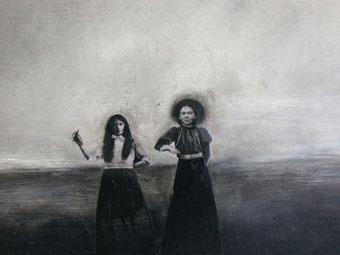
Irene Torres, Untitled 2003
A lot of art arrives in the mail at the RealTime office—on cards, disks, paper, acetate, vinyl, wood. We also receive key-rings, balloons, small packages (a tiny bag of sand arrived recently with the word “Escape” on a tag inside) and another day, a hand-painted box containing a pistol in papier-maché. Something about the moody postcard image from first site, a gallery with a strong commitment to emerging artists, stopped me opening mail this particular August morning. It showed the work of Irene Torres, a 22 year-old RMIT drawing student currently completing her honours year who featured with others in first site’s Recent Works exhibition. Torres speculates on the found photograph “as a representation of the experience of others in relation to [her] own.” She makes photocopies of these lost images and draws them (literally) into mysterious worlds. Occasional words and names are scratched into the grainy surface—“a gesso ground layered with various mediums, mainly graphite, acrylic paint, charcoal and pastels applied to pieces of MDF board.” Inspired by artists like Louise Bourgeois (especially her book of family photographs), Torres focusses on “the tension between the representation and the abstract space.” She uses the horizon line as a foundation for the image. The effect of distance and displacement is enhanced in the scale of these long, thin surfaces. Torres’ figures look like colonial time travellers caught in fragile, sometimes fearful landscapes.
RealTime issue #57 Oct-Nov 2003 pg. 41
© Virginia Baxter; for permission to reproduce apply to realtime@realtimearts.net
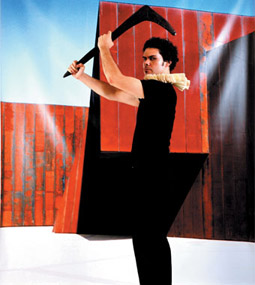
Christian Bumbarra Thompson
On a balmy dry season Parap Market morning in August, Brenda L Croft (photographic artist and Senior Curator, Aboriginal & Torres Strait Islander Art, NGA) opened Emotional Striptease and reaffirmed Christian Bumbarra Thompson’s status as one of the youngest and brightest ‘blak’ stars to emerge from the Boomalli ‘mother-ship’ into the galaxy of successful Indigenous photomedia artists including Destiny Deacon, Fiona Foley, Leah King-Smith, Tracey Moffatt, Darren Siwes, and, I would add, Croft herself.
From a Darwin perspective, both the timing and subject matter of the show were significant. Emotional Striptease coincided with the 20th National Aboriginal and Torres Strait Islander Art Award–long dominated by contemporary Indigenous art from remote communities throughout the Northern Territory and Western Australia. In the current ‘future shock’ climate of new media art, work from these regions may be regarded as ‘traditional’—in style, medium and content—but historically its claims to country are as politically powerful as the most confronting work from the cutting edge of the metropolis. Concerned with the interplay of meaning between objects, space and history, and Western culture’s (mis)representation of Indigenous Australians, Emotional Striptease is a provocative rebuttal to any institutionally-prescribed notions or categories of ‘blakness.’ It highlighted a contemporary Indigenous art practice which has not, until recently, received the local institutional recognition and public exposure it deserves–and unequivocally demands.
A Bidjara man of the Kunja Nation (southwest Queensland), Bumbarra Thompson was born in Gawler, South Australia, in 1978. He is also of German Jewish heritage. His art school training was in sculpture and installation. He spurns art historical classification: “my work, like myself, is in a constant state of flux.” Study in Melbourne, where he resides, has had an obvious influence on the ideological underpinning of his art and the cosmopolitan rubric of his catalogue essays.
At 24HRArt, Bumbarra Thompson ‘performed’ his Emotional Striptease in an installation comprising 7 large-scale, hyper-real colour photographs, each depicting a young Indigenous man or woman (including himself), variously robed in chic Melbourne’s trademark black or in a variety of costume props reminiscent of Victorian stage dramas or historical paintings. In a series of carefully choreographed poses and hand gestures, each figure holds an exquisitely incised and ochred Aboriginal artefact—a parrying shield, fighting club, woomera or boomerang. Like Caravaggio, the artist has chosen ‘models’ from his own world: friends and colleagues living and working in Melbourne. Set against the architectonic backgrounds of Melbourne’s key ‘cultural spaces’ (Federation Square, the Melbourne Museum, ACCA), the figure-in-landscape compositions collectively create a new Melbourne—one that reclaims that city as a reconstructed site of ‘blak’ urban identity. Three larger photographs, depicting close-ups of architectural façades, comprise the theatre ‘wings’ of a highly charged mise en scène.
Although tilting at the 19th century studio practice of ‘capturing’ Indigenous subjects in picturesque landscape dioramas and the ‘scientific’ role of photography in colonial ethnography, the iconography of Emotional Striptease contains echoes of other, earlier sources, principally art historical. One female figure bears a parrying shield, her white-gloved hand resting above the abdominal swell of her black hooped skirt. She stares back at the viewer with the dignified stillness and ritual solemnity of Piero della Francesca’s frescoed ‘urban’ Madonnas. Of all the male portraits, the most powerful image is of Bumbarra Thompson himself. His eyes seek the viewer’s with the intensity of one of El Greco’s ruffled-collared courtiers, fists clenched around a hooked, ‘number 7’ fighting boomerang, bare arms raised against a black/red façade–the traditional colours of revolution and resistance. Like a ‘blak’ avenging angel, wielding a potent artefact from the archival past, he annunciates an unmistakable message of self-determination for the present and future: boomalli–to strike, or make a mark.
–
Emotional Striptease, Christian Bumbarra Thompson, 24HRArt Northern Territory Centre for Contemporary Art, Parap, Aug 16-Sept 6
RealTime issue #57 Oct-Nov 2003 pg. 40
© Anita Angel; for permission to reproduce apply to realtime@realtimearts.net
In Nikki Heywood’s The Dark Room at PACT Youth Theatre a very young Karen Therese impressed as a daring and charismatic performer. She went on to train with Tess De Quincey until deciding on the Animateuring course at VCA. Since graduating in 2000 Karen has created a variety of collaborative works and freelanced with companies such as desoxy theatre in Melbourne, where Teresa Blake was her mentor, and Brisbane’s transmute collective. Karen received a kickstART grant from Next Wave as well as support from the Literature Board’s Write in your Face initiative to develop the trilogy, whitegirlblackdreams. Part 1, Sleeplessness, is based on the intriguing story of Karen’s grandmother who was unknown to the family until Karen’s sister began to excavate the history and discovered Lenke Palffy. Born in Budapest, working as a couturier, Palffy escaped post war Hungary for Australia where her 2 small children were placed in orphanages. How she came to be identified as a German man when she died in a nursing home in Annandale many years later is part of the story of Sleeplessness which Karen Therese presents at Performance Space this month during Carnivale. The performance is an attempt to construct a memory of an unknown relative whose life has uncannily provided the map for subsequent generations to follow. The research took Karen (with filmmaker Margie Medlin) to Hungary to construct a narrative of speculative events in Palffy's life. Sleeplessness is driven by Karen Therese’s intense desire to account for a remarkable life and to somehow weave it into her own. Also working on the project are young musician/sound artist Anna Leibzeit (Svila, Next Wave 2002) who uses the rhythms of an insomniac’s sleep to underscore the physical act of memory. Designer/maker Jane Shadbolt creates a latex skin for the projections by media artist Sean Bacon. Direction is by Toula Filokostas. Karen Therese has received a New Media Arts Board Run_Way grant to return to Budapest in 2004 to continue her research.
RealTime issue #57 Oct-Nov 2003 pg. 7
© Virginia Baxter; for permission to reproduce apply to realtime@realtimearts.net
Sisters Phoebe and Julia Robinson have been working together and apart. Having trained separately (Phoebe at WAAPA, Julia at Deakin University), the sisters united in a short piece last year. There is something appealing about 2 sisters working together—how are their bodies related? How do they differ? What connections operate between them? To what extent are they the products of distinct forms of training, and to what extent are their similarities due to a shared familial history? There is a trace in their work that I suspect comes from a form of contemporary dance/ballet common to their training. This manifests in lunges, twists, and turns, a torso at the service of long limbs, raised, lifted and kicked. Phoebe performed in Lucy Guerin’s Melt last year, and Julia in a retrospective of Shelly Lasica’s work at the Ian Potter Gallery. Together they trialled a new work as part of the Next Wave Festival. Phoebe made a work for Bodyworks at Dancehouse earlier this year. She has a nice sense of speed and tempo. Like Paul Romano, she shows an interest in jointed action of the limbs but combines this with twists, turns, dips and spirals. Julia has perhaps made less work, but she has a lovely, clear sense of presence, a freshness of composure. This was evident in her solo at this year’s Dance Card (July, Dancehouse)—Julia is able to maintain an internal focus while being watched. Her being and her movement are one. Neither inside herself, nor outside, just present to the action. Fairly simple movements, lunges, turns, twists, changes of levels, very upright, now prostrate. In a flash of deformation an iliac crest leads a differentiated torso. I liked the moments in-between: given the space to fill what is often a void in dance works, Julia instead expands her perceptual appreciation.
RealTime issue #57 Oct-Nov 2003 pg. 11
© Philipa Rothfield; for permission to reproduce apply to realtime@realtimearts.net
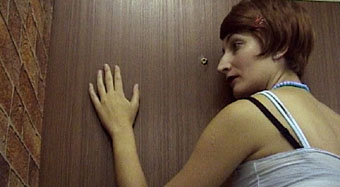
Bianca Barling, still from I wanna drown in an ocean full of love…
Bianca Barling is a recent graduate of the South Australian School of Art. Practising in a hybrid arena of video, installation, photography and performance, her work is remarkable for its lush production values and sentimental aesthetics. Barling’s work has always had an uneasy edge, not quite pure irony, although it is ironic with a lot of depth hiding in its sexy, gloss surface. Maybe it’s about being sentimental in a deep way, or perhaps believing in a situation that has an old script. And a lot of it is about love. Barling’s solo-produced short film, I’ve never walked out of a movie before (2002) made less use of narrative than her earlier collaborative Modern Love Collective works and relied instead on quite still camera shots with strong references to 1940s filmic codes and history. Seductive colour, sadness and retro kitsch pervade the atmosphere. Barling continuously plays with tropes of the stage, building tension between the real, the performed and the recorded performance/image. Her newest work I wanna drown in an ocean full of love…, shown in the CACSA Project Space in 2003, plays tricks with the strange mediation of the camera. A video work played on a monitor inside an elaborate box set. The video performer lay still within the set, which we could peer into through peepholes and windows. This tangled layering of real and constructed characters, places and scenarios is typical of Barling’s work, as is its carefully detailed romance.
Bianca Barling recently received a Helpmann Academy Mentorship, to work with new media artist Francesca Da Rimini.
RealTime issue #57 Oct-Nov 2003 pg. 11
© Bridget Currie; for permission to reproduce apply to realtime@realtimearts.net
A new force on the Melbourne theatre scene is The Eleventh Hour theatre company, the outcome of a lengthy collaboration between Anne Thompson and William Henderson: its other members are Fiona Todd, Adrian Muller and Carolyn Patamisi. The focus is on investigating the spoken word in performance and particularly the interplay of poetic and dramatic language. The creative task is in part a dramaturgical one: to compose performance from often very different languages while addressing a common image, or set of ideas. Eleventh Hour is at present composing a piece grounded in the world and languages of Oscar Wilde, from the poetry of The Ballad of Reading Gaol, the prose of his fairy stories and the dialogue and epigrammatic wit of An Ideal Husband.
Wine and Blood: another Oscar Wilde opens in The Eleventh Hour Theatre, 170 Leicester St Fitzroy, Nov 14.
RealTime issue #57 Oct-Nov 2003 pg. 10
© RealTime ; for permission to reproduce apply to realtime@realtimearts.net
Not exactly emerging but achieving recognition in her own right, Jo Lloyd has performed in Shelley Lasica’s and Sandra Parker’s work over many years. She received a Green Room award nomination in 1999 for her performance of Situation Live (Lasica) and In the Heart of the Eye (Parker, Danceworks). A graduate of the VCA, Jo is not typically ‘dancerly’ though she is quite capable of elegance. She executes other people’s choreography without affectation. The quiet assertion in her work manifests itself through a kinaesthetic immersion in action. She recently performed in the July Dancehouse season, The Dance Card and her work showed that she is increasingly extending her kinaesthetic range, exhibiting more confidence to experiment and therefore create surprising and new forms of movement. Jo Lloyd keeps movement coursing through her body, not in terms of compulsive activity but through sustained rhythmic complexity, tonal differentiations and a really nice bounce that’s capitalized through quick shifts of her body through space. By that I mean she has a certain quality which she takes with her in quickly shifting her centre of gravity. Sometimes this is seen in a range of little lunges, sometimes in a transfer of weight from one side of the pelvis to the other. She can also access an emotive, expressive, gestural palette combined with more abstract forms of action. Her relationship to music takes the form of dialogue rather than illustration in a way which sustains the musicality in her own body. It would be good to see her make and show a lengthy piece of work.
RealTime issue #57 Oct-Nov 2003 pg. 10
© Philipa Rothfield; for permission to reproduce apply to realtime@realtimearts.net
Mikhail Bakhtin argued that we only attain our social identity through our public interactions and performances. Carnivalesque performance therefore constitutes the supreme manifestation of unmasked social reality, in which everyone’s adopted roles only function because of their temporary public acceptance. This gives carnivalesque literature its radical quality, up-ending oppressive social hierarchies by crowning the fool “king for the day”, the latter’s role no less real for its fictional, performative character. Like the St Petersburg conman from Gogol’s play who enthusiastically acts the part of government inspector after being mistaken for one, fictional performance becomes true if everyone believes it—a reality today’s politicians know well. Director Daniel Schlusser has drunk deep of such Russian philosophy in praise of literary “dialogism”, carnivalism, masquerade, satire and anarchy. Schlusser’s madly careening production of The Government Inspector for the Hoist theatre collective was replete with performers, largely without artifice, taking on several roles or characters, often in the same breath. Men play women, women play men and the whole edifice of theatrical convention comes tumbling down.
If, as Bakhtin and Shakespeare both claimed, society is a theatre, then Schlusser’s society was one in which the enduring conventions were deliberately arbitrary, shifting from moment to moment, and never entirely relied upon. Often it felt as if we were at a light-hearted “event” rather than a “play” per se, or possibly a free-form (yet well-rehearsed) reading.
Partly because it’s a fundamental convention that sex and gender are essentially immutable social realities, I found the forceful inversion of these rules especially satisfying. Stephen Clements, after standing with his deep cheeks sucking in and out, doffed his helmet-like fur cap and stepped from his coat to reveal his impressive, long, stockinged legs and a fashionably spiked shock of silver hair which would not have been out of place among either the cashed-up dames of Melbourne’s haute shopping strips, or at a Les Girls review—from nervous, corrupt provincial judge to wife of a local petty worthy, in one deft transition.
Schlusser recorded in the program notes that the show’s dramaturgy was based upon “‘theatre crimes’…counter-intuitive responses” such as “to upstage your fellow actor” or “ignore the audience and each other.” Amid all of this artful chaos, it was largely the actors’ commitment to the text—as well as to a common sense of fun and mischief—that ensured things did not fall completely apart. Schlusser staged Gogol’s script unedited, causing the show to run at 3 hours, so the audience returning after interval was notably smaller than before. Although this was frankly over-taxing, it did mean the 4th wall between actor and spectator was annihilated, both having experienced a theatrical auto-da-fe of endurance. By packing so many ideas and so much performative freedom and plasticity into a single production, Schlusser’s reach did somewhat exceed his grasp, but The Government Inspector was more impressive because of its massively conceited excesses.
Nikolai Gogol, The Government Inspector, Hoist Theatre Co., Melbourne, July 10-27
RealTime issue #57 Oct-Nov 2003 pg. 10
© Jonathan Marshall; for permission to reproduce apply to realtime@realtimearts.net
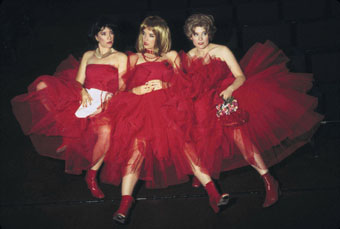
The Fondue Set (Emma Saunders, Elizabeth Ryan, Jane McKernan)
photo Suzanne Brown
The Fondue Set (Emma Saunders, Elizabeth Ryan, Jane McKernan)
I first saw the Fondues (Emma Saunders, Jane McKernan, Elizabeth Ryan) at the now defunct Bodies dance festival: sandwiched between dance pieces taking themselves very seriously indeed, they were a breath of fresh air. Ironic, really, given that they swept us into the smoky, ritualised world of the pub—which is in fact where they originally began performing for their mates. The Fondues are funny, sexy, irreverent, ironic, Sex In The City kind of gals, but less cynical, and definitely more smiley. I can just picture them downing Cosmopolitans with Sarah Jessica Parker and co—red is, after all, their trademark colour from lippy to tippy toes.
Like those cute dashboard puppies with heads waggling on a spring, the Fondues play humorously with repetitive movement in their work—not so much obsessive-compulsive de Keersmaeker-style as playing that fab new 45 single over and over again for the simple teenage joy of it. It’s not so surprising that my terms of reference are to defunct recording formats, there is definitely something vintage—swinging 50s/60s/70s/80s—about The Fondue Set. (How could there not be, named as they are after that essential 70s dinner party accoutrement?) Certainly their recent, full-length piece, Blue Moves at the Seymour Centre evoked prom night and Hitchcockian heroine/ victims for me, alongside its explorations of more contemporary female experience. Blue Moves (2002) was a welcome full-scale development from their earlier vignettes, especially following the less densely layered Soft Cheese (2001), though I did love the hilarious anarchy of that piece—perhaps inevitable when one Fondue appears with a plaster cast plus wheelchair!
Dizzyingly intoxicating, intoxicatingly dizzy, they make me want to put on red lipstick and dance. In high heels. And a frock. Where can I get some shiny red boots?
The Fondue Set’s next gig is at the 2003 Melbourne Festival where they will perform at late night cabaret venue, The Blue Thong Club, in the Black Box at the Victorian Arts Centre.
RealTime issue #57 Oct-Nov 2003 pg. 10
© Laura Ginters; for permission to reproduce apply to realtime@realtimearts.net
It’s no secret that working conditions for independent dance artists and small project-based ensembles in this country are appalling. Not only do these artists make and present work, but they take on board myriad creative, administrative and promotional issues, including occupational health and safety and public liability. Your average dance artist is unlikely to be familiar with the finer details of all this and exhausted by the endless adminstrivia. This leaves little time and energy for the creative process-assuming there’s any money with which to be creative! Enter STRUT, established by highly regarded choreographer Sue Peacock and freelance administrator Gabrielle Sullivan with the support of Ausdance WA, STRUT assists artists with their funding applications and if an artist is successful, takes on production support and promotion for that project. STRUT also produces 3 2-week programs of studio showings annually, which have been hugely successful with artists and audiences. Artists are, however, responsible for more than turning up to perform. They’re expected to support each other’s work, help on front of house, assist with stage management and participate in the decision-making process. STRUT operates like a collective-artists attend regular meetings where information is shared and programming decisions discussed. In 2004, STRUT plans to pursue skills development opportunities-everything from lighting to intensive movement workshops. Beyond the regular studio performances, STRUT is looking to develop theatre seasons, to extend its network interstate and, in association with Ausdance WA, planning a studio tour that will allow artists across the country to become familiar with the work of their peers. In 2004, studio showings are planned for Adelaide and Melbourne, but these plans are-as the saying goes-funding dependent.
RealTime issue #57 Oct-Nov 2003 pg. 9
© Sarah Miller; for permission to reproduce apply to realtime@realtimearts.net

Anna Helme, Louise Terry
photo Rebecca Stegh
Anna Helme, Louise Terry
Electric Dreams is a genre-hopping audiovisual zine performed by The Artesian AV Arkestra (Anna Helme, Louise Terry) a small band exploring the potential of performance with live video.
“We’re a big-band cos we got big-ideas. Live-action video collides onscreen with a comix feel, projecting customised slides and hand-drawn stop animation cut’n’pastried with the latest in digital compositing with Flash/After Effects etc. Our sonic palette includes acoustic character-driven tragi-country lullabies through to quirky pop tunes, upbeat electronica and an atmosphere of textural loops. All of this action is assisted by the newly designed SpaceMaker, a spatial audio and video mixer. This theremin-inspired instrument will be accompanied by a cacophony of out-dated musical instruments and newly modified sound toys. We’re hiding our laptops under the desk and puttin’ on our tie’n’tails to give you a sensory spectacle through a landscape of (s)punky audiovisual oddities. As Rocky and Visage, time-bandits in tinfoil-underpants, Helme and Terry will be the audiovisualnauts guiding the cinematic spaceship. Mark Gomes (Barrage) is our musical filter-psychotically selfish sounds take on the guise of innocence and suave, innocuous melodies bend darkly sinister. Paul Bourke as Vladimir Crow visits this production as a ghost in the machine, embodying the lonely spirit of a cowboy on the plains, Charlie Chaplin caught in the cogs of post-modernity.”
Electric Dreams is being developed for Next Wave 2004 and beyond. Helme also works with with Sean Healy as SPOOLE, an audiovisual duo, peforming at Electrofringe this year. www.sagaponic.net
RealTime issue #57 Oct-Nov 2003 pg. 9
© RealTime ; for permission to reproduce apply to realtime@realtimearts.net
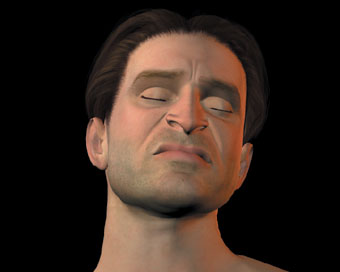
Linda Erceg, from PunchLine, 2003
Hovering somewhere between the urban myths of our collective cultural imaginary and our most private desires and experiences, Linda Erceg’s multimedia narratives splice reconfigured gaming engines, internet porn aesthetics and digitally generated ‘characters’ with dirty jokes, sex confessions and tales of debauched bachelor-party escapades. Naked virtual bodies go one-on-one with viewers, who are somewhat diminished in scale by the enormous cocks, breasts and jiggling nipples which tease, invite and thrust at them, while a pulsing musical score provides a rhythmic, visceral counterpoint to the on-screen shenanigans. Erceg’s increasingly confronting screen-based installations often place the viewer in an extraordinarily intimate space of engagement with the work. Skin Club 2002 features naked, computer-generated characters regaling individual viewers with stories of sexual escapades, reprimanding them if they fidget or walk away from the viewing space.
Punch Line, exhibited this year in the Australian Centre for Photography’s Staring in the Dark exhibition, featured solo sexual performances from a number of characters underscored by a throbbing, repetitive electronic soundtrack and polyphonic recollections of dirty jokes and sex stories. The stories are at once wildly exaggerated and uncannily familiar, a tension echoed in the repetitive, mechanical yet strangely organic quality of Erceg’s animated figures. This schism echoes the simultaneous liminality and extreme banality of a modern sexuality, which is increasingly the product of a fast-paced, competitive technologically oriented culture. In a world where guilt-free satisfaction, or perhaps a simulated surrogate for sex, is only a URL away, with no inconvenient interaction, emotion, consequences or afterglow involved, Erceg’s work provides a means to consider how technology amplifies, distorts and attenuates our desires, leaving the viewer to ponder the meaning/aftermath of their encounter, after the screen goes blank.
RealTime issue #57 Oct-Nov 2003 pg. 9
© Jeff Khan; for permission to reproduce apply to realtime@realtimearts.net
Vince Miller, an actor in his late 20s, is the founder of Red Stitch theatre in St Kilda. Miller studied dance at WAAPA and in London and spent a year on the West End in the musical Oh! What a Night. He continued working in London fringe theatre, then returned to Melbourne in 2001 to “pour his life savings” into setting up a space for a new theatre to be based around a company of actors. This is the unique aspect of Red Stitch. The company is an ensemble of 12 actors who choose the plays and appoint directors for each project. Miller is dynamic and set the pace immediately by promising and achieving 12 productions in the first 12 months of operation in the company’s converted office space in St Kilda.
The standard has been high and the momentum has paid off. Within a year audiences arrive at the theatre “to see a Red Stitch show”—the self-defeating bind of the one-off independent show has been broken. Red Stitch chooses contemporary plays about the 20-something bracket they occupy themselves. The repertoire so far has been largely American but the most recent shows, Dirty Butterflies and Black Milk, have been by new British and Russian writers respectively. Miller’s background in dance gives his own performances a physical detail and energy that sets a style for the whole company. Red Stitch has recently moved to a 60-seat converted church hall in St Kilda east. For the regular legion of actors graduating from theatre schools each year, Miller has proved that with the right amount of energy you can create work if you’re willing to put the work ahead of the pay packet.
RealTime issue #57 Oct-Nov 2003 pg. 9
© Richard Murphet; for permission to reproduce apply to realtime@realtimearts.net
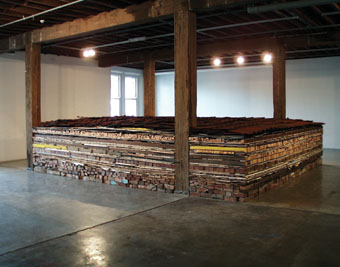
Sean Cordeiro & Claire Healy, The Cordial Home Project
While business pundits prophesied the end of the current housing boom, the judges for the Helen Lempriere Travelling Art Scholarship 2003 (Aug 14) awarded the $40,000 prize to Sean Cordeiro and Claire Healy for The Cordial Home Project, which originally appeared at Sydney’s Artspace (Feb 6-28). The judges commented on the work as “topical and extremely relevant to the current concerns about the affordability of housing in Australia” and described it as “a demanding and ambitious project that is provocative and conceptually informed.” In their note accompanying the work, Cordeiro and Healy wrote, “The exhibition documents the transformation of a house from family home to unwanted scrap to art object. In deconstructing meanings of the home, there is a misguided yearning to discover its real essence as suggested once in its title…[W]e also wish to highlight the absurd delusion of 2 young artists owning a home in Sydney.” There is something at once sobering and exhilarating about the project in the rawness and neatness of the layered components of the original house in its new form (not a little reminiscent of compacted automobiles), a carefully stacked and packed block from which all inhabitable space and the spirit of domesticity seem to have been sucked away. This is compression, artistic and actual, at its most powerful. It was reported that the scholarship will take Cordeiro and Healy to India to work on the collaborative building of a “500 foot materialisation of the Maitreya Buddha, out of a sand cast bronze aluminium alloy.”
RealTime issue #57 Oct-Nov 2003 pg. 8
© Keith Gallasch; for permission to reproduce apply to realtime@realtimearts.net
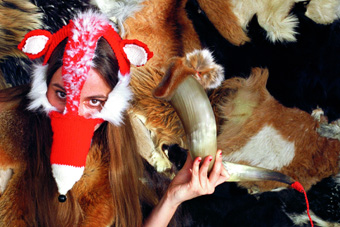
Lisa Reihana & Beata Batorowicz,
Feathers Calling Foxy on the Fone (detail), 2003
The art practice of Polish-born Beata Batorowicz, a self-titled foxy artist, is refreshingly innovative and a source of much amusement. Through fetish bestial garments and objects, large-scale soft sculptures and photographic tableaux she acts out the position of a discontented daughter. Aptly describing this as anti-big Daddy art she expresses an imagined father/daughter relationship, specifically with the late German art hero Joseph Beuys. Both homage and mockery, Batorowicz uses the grossly fabricated story surrounding Beuys for much of her output to which she adds references to the patriarchs of Western art/philosophy: a knight from Duchamp’s chess set and Clement Greenberg’s book The Avant-Garde of Kitsch (1939) for example. The materials and processes used to create (or re-create) these works are loaded with their own histories. In a satirical take on the specifically Polish/German notion of ‘fatherland’ Batorowicz uses traditionally feminine crafts to critique male dominance in the arts. Seemingly disappointed with ‘traditional’ art mediums she introduces knitting, patchwork and sewing to the realm of high art.
Showing great artistic promise Beata Batorowicz has exhibited in several group shows including Hatched (2000) at the Perth Institute of Contemporary Art, Primavera (2000) at MCA, Sydney and in the touring exhibition Gulliver’s Travels (2002/03). Currently completing a Doctor of Visual Art at Brisbane’s Griffith University, Batorowicz has most recently exhibited at the Institute of Modern Art in Readymade for which she collaborated with leading New Zealand artist Lisa Reihana and will next exhibit at the Ian Potter Centre, Melbourne in Fraught Tales.
RealTime issue #57 Oct-Nov 2003 pg. 7
© Shaun Davies; for permission to reproduce apply to realtime@realtimearts.net
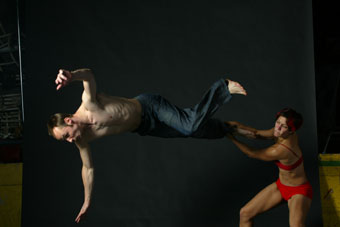
Rowan Marchingo and Alexandra Harrison
photo Daniel Bereholak
Rowan Marchingo and Alexandra Harrison
Alexandra Harrison performs with Legs on the Wall around Australia and internationally, including the Canadian co-production Flying Blind touring nationally in October-November. We first spotted her singular creativity in 2 works (Knots and Diffusion) which she wrote, directed and performed at B-Sharp 2001-2002. She also co-created Together which she performed with Rowan Marchingo. She is currently working with Legs on Eora Crossing, directed by Wesley Enoch, and Cloak of Feathers with Chris Drummond. Harrison was studying Anthropology at Macquarie University when she was waylaid by a 2-week workshop in acrobatics “just to keep me sane” and was hooked. Before this she had lived for a time in Canada where she lied her way into a dance-theatre intensive that gave her a new respect for bodies and articulation. Now she just wants to find as many ways as possible to communicate, to make movement meaningful and on the way, work out how to live, how to stay sane in the world. “I’m obsessive…don’t relax easily ….You have to figure out how to live, how to eat, how to stop yourself from being perpetually pissed-off—getting incensed at the waste when some poor waiter offers you a straw in a restaurant! And what the fuck can art do when nobody in Australia sees it.” She finds Australia a pretty embarrassing place to be at the moment. “What is happening? Everyone is complaining but nobody is doing anything.” Harrison’s at exploration stage, working on a new solo about sleep and narcolepsy with theatre director/writer Michael Piggott which we’ll hopefully get to see at B Sharp in 2004. Alexandra Harrison is an edgy, sexy and very skilled performer and choreographer who likes working in physical theatre, creating her own pieces while contributing to the development of Legs’ work. “Unlike a lot of forms, physical theatre is still undefined. So there’s space for someone like me and my ideas…The fact that it’s growing and unsure of itself makes it more exciting.”
RealTime issue #57 Oct-Nov 2003 pg. 13
© Virginia Baxter; for permission to reproduce apply to realtime@realtimearts.net
Aphids’ artistic director David Young has a distinguished career as a new music composer. The company he is affiliated with is less well known, largely because the fascinating projects mounted under its banner tend to be will-o’-the-wisp events, with long gaps between them. The company has however been enjoying considerable success in Europe for several years. This year’s Melbourne Festival marks Aphids’ definitive Australian coming out, with 2 new music events from the company: a composition from Young accompanied by projections drawn from the FBI’s database of skin colours (Skin Quartet) and a collection of near impossible to play solo contemporary classical violin pieces, performed by Yasutaka Hemmi, as the title suggests, as a kind of Fight With the Violin. The most interesting feature of this company is the way it departs from the annual or biannual concert series so common in new music. Aphids events typically involve a high degree of performativity, with music not necessarily being a feature. For example, theatre-maker James Brennan’s The Glass Garden (2001-2002) is auspiced by Aphids, while another of the company’s projects was composer/ director Richard Rijnvos’ poetic-critical, live staging of Samuel Beckett’s radio play Radio 1 (1999). Productions for 2003 include work by prolific young local playwright Lally Katz, returning to her early interest in writing for surrealist puppetry. In short, while Aphids may not have the rough-shod energy of the old Cabaret Voltaire, their music and performance program reflects a similar interest in contemporary manifestations of avant gardism and cross-arts.
RealTime issue #57 Oct-Nov 2003 pg. 7
© Jonathan Marshall; for permission to reproduce apply to realtime@realtimearts.net
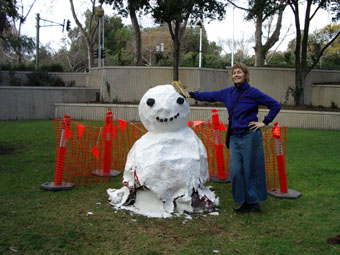
Sarah CrowEST, snow creature
I’ve known of Sarah CrowEST’s work for a long time, yet it’s hard, now, to define it—which is its strength, and its vulnerability (in the best sense). Coming from an established craft background in textiles, the move into arts practice is a mere footstep, an addition and an elasticity. And, language means everything in this move, or movement between and across genres. In CrowEST’s work every move makes a difference—this is the great continual break (and breaking): that everywhere/place is the space of making and showing: unofficial streets, official public space, art gallery, craft gallery. The work seems, overall, one of secreted memory, ambivalent about where things should, or could, or will be. And more, how they might appear, or make an appearance in the world (eg how will a ‘snow creature’ cope in an Adelaide winter). Small passive creatures live in boxes, and other creatures want to live there too; the places we make, make others placeless. This strange divide between place (unconditional) and placelessness (contingent) is a political imperative—how do we regard others (will the black ‘beetles’ crawling up the side of the boxes be welcomed?).
CrowEST makes boxes for those who seem to belong—weird creatures anyway. Other ‘things’ become ‘blobs’; rounded, stone-like, fabric coated shapes—not quite seamless–replete with ‘what’ they might be…tomorrow. Pregnancy is a dangerous state, the benign appears quiet (as hell). There are too many extraordinary works to write of, each finely realised, like the exhibition at Downtown Art Space, earlier this year, where, in the catalogue, Bridget Currie wrote: “A slow heart beating. In parts, the delicate hairiness of spores, mould mounds, fungal bloom…Moist sludgy love.” It is a particular poetic that Currie engages–an illicit quietness. CrowEST’s latest work snow creature, part of BUILT! an ephemeral public art project (an Adelaide Festival Centre Trust Visual Arts initiative), was bashed the first night it took up its position at the King William Street side of the centre. CrowEST repaired it for the next day’s opening. The snow creature was there for 20 days, and continued to be ‘bashed.’ Perhaps all ‘snowmen’ are beaten and broken; that could be their ‘invitation.’ Still, it was a stranger in our midst, incongruous, small, even lost. Sarah CrowEST’s work questions whether care is possible in the face of incomprehension.
RealTime issue #57 Oct-Nov 2003 pg. 7
© Linda Marie Walker; for permission to reproduce apply to realtime@realtimearts.net
David Franzke is a theatre and dance composer who has successfully convinced directors to accept his often aggressive use of sound. In addition to his beautiful, idiosyncratic scores for dance theatre such as Anna Tregloan’s Skin Flick (2001), he inserted a sometimes bombastic, torn, radio-like soundscape into Playbox Theatre’s Falling Petals (2003). As someone schooled in club DJ-ing, Franzke’s aesthetic merges creative breaks or avant-hip-hop with contemporary, hissy, musique concrète. It is no surprise that Franzke’s samples have included the works of Bernd Friedman (Beige, Freeform, Red Snapper) and the Crazy Baldheads. His work shares the funk and sci-fi humour of the former, while he is collaborating with the latter on a score for the Melbourne Workers’ Theatre’s Yanagai! Yanagai! (2003). Franzke is on the cusp of moving beyond his pre-recorded compositions for others into his own performances and releases. The recent Dancehouse Dance Card season (2003), for example, allowed him to overtly rewrite the emotional content of the solos performed in front of him by visibly mixing deep, loud, funking combinations, while Opera Somatica’s Oculus (2002) enabled him to conduct twisted tango played by a live string ensemble. More gentle musical offerings include his collaboration with Jeremy Downer as Tet et Hok, On the Fly (self-produced, 2002), while his exquisite ghosting of the transitions within electronic space is found on the Strewth! compilation (Synaesthesia, 2002). If Franzke continues to build on such independent works as his live appearance within 45 Downstairs’ Swank series (2003), he is sure to continue to challenge and amuse.
RealTime issue #57 Oct-Nov 2003 pg. 6
© Jonathan Marshall; for permission to reproduce apply to realtime@realtimearts.net
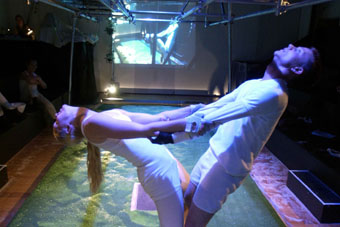
istheatre ltd, White Trash Medium Rare
photo Bruce Miller
istheatre ltd, White Trash Medium Rare
Martin Coutts has just received a RUN_WAY grant to attend the Transmedial media festival in Berlin next year, which he won on the merit of performing, writing and video making with Ryk Goddard (istheatre ltd) for Freezer (a performance installation in a dance party). The artist sees Berlin as the best place to explore his interest in new media works that include performance, particularly in the unique nightclub environment. Lamp is a collaborative project with Tricky Walsh (a visual artist and animator who works in claymation, she is interested in optical and filmic experience). Their “badly made box” using a lens, light and a body—“all that TV is really”—is a proudly “low-tech media” collaboration to these artists. Transparency is important to the artists who believe that being open about the (simple) mechanisms at play means the audience will be less preoccupied with unraveling the way it all works and hence freer to experience the piece. Lamp has been funded to attend the Next Wave festival in Melbourne. Coutts is not averse to ‘higher’ forms of media in his performance. Spect, a new collaboration between dancer Bec Reid and multimedia artist Matt Warren, involves manipulating live feed in an environmental installation. It’s an exploration of site and space and an attempt to resolve one of the challenges of performing with media. Concept and media artists often move out of sync in the developmental process: Martin Coutts is interested in bringing it all together again.
RealTime issue #57 Oct-Nov 2003 pg. 6
© Susanne Kennedy; for permission to reproduce apply to realtime@realtimearts.net
Alex Davies is a digital media artist working with sound and image integrations and responsive installations. His recent work Swarm, shown at Artspace in June/July this year, was an evolving audiovisual environment built from the live footage of viewers in the gallery captured while they watch the work. This is then played back in real time (with a slight ghostly lag), while a database of prior visitors is randomly composited creating a mixed environment of real and virtual, or in fact remembered bodies. The image constantly shifting across the width of the gallery creates a scoping sensation, and also triggers panning parameters in the sound bed. Swarm produces a disjunction between the viewer’s perception of themselves in time and space as they question which presences are real, which spectral. The strength of Davies’ work is that each element is perfectly integrated. The technology is not used as display (as is often the case in technically advanced new media investigations) but rather as the tool to serve the concepts. This is also the case in the work Filter Feeder currently exhibiting as part of Primavera at the Museum of Contemporary Art (p21). Davies has also recently exhibited Anchortronic Performance and Heterodyne at the Garage Festival, Germany and is involved in collaborations with robotics artists Time’s Up in Austria. http://schizophonia.com
RealTime issue #57 Oct-Nov 2003 pg. 6
© Gail Priest; for permission to reproduce apply to realtime@realtimearts.net
Here’s a homeopathic drop of distilled pure form for RealTime. Melbourne 30-something Michael Farrell is an emerging poet in a potentially submerging artform. His recent book ode ode has a cover photo of 2 plastic forks on a red carpet. Considering poetry books usually have landscape images which reek of the production values and aesthetics of amateur bushwalking guides it’s an overwhelming relief to see—Farrell is a cheap stylist de rigeur. His signature style is the assemblage—there’s virtually no vestiges of the romantic author, what American critic Marjorie Perloff calls “the tedious and unreflective claim for the unique insight and individual vision that has characterised so large a portion of mainstream poetry.” While the lyrical ‘I’ isn’t mobilised by Farrell, you get the sense that he is peculiarly enmeshed by a life he then hives off to form pop poems—“the stuff of late 90s legends.” This energises his work perhaps more than many others of his ilk anthologised in the Calyx anthology (Paperbark Press, 1999), who tend to be more concerned with the changing ecologies and language theory of the post-romantic landscape. However, Farrell is also in dialogue with the artistic tradition he inherits, with poems referring to visual artists (Vermeer to Jeff Koons), dance (tango to “my knees arent much but in/ mes the spirit of the young travolta”), music (“compare the songs you heard this morning with madrigals &/ fitting the words underground overground/ wombling free to the tune & you compose/ a poem”) and film (“this is cinema made by people/ shuffling in gumboots”) as well as inserting fragments of literary and other texts within his poems to form cut-ups. There’s a sense of place, of European tradition as well as the local (“my white arms reach for brisbane”) and even that great poetic motif, birds, get a mention in chirp (“fuck off lay eggs come back to my window/ ill give you ash to peck at”).
Farrell’s modus-poeme is “its better to edit than portray”, and his work is nodal, unpunctuated, even words are often broken at the end of lines, creating interesting disjunction. Just shy of frustrating poetic obfuscation, he “speaks in little phrases like a bee thats afraid of conversation.” I think finally Farrell is Frank O’Hara’s Australian heir apparent, where so many others have tried it’s Farrell who's perfected the requisite combination of laconic camp. Michael Farrell is the Australian editor of Slope magazine (www.slope.org). All quotes from Michael Farrell, ode ode, Salt Publishing 2002.
RealTime issue #57 Oct-Nov 2003 pg. 5
© Keri Glastonbury; for permission to reproduce apply to realtime@realtimearts.net
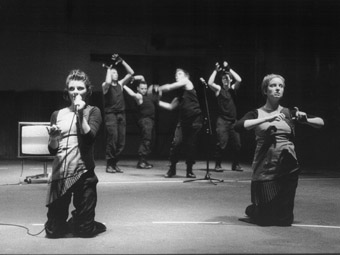
The Border Project, Despoiled Shore Medeamaterial Landscape with Argonauts
photo David Wilson
The Border Project, Despoiled Shore Medeamaterial Landscape with Argonauts
The Border Project is an ensemble of theatre artists committed to charting the future language of live performance, creating performance that communicates with an audience that traditional theatre has left behind. Their work transcends borders, using a performance language that reflects the contemporary landscape, the time and place that we live in–the collision of sound and images from videos, pop music, film, television and cyber-media which surrounds us. The Border Project set out to dislocate our perception of media by re-engaging the live experience, taking the audience with them on a journey of diversity and innovation. The founding performers who hail from Flinders University in South Australia, now work across borders, living in different states and coming together to create their multi-layered work. The ensemble members are Katherine Fyffe, Cameron Goodall, Sam Haren, David Heinrich, Andrew Howard, Amber McMahon, Paul Reichstein, Andrew Russ and Alirio Zavarce. All are committed to a unique ensemble practice, with a shared history, performance skills and an equal involvement in the process of creating work.
In 2002, The Border Project presented its inaugural production, Heiner Müller’s Despoiled Shore Medeamaterial Landscape with Argonauts, and was nominated for the 2002 Adelaide Critics Circle Award for Innovation. In the second half of 2003, The Border Project will be creating a number of new projects, including a durational performance piece, Please Go Hop!, an intimate work exploring games, memory, fear, movement and pop culture with a crazy 80s sound track. The ensemble are also developing a major new work exploring Picnic at Hanging Rock, disappearance in the Australian landscape and the illusion of magic shows.
RealTime issue #57 Oct-Nov 2003 pg. 5
© Rachel Paterson; for permission to reproduce apply to realtime@realtimearts.net
Performer and composer Hannah Clemen uses both acoustic and electronic/computer-based instruments. As well as creating works for events, festivals, ensembles and individuals, she has collaborated with dancers, filmmakers and visual artists and her works have been performed or broadcast in Australia and beyond. Clemen has also exhibited several sound installations in Perth galleries. Critic Gordon Monro (gordonmonro.com) wrote of IntraSpectral II, an installation at the Australasian Computer Music Conference, July 2003: “Clemen’s IntraSpectral II…responds best to singing of relatively slow notes, which suits its purpose to encourage meditative states. Some very interesting timbres resulted…Overall [it] is one of the best interactive sound installations I have encountered.” Clemen is developing several installations designed to encourage meditation, healing and self-cultivation and conducting improvisation and sound meditation workshops as research towards creating ritualistic semi-improvised works for group participation. She is interested in cross-media arts that challenge the traditional dualistic paradigms of audience-performer or artwork-viewer, aiming for a more participatory and ‘ecological’ approach.
RealTime issue #57 Oct-Nov 2003 pg. 5
© RealTime ; for permission to reproduce apply to realtime@realtimearts.net
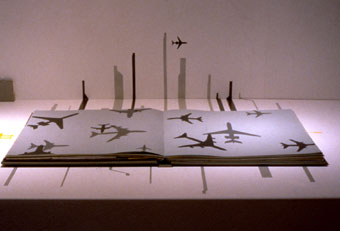
Ian Blamey, User Friendly, 2001
Graphic designer Ian Blamey divides his time between commercial and student work. Best known for his innovative graphic design in student magazines, government handbooks and corporate promotions, Blamey describes himself as “first and foremost, an artist.” Favoring the artist’s book as a creative medium, Blamey has exhibited nationally and internationally since 1995. Initially using collage, found images, vinyl adhesive and screen prints, Blamey’s books have grown with the rapid development of computer design programs. Now able to incorporate more of his own images into the books, the success of Blamey’s work was most evident in the 2001 solo exhibition, User Friendly, at Foyer Installation Gallery in Hobart. Heavily influenced by the modern technological environment, Blamey is a true lover of vector graphics. While paying homage to the industrial geometrics of typical vector design, his work is distinctively slick in its ability to transcend surface. Organic flourishes of Autumn leaves and jagged mountaintops intermingle with the stark outlines of building sites and suburban sprawl. Blamey’s skill at interpreting the essence of object and place gives his graphic work a deeper aesthetic not usually found in monochrome design. Currently completing an Honours year at the University of Tasmania, Ian Blamey is exploring the effect of celebrity and fan culture on personal identity. Using the techniques of self-portraiture, airbrush and colour illustration, his present work implies that our relationship to the cult of celebrity is a form of escape, playing a vital role in the way we see ourselves.
RealTime issue #57 Oct-Nov 2003 pg. 5
© Briony Lee Downes; for permission to reproduce apply to realtime@realtimearts.net
Discovered by Queensland Theatre Company in the mid-90s when she won the Young Playwrights’ Award 3 years running, Angela Betzien’s theatrical emergence has come full circle. Her play, The Orphanage Project, is part of the company’s 2003 program. Along the way there have been stints at La Bôite, the Brisbane Festival and even London’s Royal Court. The thread running through Betzien’s writing is a mordantly wry fascination with children and neglect: scavenging children left unattended in city carparks (The Kingswood Kids); and missing children of deranged parents in shopping mall beauty pageants (Princess of Suburbia). Now, with The Orphanage Project, she shifts her attention from the backyard to the national stage in a play writ large with sinister, gothic focus on systemic childhood abuse. Betzien uses the maltreatment of young people as a metaphor for the rankness and corruption of innocence in the broad Australian imaginary. Betzien formed theatre group The Real TV Project with director Leticia Caceres in the late 90s and this independent outlet has run parallel with her considerable mainstream success, allowing her to experiment with form and tone before an appreciative alternative urban Brisbane scene. It seems fitting, then, that Brisbane has produced the writer touted as Australian theatre’s ‘next big thing.’ As Queensland seeks to redefine itself from ‘Sunshine’ to ‘Smart’ State, Betzien’s intelligent body of work provides a timely reminder that Paradise has its sinister side.
RealTime issue #57 Oct-Nov 2003 pg. 4
© Stephen Carleton; for permission to reproduce apply to realtime@realtimearts.net
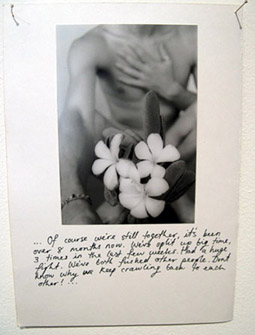
Bradley Alderson, War of Love
Gay pride sounds an intimate, classical chord in Bradley Alderson’s series, War of Love, an endearingly honest narrative of the artist’s first gay relationship–doomed but impassioned—recreated through cursive text and abstracted images of a naked white male (perhaps representing Bradley’s ex), bare surrounds and emblematic flora (frangipani-strong) in soft decay. Shown as part of Campsites at Darwin’s Pride Festival, Alderson’s black and white vignettes, cleaved from an art journal (16 pages, A5), portray a raw sensitivity and subtle sophistication, bringing a fresh feel to a potent though often over-wrought genre.
Alderson’s Aboriginality offers a distinctly local, cross-cultural take on sexuality and underpins the acute social, subversive agency of photography. A student at Charles Darwin (formerly Northern Territory) University, Alderson recently debuted in PICA’s annual national graduate show, Hatched. War of Love confirms him as a promising young talent.
See review of Campsites.
RealTime issue #57 Oct-Nov 2003 pg. 4
© Maurice O'Riordan; for permission to reproduce apply to realtime@realtimearts.net
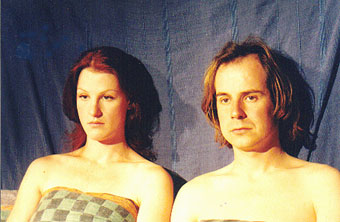
Lovesick
“I’m working on a theory,” announced a breathless futurologist in a recent edition of Time magazine. “I’m calling it, ‘The Centre is the New Edge’.” And, presumably, vice versa. Doubters should glance over the catalogue for this year’s Melbourne Underground Film Festival, awash with gunfights, skateboard stunts, Nazis, porn…. Festival director Richard Wolstencroft’s semi-literate manifestoes are always good for a laugh, but as an aesthetic provocateur he stands somewhere between Rick the People’s Poet from The Young Ones and the serial-killer buff in the comic-book version of Ghost World, unaware that his hip obsessions are pretty much “the same shit the rest of America is interested in.”
Value judgments aside, one simple truth is clear: in the age of Johnny Knoxville and Eminem, celebrating trash culture is not a radical act. It’s no wonder the festival has resorted to increasingly desperate publicity stunts in order to stand out from the crowd, stirring up “controversies” (amply documented elsewhere) which this year turned the screening program into a virtual sideshow. That promoting the art of cinema was not the main goal was confirmed by the decision to screen almost everything on video rather than film—though to be fair, most of the premieres and all the porn movies, were originally shot in DV format.
Were the new Australian features that screened at the festival “underground”? Per John Howard, a better label might be “aspirational”, with most filmmakers plainly less interested in exploring new aesthetic possibilities than in moving up a division in the only game in town. As in previous years, the program was stacked with show-reel Z-movies like Bullet in the Arse and Reign in Darkness; the former kicks off with a shot-by-shot replica of the credit sequence from Once Upon A Time in the West, while the latter is distinguished mainly by having the entire cast perform in cod-American accents. Shannon Young’s marginally more sophisticated Razoreaters mocks fantasies of “guerrilla filmmaking” by posing as a series of crime-spree videos made by celebrity-seeking terrorists, like John Waters’ Cecil B Demented without the cinephilia. A frame story starring the lugubrious Paul Moder (Sensitive New Age Killer) drains some energy, but overall it’s lively though without any real edge—the tough-guy antics are no more threatening than those in West Side Story, the snickering brutalities clearly a by-product of youthful high spirits and eagerness to please.
If Razoreaters allegorises its makers’ quest for stardom, 2 “small” but intelligent features stood out by dramatising the circumstances of their own production in more nuanced ways. Scott Ryan’s prizewinning The Magician again goes the mockumentary route (a neat dodge to cover a lack of visual style) yet brings an affectionate wit to the normally hateful cliches of the hitman comedy. Ryan succeeds, where others have conspicuously failed, in transferring Tarantino-style banter to an Australian idiom: if the Pulp Fiction formula was Seinfeld plus profanity, here the yakking about hamburgers and Wayne Carey has the pleasing deadpan redundancy of a John Clarke routine. More slyly, the ambiguously evolving friendship between an ingenuous documentary filmmaker and his underworld subject (played by Ryan) allows an ongoing moral interrogation of the genre’s love affair with powerful, violent men.
Good as it is, The Magician still seems intended mainly as a passport to the promised land of the “real” film industry (here or in Hollywood). By contrast, Bill Mousoulis’ typically intransigent Lovesick might be read as an oblique satire on the romantic bad faith that views ‘creativity’ as a path to both authenticity and worldly success. In retreat from perceived social corruption, Mousoulis’ protagonists lock themselves away to pursue dreams of love and art, but as they soon find out ascetic principles don’t equal imaginative achievement and the fulfilment they eventually come to is a strictly private affair. Mousoulis’ minimal, eccentric style correlates with his theme of hermetic obsession to the point where the film becomes a gloss on its own lack of commercial potential—not necessarily a bad thing. Of the MUFF premieres mentioned here, Lovesick alone seemed genuinely indifferent (or hostile) to market expectations–even if less influenced by a tabloid notion of “subculture” than by deified auteurs like Bresson and Antonioni. Could it be the canon is the new underground? Only Time will tell…
MUFF, Melbourne Underground Film Festival, George Cinemas and other venues, Melbourne, June 3-13
RealTime issue #57 Oct-Nov 2003 pg. 19
© Jake Wilson; for permission to reproduce apply to realtime@realtimearts.net
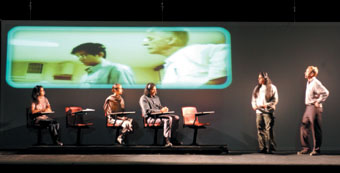
The Buiders Association & motiroti, Alladeen
The second national Time_Place_Space intensive workshop in the professional development of hybrid performance practitioners is underway in Wagga Wagga and the third is already announced for 2004, relocating to Adelaide mid-year and focusing on developing specific works as well as the critical, continued emphasis on process.
The impressive lineup of facilitators for 2003 includes Marianne Weems (Artistic Director, The Builders Association, New York), Andre Lepecki (author, dramaturg, New York), Marijke Hoogenboom (co-founder and dramaturg, DasArts, Netherlands), Michelle Teran (Toronto-based performance, installation and online artist), Margie Medlin (Melbourne-based filmmaker, lighting and projection designer) and Jude Walton (Melbourne-based dancer, performance-maker and installation artist).
The 2003 Time_Place_Space participants are a diverse group of practitioners, ranging from hugely experienced to relatively new, all with credentials in hybrid practices: Michelle Blakeney, Shannon Bott, Sue Broadway, Boo Chapple, Rosie Dennis, Simon Ellis, Ryk Goddard, Jaye Hayes, Cat Hope, Nancy Mauro-Flude, Mike Nanning, Michelle Outram, Deborah Pollard, Hellen Sky, Sete Tele, Douglas Watkin, David Williams, Fei Wong and Yiorgos Zafirio.
As I talked to Marianne Weems, the sounds of hammering and furniture shifting and mention of Meyerhold’s constructivism texture our long-distance phone call—The Builders Association is in the middle of moving office. Building is the right word for this unique multimedia performance company—since 1994 it has built work through collaboration internally and across continents. It builds new technologies and communication systems seamlessly into its work and new cross-cultural ways of looking at the globalisation we are living out in the everyday. Hopefully Weems’ visit will not only share strategies for creation but also begin building a relationship between Australian and North American performance communities.
Weems is a co-founder of The Builders Association and has directed all of their productions. Over the last 15 years in New York she has worked as an assistant director and dramaturg with Susan Sontag, Jan Cohen-Cruz, Richard Foreman, and many others. From 1988-94 she was assistant director and dramaturg for The Wooster Group. The Association’s current production, touring internationally (and destined for Australia in 2004) is Alladeen, a large-scale cross-media performance created as a collaboration with the London-based South-Asian company motiroti, directed by Weems and co-conceived and designed by Keith Khan and Ali Zaidi, featuring a cast drawn from both companies. It combines electronic music, new video techniques, an architectural set, and live performance to explore the myth of Alladeen, better known as Aladdin. The company describes the work as: “drawing on the lives of citizens living in the hybrid, global cities of New York, London, and Bangalore… Specifically, the piece will look at the contemporary phenomenon of international call centres where Indian operators are trained to flawlessly ‘pass’ as Americans. The performance will explore how we function as ‘global souls’ caught up in circuits of technology, and how our voices and images travel from one culture to another…The performance will alternate the contemporary world of the call centres—a web of technology in which the performers are operators—with spectacular, colourful fantasy sequences drawn from the Aladdin story and using the aesthetic of the early Hollywood and Bollywood Orientalist films.”
How do you go about creating a work?
One of things that has always been key to the way that we construct the projects is that everyone has all the equipment there from the beginning of the process, from the first day of “rehearsal” and even long before that. The designers are there with their technology assembled and that becomes a really integrated part of the process and is obviously not something slapped on in tech week…The only way I can function as a director is to have the sound and the video present. It’s not something you can storyboard and imagine and then hope it will work later, just as a performer has to be there for you to be able to see if they can do it or not, what the palette will be, what the vocabulary will be, how it can be articulated.
What happens before that?
Usually there’s a very long conceptual period, sometimes as much as a year that is interspersed with workshops. Alladeen is being created in collaboration with motiroti, and started with me and key members of the company meeting almost monthly (or even more with those other artists) face to face or by intercontinental phone conferences, trading back and forth a lot of email and drawing ideas from sketches and dramaturgical research and videos. Then I would get together with the artists in my company for about a 10 day workshop once every 3 or 4 months and that’s when we’d bring all the media together and, really, just make a huge mess and fool around and see if there was anything of interest that would emerge, say in terms of software that might be developed that would then inform the project or a direction to go in…for example in incorporating animation or a video vocabulary. That would be developed alongside the deepening research, with the video guys going off to a residency at STEIM (Amsterdam) or another place.
What is your role—monitoring, keeping the vision together and developing?
Pretty much all of the above. I try not to monitor, but I’m definitely participating in and articulating what they’re doing and reminding them of how it fits into the project. As they come up with things they bring them back to me and we decide together what is of interest, what is superfluous, what might lead to some other avenue. But pretty much everything the tech guys come up with ends up some way in the project. [Laughs]
It is said that collaborators all perform in a Builders Association show.
The whole ensemble really is about performativity and the technicians are often on stage and the audience watching them work and interact with the performers is as important as watching the actors act–they can’t exist independent of each other, so the sense of them working together to create this spectacle has become a signature for the company–they get constumed and are very visible.
What is it about spectacle that attracts you?
It’s a dialogue that’s been going on since Meyerhold and before with theatre artists threatened by or engaged in a dialogue with mass media and it’s certainly undeniable that you have to come to terms on some level with what is dominant cultural language–television, film and mediamatic culture, it’s certainly not theatre. We certainly don’t have to but it’s part of my interest in the culture’s interest in screen culture, to investigate it on stage and take it apart as much as we can. It’s one of the great advantages of this kind of theatre to be able to look at the stage as a kind of laboratory where you can see what live entertainment still means, what performance is as opposed to mediatised performance and putting those things together in a kind of last gasp experiment of why is performance. I want to unpack all that onstage. I’m certainly not head over heels in love with spectacle in a naive way but like any other good American I have a love-hate relationship with the undeniable glory of spectacle.
How important is cross-cultural collaboration to the company?
We’ve done a lot of work in Europe and pretty much created our reputation and stayed alive by working live there over the last 10 years. We worked for 6 months or more in Switzerland in a cross-cultural collaboration-in many ways it was much more of a foreign experience than working with motiroti. But this our most significant cross-cultural collaboration to date because there have been so many artists involved all over the world, from India to Pakistan, Germany, Sri Lanka, Trinidad… One of the things that has been so heartening has been the ongoing scope of the project, that it continues to snowball. There’s more touring coming on board. There’s a website with many people all over the world logging on. There’s a music video we made which will be playing on MTV India in the Spring. And that was the whole point of the project, to get outside of the theatre as far as possible and reach people who have no real interest in or access to the theatre. It’s been a big step for us but the nice thing about it is that there’s been no compromising of our aesthetic or my sensibility. Our interest from the beginning, and motiroti’s, was not to fall into the conventional multiculturalisms of the 1980s, but to really try to define what a multicultural collaboration could do. I think we’ve achieved some of that.
RealTime issue #57 Oct-Nov 2003 pg. 28
© Keith Gallasch; for permission to reproduce apply to realtime@realtimearts.net
WA’s newest multi-arts festival is the result of a partnership between the City of Swan and Artrage. Last year it was a satellite festival of the biennial Artrage, now Urban Edge is going annual in Midland, one of the fastest growing urban centres in WA. The program—built loosely around a wild west theme of “an imagined place of unlimited potential where the unexpected occurs and regular laws don’t apply”—comprises theatre, sound, visual arts, a huge street event and the Video Head project. The latter is a new media community project involving all the schools in the region. Artrage artists are working with 500 young people creating new animation and video works. As well, images of heads will be projected onto large inflated globes, attached to the roofs and exteriors of prominent buildings creating a new media installation, “with 500 young people seeing themselves inflated to the size of gods”. In a populist-cutting edge blend there’s a sound program mixing country music and some of the country’s leading improvisers. Nexus is a sound installation with “layers of interviews and cultural and social statistics and histories gathered from throughout Midland”. Swerve is an animation program created by Disability and Disadvantage in the Arts WA members working with digital artists. Core Sampler is a huge experimental dance/electronic sound/ digital projection event staged in an outdoor carpark with dancers, new media artists. Urban Edge shows new ways for the arts and communities to join in celebration. Nov 8-22
RealTime issue #57 Oct-Nov 2003 pg. 27
© RealTime ; for permission to reproduce apply to realtime@realtimearts.net
One among Newcastle’s This is not Art festivals, Electrofringe is on as we go to print, drawing thousands to the opportunity to engage with new technology, cross-artform practices and national and international luminaries. We spoke with Co-directors Vicky Clare and Gail Priest in a brief pause between the many months of intensive planning and its imminent realisation.
With the dominance of workshops and panels and presentations and master classes, Electrofringe doesn’t sound like a festival. It sounds like hard work. It sounds educational.
GP Joyously educational!
VC Some people do trip up on the word ‘festival’, but Electrofringe is focussed on skills and arts development because it’s younger people attending who are not established artists or who don’t necessarily have at their disposal the knowledge or the resources to be able to do things they want…Because new media arts across Australia is still quite small, it’s good to create a hub once a year where people can come and exchange ideas, get involved.
Do they really learn things? The overt function is to learn but the latent function is usually socialising and— networking.
GP There’s certainly networking but not aggressive career trajectory networking. When you’re talking with other artists about what you do, you’re going to pick up on things you might not be doing. We’ve focussed the sound workshops on patching at the developmental level. Then we have an advanced level so that we’re simultaneously introducing people to aspects of the technology that they might not be accessing yet, allowing them to see what the next step might be.
VC A small workshop group that I attended at last year’s Electrofringe was about game art and I met Kipper from Melbourne who went on to make the Escape from Woomera game, but who at the time didn’t have a way into any networks. She rallied a group of people there including me and I talked to her about ways she might access support and she then went on to do that. Game art in this festival is a lot more prominent. And Kipper’s coming back.
GP Those things come about as part of the general cultural discussion that goes on. We’re really trying to push this year a mesh between the technical and the conceptual. When people are talking about the technology they’re using they’re also addressing the reasons why they’re using it, how it enhances their practice conceptually. We also have the Jonah Brucker-Cohen (USA) master class and text panels like Writings on New Media which are very specifically about addressing the strength and health of new media culture.
Brucker-Cohen’s work covers a huge area of new media practice with a predominant theme of physicalising the virtual processes in new media technology. I just noticed a new work of his where every time there’s a web hit on an art centre, a jackhammer actually chips into the wall. So it’s all about the realtime effects of the virtual. Some of his work is more software based and about human connectivity. One piece is called Mousetracker in which you connect via the net to another person and your mutual mouse movements are traced onto your desktop. Quite simple ideas about re-connecting people through virtual technology.
VC The Midi Scrapyard Challenge is a real hands-on workshop which will run for 4-5 hours where people can scout around for materials and make midi interfaces.
Does everyone arrive with their own laptops—and soldering irons?
GP We’ll supply the soldering irons.
VC A lot of people arrive with laptops because all their data is on there that they need to be able to plug in.
Who are your other guests?
GP Marije Baalman (Nederlands/ Germany) does wave field synthesis. It’s the re-spatialising of audio as non-directional, whereas in 5.1 Surround Sound there’s one position that’s always the sweet spot and if you move off centre it’s affected. Her work is about creating different envelopes that can re-spatialise in different ways giving greater sensory experience for more of an audience. Marije’s also bringing the work of 7 Berlin artists with her. She’ll do a master class followed by a presentation where she’s applied these techniques to other people’s compositions. We’re trying to give artists an opportunity to present their work in a complete enough form so you get a solid chunk rather than a snippet. That’s what the AV presentations are about–a 40 minute presentation and then a 20 minute discussion on the ideas behind the artist’s work.
DJ Olive (USA) and Janek Shaefer (UK) are turn-tablists. We’re sharing them with Sound Summit, a more music-based festival. Olive and Shaefer do the experimental end of turn-tablism and both do installation work as well. This session will be a demo-presentation–Shaefer has a triphonic turntable with 3 arms.
VC ANAT are helping to bring out the-phone-book Ltd (UK). We’ll have a space with computers for this one. They’re interested in a whole different range of wireless distribution methodologies. A lot of that technology, like the 3D video phone, isn’t readily available here yet so this will be about forecasting, about using this ubiquitous thing called the mobile phone in more creative ways, creating SMS short stories, inventing your own ring tones and animations. It involves software they’ve developed where you can send your animations through to other people’s mobile phones. They’re also interested in how to use these technologies as activist tools.
GP When that technology arrives, we’ll have a body of people who will have a feel for where it can go. And they can take it into their own hands instead of being totally manipulated by advertising.
You’ve got a whole lot of other things happening. How does it work?
VC When I’ve been to Electrofringe over the past 3 years, I’ve always gone to bits of all of it. Even though I’m not a sound producer myself, I go to those sessions just to get an overview. The sound/AV people who are practising artists can be very focussed and sometimes not understand the need for having panels about the whys and wherefores of being a new media artist or curator. But I think the idea of the whole new media arts thing as an ecosystem is important.
Convergence is an issue after all.
GP Exactly…the convergence within the 5 or 6 strands of Electrofringe and across the whole of This Is Not Art. The writers’ festival content involves aspects of new media, as do Sound Summit and Student Media and we’ve got a community TV panel.
How important is Electrofringe in terms of galvanising a community. Is it just the young new media community?
VC No it's the broader community. There’s been an effort to get more established artists to come back, to set up informal mentorships and ongoing relationships that can happen after the festival. Artists like Nigel Helyer have been to Electrofringes in the early days and Alex Davies who’s in Primavera now has come up through Electrofringe. You’re almost seeing a generation who have grown up through it but who are now coming back and now they’re running the workshops and speaking on the panels. A lot of the time, as your practice matures, you tend to stay with your peers. Artists like Josephine Starrs love coming to Electrofringe because it helps her access and make works with these people and have that dialogue.
GP It’s not academic, unlike a number of the other new media gatherings. It’s very much about experience. You feel like you’re beginning to have a practice. With over 50 workshops, panels, presentations and masterclasses involving over 100 artists, Electrofringe is the only cross-media, new media art festival in Australia at the moment, it serves a big constituency.
** *** **
Electrofringe this year will also include New Writings on New Media, a forum about issues in writing about new media, and a very strong program of screen events. From an open call for proposals 3 programs were curated with all states represented. In an important new collaboration, Newcastle Regional Gallery have offered their media space for works best suited to gallery screening. noise, the Reelife festival, Seattle’s Microcinema International and Tim Parish, who works for community TV in Melbourne, have put together programs screening throughout Electrofringe. Game art is another important part of Electrofringe in the FraGGed program of exhibits and forums put together by Thea Bauman, a young curator from Brisbane. Portasonde is dLux Media Art’s contribution to Electrofringe from its regional NSW outreach program. Fourteen Newcastle people have signed up for 3 days of workshops in sound with Allan Giddy, Jamil Yamani and Mark Brown onsite on the Shepherd Hill coastline in a campervan fitted out with facilities to record, edit, mix and produce sound.
This Is Not Art: Electrofringe, Newcastle, Oct 2-6, www.electrofringe.net
RealTime issue #57 Oct-Nov 2003 pg. 27
© Keith Gallasch; for permission to reproduce apply to realtime@realtimearts.net
Research and the Arts is the funding trend of the decade. In a similar way to ‘Marketing the Arts’ in the 80s and ‘Managing the Arts’ in the 90s, research is currently the rubric by which public funds resource the media artist. Linkage and Discovery are some recent terms which, while encouraging cross-disciplinary collaboration between and within many universities around the country, beg the question, how are individual practitioners faring? And are the arts audience and the taxpayer getting bangs for their bucks? The short answer is that it’s too early in the decade to tell, though a handful of practitioners have accessed resources that seem not to have been there before.
The University of New South Wales established the iCinema Centre for Interactive Cinema Research, joining the School of Computer Science and Engineering with the College of Fine Art in Paddington during 2001. A $1.25mil Australian Research Council (ARC) Federation Fellowship brought iCinema’s Executive Director Professor Jeffrey Shaw, lately the director of the ZKM Institute for Visual Media in Karlsruhe, back to his native Australia after more than 30 years in Europe. Teaming up with the Centre’s co-director and ARC Fellow, Dr Dennis Del Favero, and an executive of professors drawn from several UNSW Schools, iCinema has dazzlingly demonstrated the way to forge allies, partners and members, regionally, nationally and internationally, into a strategic entity to tackle “…the comprehensive domain of the moving image that is currently being radically redefined and extended by the variegated potentiality of new digital media systems.” (www.icinema.unsw.edu.au).
With an initial budget of some $2.5 million over 5 years from UNSW, iCinema has established a suite of rooms in Paddington and a laboratory 4 km across town on the main campus in Kensington and will shortly have a fibre-optic working ‘window’ connection (iC_Link) between at least 3 spaces. The link will also be used in the development of Conversations, an ARC Discovery funded project ($330,000) in which “…4 remotely located stations, connected by a high-bandwidth network will enable 4 viewers to be simultaneously immersed in and navigate…a digitally generated 3 dimensional environment comprising computer graphic, photographic and videographic components.
“Conversations is also the story of Ronald Ryan and Peter Walker and their escape from Pentridge Prison in Melbourne on December 19, 1965…the escape will be re-enacted and recorded as a full 360-degree panoramic film. Placed virtually in the centre of the film set, players view the film using the trackers and head-mounted displays to choose their own points of view…Players are able to conduct investigations into the Ryan case, sometimes together, at other times alone. As they do so, by virtue of their actions and utterances, players will permanently change the virtual world.”
Research Professor Ross Gibson from University of Technology Sydney brings his expertise as media producer, historian and proto-criminologist to join collaborators Shaw, Del Favero and Ian Howard, Dean of COFA. Working as art directors, designers and scriptwriters, the specifications for the code and the content it controls are passed to a production team comprising professional staff, postgraduate and graduate students Conversations is headed for the first public outing in September 2004, linking Melbourne, Sydney, Perth and Brisbane.
Interactive narrative space also links projects already exhibiting (Del Favero’s Pentimento and Shaw’s Place-Urbanity have been at ACMI and ZKM) and the first iteration stage of T_Visionarium, an extended virtual environment, in Europe at the end of the year (another ARC grant $300,000). And in the tradition of university-based research, the un-imaginable DVD-ROM and Book combination is due next year, to be published as the first in iCinema’s Digital Art series on the occasion of an international conference.
What about bringing projects to iCinema? Shaw and Del Favero warn that it’s early days. Shaw says, “iCinema is at a moment when we begin to build a history of resources and competencies, technical and intellectual–a set of internally and externally funded research projects–a location with enabling infrastructure. This will allow us to increasingly offer access, certainly advice, to other researchers, artists, students.” The plan is to set up the first ARC Creative Arts Centre of Excellence with a $10 million budget over 5 years.
Where is the work headed? Why cross-disciplinary co-operation? Del Favero says, “What are the mechanisms for the structuring of meaning, say of an hallucination? How are these embodied digitally? While artists would be interested in effect, atmosphere and mood, cognitive scientists, for instance, would be more interested in the cognitive processes at work…clearly there are differences in approach but the interesting things are the points of intersection. If those points can be framed in a collaborative exploration, would it arrive at different, possibly more engaging conclusions? It means we can start treating experience in a more coherent way rather than in the conventional schizophrenic schema which splits the subjective and objective–the purely subjective encounter of the artist versus the clinically objective analysis of the scientist. In what ways does the digital allow the two approaches to co-operate? This is the question that fascinates us…”
RealTime issue #57 Oct-Nov 2003 pg. 26
© Mike Leggett; for permission to reproduce apply to realtime@realtimearts.net
Art + Film exhibition staged at Melbourne’s Centre for Contemporary Photography (CCP), curators Natasha Bullock and Brendan Lee explain that they aimed to explore “the pervasiveness of the cinematic medium and the dynamic effect it has had on contemporary art in Australia.” Yet in his catalogue essay Adrian Martin sees the exhibition not only as a response to the ubiquity of the cinematic image, but rather an acknowledgment that cinema can no longer stand alone as a fetishised cultural object. Paraphrasing Raymond Bellour, Martin characterises the contemporary era as a time of “between-images”, comprising “an audio-visual culture based less on the properties of any specific medium in isolation, and more on the passages and exchanges between them.”
Martin’s observation is important. The works in Art + Film don't indulge in the kind of postmodern appropriation of cinematic forms and conventions that characterised the work of artists like Cindy Sherman in the late 1970s and early 1980s. Cinema for these artists has become an increasingly indistinct part of an all-encompassing cultural milieu characterised by the continuous exchange of images between mediums, contexts and technologies. Given the limited confines of the CCP, Art + Film was only ever going to interrogate this cultural terrain in a modest fashion, but the works on display approached the theme in several thought-provoking, concise and often amusing ways.
The first room contained a series of works examining the intersection of cinema and other forms of technology. Brendan Lee’s Shoot Me for example, employed a simple idea to effectively explore the connections between camera technology and military tools of destruction. A series of black lines on a white wall formed a rectangle, reminiscent of a camera viewfinder. A small disk in the middle immediately shifted the impression to a gun-sight. Upon closer inspection, the disk revealed itself to be a tiny circular screen, showing computer-generated images of a pistol discharging a bullet in slow motion.
In the second room, the viewer entered a hushed, darkened space encouraging the contemplative state usually associated with the cinema experience. In one corner was the exhibition’s largest work, SOWA, by David Noonan and Simon Trevaks, an installation comprising a partitioned space, with a large screen along one wall. The other walls were lined with wallpaper. On screen a video loop depicted a young woman sitting in a room lined with the same wallpaper as the viewing space. At first she read a book, but soon stood and moved across the room as if responding to a call. She paused briefly on the edge of the room, before crossing into a forest, where she was led through the trees by a wolf-like creature. Although SOWA’s dream-like imagery was somewhat cliched, the woman’s constantly recurring passage between domestic space and forest dream-scape, as well as mirroring our physical viewing space on screen, intriguingly suggested cinema’s ability to simultaneously evoke both a material “real” and a state of imaginative dreaming.
However, it was a pair of paintings by Lily Hibberd, from a series referencing iconic sci-fi classics like Close Encounters of the Third Kind, that most successfully explored the inter-penetration of cinema and other art forms. The first, Blinded by the Light [see cover], depicts a young woman grimacing as she shields her face with her arm. In Perpetual Dream-State, a woman with her back to us looks towards a white screen. In her arms she holds a young child, who she seems to be half attempting to shield from the screen. The child nervously clutches its mother’s dress. Both these works were hung in darkened spaces, powerfully lit by a spotlight, which periodically faded to darkness. When unlit, the white screen of Perpetual Dream-State appeared dull and yellowed, but as the lights reached full strength, the screen glowed with a burning white intensity that was difficult to look at. Similarly, the young woman in Blinded by the Light became bathed in a white glare that forced the viewer to squint.
The oil and phosphorescent paintings captured the hypnotic illumination of the cinema screen, as well as cinema’s reliance on the ephemeral qualities of light to bring its images to life. More crucially, at the level of form and content, these 2 paintings illustrated the concerns running throughout Art + Film. The workings, conventions and iconography of cinema have penetrated every form of image-making, while the parameters of what we call cinema have been shattered in turn by the pervasiveness of images and image-making technologies across every aspect of our daily lives. Hibberd’s paintings convey the spellbinding allure of the image, as well as its blinding ability to overwhelm us through its sheer pervasiveness in the contemporary world.
Art + Film, Centre for Contemporary Photography, Melbourne, July 24-Aug 24
RealTime issue #57 Oct-Nov 2003 pg. 26
© Dan Edwards; for permission to reproduce apply to realtime@realtimearts.net
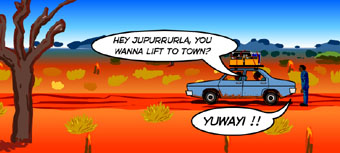
Warlpiri Media Bush Mechanics 2002
Plaything is this year’s futurescreen event, produced by Sydney’s dLux media arts. As well as a symposium, it features an exhibition showing the work of those experimenting with digital games. The exhibition, opening on October 8, will present 9 works of “game art.” I wonder about the adequacy of this term: combining “game” with “art” continues to generate a certain frisson. However it seems important not to submerge the exciting variety of work under a single, rather utilitarian term. The title’s emphasis on play is helpful here. There is something very heartening about being encouraged to play—to mess around and get dynamic—particularly when supplies of energy and creativity are running low elsewhere. But play is also not easily containable.
Curator Josephine Starrs suggests that the proliferation and ubiquity of games make them a natural form for artists to turn to, work with and comment on at present, and she has assembled works showing various engagements with the form. Local and international content is represented, from artists located both within and outside the commercial industry. Installing these diverse works in one space should manifest several of the tensions around contemporary games development, including questions about relations between commercial and independent developers and artists.
The humorous premise of Natalie Bookchin’s Metapet is that players are managers in biotech companies, where the workers have been genetically modified, injected with an obedient dog gene. This Shockwave game offers an ongoing, Tamagochi-like experience where players are challenged to get the most from their metapet, without them cracking up. With an engaging interface and a range of quirky motivational incentives, the game clearly comments on contemporary work regimes. But strategic management never looked so much fun, making me wonder how much irony might get lost in the course of play. gameLab’s Arcadia also seems to relate to contemporary cultures of productivity and performativity, though in quite different ways. It combines 4 retro 80s games in one. Players are challenged to keep up with them all at once, perhaps the ultimate multi-tasking feat. The remarks of players trying out the free version of Arcadia make an interesting commentary—and not just on the game. Reviews posted at the Shockwave site are split between those who say it’s too hard so don’t bother trying, and those who claim it’s too easy and gets boring. Such disparate assessments lend weight to the claims of scholars like Jason Wilson who argue that games have presaged new attentive regimes. Personally, I like “shrimpy’s” assessment: “wow!! this game is CRAZY!! and i like it!!” (www.shockwave.com).
Beijing artist Feng Mengbo’s ah_Q (movie) and Julian Oliver’s QTOTH: Quilted Thought Organ each critically reconfigure aspects of commercially available games and engines. Mengbo has been working with games and specifically Quake, for several years. An earlier work, Q3, saw him star as an in-game war correspondent, interviewing combatants in the popular first person shooter (FPS). In Q4U, a sequel to Q3, all the characters are skinned as Mengbo, creating an uncanny effect that is intensified when the artist performs the piece in real time and effectively kills avatars of himself. ah_Q (movie) is an 8-minute machinima of recorded Q4U gameplay, in which the artist is an avatar inside the gamespace, this time holding a video camera as well as his weapon.
From this recognisable Quake universe, Julian Oliver’s QTOTH totally alters the appearance of Half Life of which it is a hack. The walls and tunnels appear to consist of lines and grids of colour, more abstract and less grey than your average FPS. But apart from this visual aesthetic, Oliver has turned the engine into a musical environment, so that objects and actions performed in the game trigger sound samples. Oliver is particularly concerned with place, and this hack creates a remarkably different sense of space and place. I’m looking forward to seeing the transformations it effects when installed in First Draft gallery. For me, QTOTH points to the range of possibilities for game environments and the ways they can engage users. This is perhaps a point it shares with Mary Flanagan’s new work Curtain which promises to generate a game environment entirely out of text. Though Curtain was not available at the time of writing, Flanagan’s earlier work [search] will be familiar to some from its recent showing at Melbourne DAC.
Two works in Plaything combine game world references with material forms on the one hand, and ‘real-world’ footage on the other. Troy Innocent’s Semiomorph (reviewed in RT #46 p21) investigates the icons and ‘language’ of video games. In this game, the environment is alternately represented as text, diagram, icon or simulation, with 4 corresponding game characters. The goal is to collect enough energy points to create a significant shift in the graphical representation of the world. Interestingly, the cute, bright icons also exist sculpturally, as plastic models which audiences interact with via sensors. I like the idea of giving these colourful others a scale and materiality close to that of gallery visitors. According to Innocent, giving virtual shapes a material form “make[s] virtual reality more real and less virtual.” But while transposing these others into physical form changes our relation to them, it underlines the fact that our engagements with avatars in games spaces are also aesthetic.
The real/virtual status of Zina Kaye’s Observatine initially had me perplexed. In Plaything, Kaye will show edited footage shot from a remote controlled aeroplane flying over Western Sydney. Starrs explains that the grassy areas and treetops we see from this god’s eye view almost look as if they could be part of a rendered landscape in a game (albeit one without characters). But it is not a game, nor a flight sim; rather, it recalls a certain playfulness, perhaps like the hobbyist’s passion for their playthings.
Bush Mechanics, a Flash game designed by Gordon Jangala Robertson, Robin Cave and Donovan Jampijinpa Rice, evidences yet another angle on play. Though the design of this Flash game is simple, it couples the inventiveness and trickster elements from the television series with a whimsy evident in the tasks players must undertake and in how they meet their fate when they fail. Let’s just say the challenges of the Tanami Track were too much for this player, who didn’t manage to get the band to the gig on time and got abducted by aliens several times along the way.
The final work in the show is Rez, a standout commercial release for the PS2. Apart from the familiarity of its promise to “shock you out of your senses”, Rez combines a highly innovative storyline with quite beautiful, at times constructivist visuals and sounds which players cannot help but be moved by. Though it’s not the first time Rez has been shown in a gallery, its inclusion raises several points. Importantly, it recognises the artistry of those working as commercial game artists. Judging from the discussion generated by an April BigKid.com.au editorial, which opined that “industry heavyweights…are clueless about true creativity, and rarely have the ability to recognise it when they see it,” the commercial confines generated significant frustration. Without singling Rez out, its creation by “United Game Artists” makes the point poignantly: who are UGA anyway?
The Plaything symposium will be a great opportunity to discuss these issues and more. Expect more than the usual talkfest and maybe even some fun and games.
–
Plaything, First Draft Gallery, Sydney, October 8; symposium October 10-12 www.dlux.org.au
RealTime issue #57 Oct-Nov 2003 pg. 25
© Melanie Swalwell; for permission to reproduce apply to realtime@realtimearts.net
Clunking and clanking, metallic echoes, submarine-like blips and beeps, the faint whir of a distant turbine. With these eerie, disembodied noises Temporal Intervals announces itself. As you descend the stairs at the Powerhouse, your eyes meet a video image of deep red and black shapes mutating, pulsating and replicating to these enigmatic sounds.
Artist Trish Adams’ installation consists of a digital video loop, here projected on the wall of the Visy theatre, and a complex interactive counterpart with a foot pedal-triggered kymograph and webcam feeding back to a website. The kymograph is a familiar contraption even if its name is not. An instrument for recording various time-related events, it consists of a revolving drum with a record sheet on which a stylus or penpoint travels in response to stimulus. In Temporal Intervals, the kymograph is recontextualised as a mark-making device; as an artist’s rather than scientist’s tool. The participant depresses the pedal, generating a twitch in the machine which is recorded onto the paper and duly transmitted to the website. The trace of that action forms part of the (continuously evolving) cross-media artwork. New media art’s “marriage of 3 cultures”–art, science and technology–is explored in a directly sensual way with the kymograph/website configuration, but Adams’ inquiry into the aesthetic dimensions of the scientific instrument also results in a proficiently staged, somewhat more abstruse video artwork, Dolly 00121.
In this video loop, humanoid figures, some foetus-shaped, some resembling children’s paper cutouts, merge with images of dividing and replicating cultured cells scraped from the artist’s body. This miscroscopy work, which, abstracted from the scientific context has an exquisite beauty of its own, gains new dimensions with the use of Sabattier-like effects and when dissolved with images of the rotating drums and rolling paper of the kymograph. The physical resemblance between these drums and the power turbines of the Powerhouse’s previous incarnation is uncanny; together with the neighbouring set-up of the kymograph and webcam, the artwork constitutes an intriguing, multivalent discourse on electricity.
The early uses of the kymograph to investigate the vital force of life saw its application in, initially confirming, then measuring and quantifying bioelectricity. Now, centuries later, participants intervene in the artwork, receive visual confirmation of the electrical action of their own nervous systems and leave a physical trace of that action. Electricity is the work’s matrix and motif and the kymograph is the fulcrum of this installation. In a society grappling with issues in biotechnology, the artist can be seen to operate as a kind of social kymograph, responding to stimulus and recording, scribing those concerns in a concrete record. Temporary Intervals joins an increasingly important conversation about science and culture, nodding toward questions of scientific determinism and whispers about post-humanity. The video work is particularly successful in its aesthetic response to scientific developments, but is the richer as an art experience for its collocation with the kymography. Interbreeding the physicality and permanence of mark-making with the ephemerality of the data age, Temporary Intervals represents a fascinating and convincing synthesis of analogue and digital concerns.
Temporal Intervals, artist Tricia Adams, Brisbane Powerhouse, Visy Foyer & Stairwell, June 23-July 7
RealTime issue #57 Oct-Nov 2003 pg. 24
© Danni Zuvela; for permission to reproduce apply to realtime@realtimearts.net
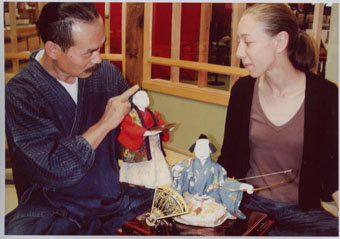
Shobei Tamaya IX & Kirsty Boyle
photo Yuji Hiraiwa
Shobei Tamaya IX & Kirsty Boyle
The challenge of applying for financial support to make work is familiar to most practicing artists. Apparently difficult application forms and complicated budgets can deter potential young candidates. RUN_WAY, offered by The Australia Council’s New Media Arts Board, is an attempt to overcome some of these obstacles by giving young and emerging artists (30 years and under) the chance to apply for up to $5000 towards their own unique professional development scenario using an uncomplicated application process. I spoke to Assistant Program Officer Reed Everingham who has guided and nurtured the program through all 3 funding rounds. Everingham is genuinely passionate about RUN_WAY and the way it has affected its many recipients and stimulated the new media arts field in general. “I’ve seen RUN_WAY really elevate artists and make them feel much more confident about their arts practice.”
As part of the Federal Government’s Young and Emerging Artists’ Initiative administered by The Australia Council, RUN_WAY is based on the Skills and Arts Development funding model but with a much simpler and more direct application procedure.” Making the whole thing less bureaucratic, with less red tape,” says Everingham. “I wanted to say to people, just give us 2 pages on what you really want to do and why you want to do it, and a CV.” This straightforward approach obviously appealed–the New Media Arts Board has processed 101 applications in total. The board has also seen a positive flow on from RUN_WAY into the regular funding rounds with many successful applicants proving themselves in an extremely competitive field. The scheme also educates Council artform board members about youth practice by giving them greater exposure to young artists’ projects.
As soon as the New Media Arts Board announced the first round of 15 successful applicants in 2002, RUN_WAY became the hot topic of conversation in young artist circles. Everingham says, “The first round of recipients did a great job advocating the initiative, and mostly by word of mouth.” Successful RUN_WAY recipients have traveled across Australia, to Asia, Europe, the UK and the US attending conferences, festivals, forums, symposiums, exhibitions and engaging in residencies and mentorships. 44 Australian artists and artsworkers have been supported so far. Only just scraping in to this age bracket, receiving a RUN_WAY grant was enough to have me running around like I was 25 again!
I think one of the most exciting aspects of RUN_WAY has been the encouragement to ‘think outside the square’, to design a skills and arts development scenario that really suits your individual needs. Most artists I know are big dreamers and this invitation seemed to strike a chord with many. I asked artist Kirsty Boyle whose RUN_WAY grant allowed her to follow her dream of studying under Shobei Tamaya, a 9th generation, karakuri ningyo craftsman, what appealed to her most about the initiative. “I liked the freedom of not being confined, and being able to travel overseas,” says Boyle. “If I hadn’t traveled to Japan I would never have been able to study the karakuri tradition. As there is only one living master left it was all the more exciting meeting him and seeing him work in his workshop.” Karakuri ningyo is a Japanese mechanical doll and puppetry tradition that dates back to the 12th century. Since returning to Australia, Boyle has become a Cultural Contact at the Consulate General of Japan’s Information and Cultural Centre, giving guest lectures on her experiences and has a show in October at Melbourne’s Westspace. “It’s been great to come back and have all this new knowledge and inspiration,” she says.
In another out of the ordinary, self initiated program, artist Boo Chapple will undertake an 8-week residency focusing on the areas of cell culture and neurophysiology at the symbioticA lab in Perth exploring what she describes as “the connection between the body electric and sonic/ digital architecture.” Not all RUN_WAY recipients Skills and Arts Development programs were so unusual. The allure of well-established, large-scale international arts festivals like ISEA, ArsElectronica and Transmediale continue to attract many applicants and for good reason. Artists and artsworkers in Australia are aware that far from these shores (or sometimes just on the other side of the country) exists the legendary glamour, fame, fun and fortune (and of course critical debate and discussion) of the world’s leading new media arts festivals. Events like these, I can now say from personal experience, can turn any dull town into a throbbing, pulse point of artistic fever and inspiration. By giving young and emerging artists and artsworkers the chance to attend these festivals, RUN_WAY provides the unique opportunity to experience all this first hand and perhaps most importantly to meet and engage with their contemporaries.
RUN_WAY also encourages young artsworkers to extend and enliven their experience and understanding of interdisciplinary and new media arts practice. Joni Taylor, another first round RUN_WAY applicant, writer and former Electrofringe director, used her grant to attend the European Media Arts Festival (EMAF) in Osnabruck and other smaller scale events throughout Germany. Taylor made valuable contacts in the international new media art scene, some of whom became guests at Electrofringe. One fortuitous meeting was with Jon Dekron, a leading Berlin video performer, famous for his spectacular live shows created using his own video mixing software. Dekron’s enthusiastic and generous approach was one of Electrofringe 2002’s highlights. In RUN_WAY’s latest round Marcus Westbury, Artistic Director of Melbourne’s Next Wave Festival will have the opportunity to experience 2 other important international events, Ars Electronica in Austria and the Next 5 Minutes festival in the Netherlands. This will no doubt lead to more stimulating cross cultural exchange and collaboration opportunities for Marcus and the many other people involved in Next Wave.
Everingham has good news, “We are offering RUN_WAY again as part of our May 2004 application round…let people know about it.”
RealTime issue #57 Oct-Nov 2003 pg. 24
© Anna Davis; for permission to reproduce apply to realtime@realtimearts.net
SBS and SA Film Corporation have just announced the 9 emerging film, television and new media practitioners who will be working full time in the My Space is an Amazing Place production lab at the SA Film Corporation for 20 weeks. They are Jain Moralee, Amy Gebhardt, Luke Gibbs, Karyn Lanthois, Simon Michelmore, Jason Ramp, Will Sheridan, Rudi Soman and Hugh Sullivan. The team will produce 25 innovative, multiplatform pieces for both TV and the web Each clip will be a personal tour of a place that is special or unique to the person who submitted the story idea-their town, suburb, street, room, their head space.
The production lab is now seeking stories about your amazing space for broadcast on SBS TV and online. Community-focussed or intimate submissions are invited from men, women and children all over Australia. To submit a story, go to www.sbs.com.au/myspace [no longer functional]
RealTime issue #57 Oct-Nov 2003 pg. 22
© RealTime ; for permission to reproduce apply to realtime@realtimearts.net
Light bulbs, goldfish, skateboards and Starbucks. Welcome to the latest in new media at Sydney’s Museum of Contemporary Art. Primavera is currently showcasing the work of Australian artists under the age of 35 and it’s a volatile blend. From Daniel Crooks’ angsty jagged/fluid explorations of inner city journeys to Indigenous artist Jonathan Jones’ austere beauty of bulbs and cords, the exhibition aims to explore what it is that defines new media with its intercutting of sound, performance, video art, computer aesthetics and everyday objects.
Tracking time
Entering Alex Davies’ Filter Feeder I am immediately drawn past the projections to the centre of the room. A fishbowl, goldfish swimming happily, children peering in. Gradually the large wall to ceiling projections envelope—hues of yellows and blacks, vertical and horizontal holds—with their strange static/movement and the occasional appearance of a ghostly fish. It soon becomes apparent that it is not my movements that are triggering the changes in the projections—but the fish’s. The sound, too, is what I imagine they can hear, water slapping against the sides, muffled and hollowed-out voices, contained, like those at a shopping mall or an airport. The goldfish bowl becomes a jewel, the light of the projections refracted in beams of intense green light. And as I listen, I am being absorbed by this strange waterworld where the ceilings and floors glide across shiny surfaces. Am I becoming a character in Richard Flanagan’s Gould’s Book of Fish, suddenly desperately up against the other side of the glass?
Daniel Crooks knocks me out with his Time Slice interpretations of moving through Melbourne. Six monitors line up and his video art fluidly moves across the screens. Each segment—train, tram, lift, a pan around a market—uses different computer effects. A view from a train is jagged, relaying how your eye fixes on points, playing catch up in a journey. Looking into the eyes of other people as they look out train windows is spooky, freakish, as if intruding on something private. Layers of bridges and tracks overlap and unfold. A lift and its occupants become amorphous, Baconesque blobs, floating in and out, the lift door like the zip in a pair of Levis, opening and closing to accommodate the 9-to-5 set. It’s a den of pleasure, occasionally grotesque, often erotic, as people glide through. A tram image infinitely reproduced becomes a tidal wave of transformations, a new iconic landscape. I can’t wait to see this work again. Coming soon to a television screen near you when the advertisers discover it.
Adam Donovan’s Heterodyning Cage and Stephen Honegger and Anthony Hunt’s collaborative installation Container both use a computer game aesthetic to implicate the viewer with varied results. Decked out in 3D glasses and moving through Donovan’s industrial space alone I just couldn’t tell whether the work was responding to me as it should. Teenagers ahead of me were having a great time, the boy running around, the girl in the wings laughing and screaming, “What if you jump!” I wander, tracked by cameras that change the perspective of the projected land/soundscape—a warehouse environment touched by lightly falling snow. A character on the screen, a dark shadow of a man’s head, gauges my behaviour, constantly looking over his shoulder. Am I getting him or is he getting me? We both leave feeling paranoid. In Container a large shipping container is converted to a gaming room where I become the central character, breaking into the MCA. Roaming its empty corridors, grabbing a gun, suddenly I'm implicated in murder. There’s blood on the walls. Who have I killed? The curator? The artist? There’s a dab of humour and irony here but no tension. This work is the beginning of something good but it needs more development. It would have been better with the door closed.
City ballet
I love and fear the rooms behind the black curtain, crossing the threshold of digital comfort. With anticipation I pull the curtain across, always hesitant before walking in. Others take an even safer route, gauging from the door whether it’s safe before moving on. I love that moment as your eyes adjust, sensing others in the room, shifting slowly to a seat.
Mari Velonaki’s Embracement captures the shiftiness of a particular relationship—the older and younger woman. A collaboration with the Australian Centre for Field Robotics at the University of Sydney, performers, Melpo Papadopoulos and Leah Grycewicz stand a concentrated distance apart on a crystal screen, their reverse images projected onto other walls. The younger woman lunges forward to hug the older woman. She repeatedly hugs her but each movement is subtly different. Is it a bear hug given to a mother or a stranglehold meted out to a lover? The line between affection and violence is crisscrossed, the lunge betraying anger/fear/longing, tender tension, a showdown and challenge that all relationships must negotiate.
Another man plays out every possible nuance of a relationship in Shaun Gladwell’s large video projection taken from the series Kickflipping Flaneur. Set against a mural at Bondi beach, a skater performs an extraordinary duet with his board. Delicate turns, using all the edges, flipping over to caress the wheels, he falls. Sometimes he’s not there. It’s slow-mo ballet, steady, repetitive and refined, rather than the full tilt of frenzied macho-dom usually seen in documentaries on skate culture. At times his shadow becomes part of the dance too and his board is end-to-end vertical while he teeters on his toes—the new en pointe. Jonathan Jones’ work is about connections and extensions too. A wall of light bulbs hangs off extension cords, the lights switching on and off, triggered by your footsteps. Almost imperceptible when it first happens, a gentle flickering. The heights of the bulbs vary, based on Bondi’s night-lights. Jones’ work is comforting, like the flick of a lamp switch in your home at the end of a hard day; I feel bathed in light as the bulbs give off fireside warmth. And talk about connections. How many light bulb associations can you think of? I count them as I walk its length. It’s a work I would like to take home.
The most entertaining exhibit is The Kingpins’ performative video installation Welcome to the Jingle. Four drag kings (Emma Price, Katie Price, Techa Noble and Angelica Mesiti) take on the ultimate challenge, to be the ugliest males they can imagine. These pimply blond mustachioed fitness fanatics with a Kath and Kim aesthetic reclaim the night, jogging in green satin sweatshirts in synch to the beats of Sydney’s streets. But they’re not pretty faces (as Kath would say); they manage to incorporate the political into their silliness. Their marathon running always leads them to Starbucks cafes, a stylised protest against the blandness of global conglomerates that specialise in coffee but can’t make it. Reminiscent of the genius of the Fat Boy Slim video clip Praise You where Spike Jonze leads a wonderfully incompetent jazz ballet dance troupe in the middle of a cinema queue, it’s priceless watching coffee slurping customers trying to maintain that look of someone desperately trying not to look, perfected by commuters all over the world so they don’t have to engage with life’s unexpected and threatening moments. With a glam rock/wrestling group as their coach shouting out variations of Gallipoli’s “what are your legs” dialogue and a hyper version of Jean-Michel Jarre’s accompanying soundtrack, The Kingpins put into performance form what we have all feared: a middle-aged Mark Lee, still trying to do the same moves on his ‘steel springs’, not recognising that he is past it. As I walk past the Starbucks in Circular Quay I see their blond ghosts moving in perfect time.
In Primavera, all the artists are immersed in the city landscape, illuminating it in new ways. Funny, challenging, sweet and mocking, the exhibition leads the way to a bright future for Australian new media. It's free so take a chance on it.
Primavera will also feature Re-Squared by Kirsten Bradley and Nick Ritar, a series of audiovisual performances, Australia Square, Sydney, Oct 9 & 16, 8-9:15pm
'Primavera 2003, curated by Julianne Pierce, Museum of Contemporary Art, Sydney, Sept 17-Nov 30
RealTime issue #57 Oct-Nov 2003 pg. 21
© Kirsten Krauth; for permission to reproduce apply to realtime@realtimearts.net
One of the greatest misconceptions about German film is that the term German comedy is an oxymoron. Outside Germany many people tend to associate this cinema with brand name directors who used to produce turgid films, populated by tormented characters who have really bad sex. Yet at the German box office, it’s indigenous comedies that draw crowds, and in the 1990s at least, comedies of the sexes, like Rossini—Or the Deadly Question of Who Sleeps with Whom (Helmut Dietl, 1997), were among the most profitable local productions.
The BMW Festival of German Films organised by the Goethe Institut showcases a number of recent comedies, some whimsical, some major box office hits: it also provides Sydney and Melbourne audiences with access to award-winning German dramas, shorts and low budget features. This year the festival opened with full houses for Good Bye, Lenin! (Wolfgang Becker, 2002), a mischievous comedy highlighting the absurdities surrounding the fall of the Wall and East Germany's bungled initiation into capitalism. Here Becker works adroitly within the genre of the “unification comedy.” Evidently millions of Germans are amused by the suggestion that unification is, after all, something of a joke: Good Bye, Lenin! broke the box office barrier of 6 million domestic ticket sales, something local productions rarely do.
Becker is among a group of recently emergent directors, based in Berlin. His modestly budgeted features have picked up a bag-full of prizes. National film prizes are always prestigious, no matter where they are awarded, but in Germany they carry with them added benefits that would make Australian independent filmmakers drool. Apart from opening up more funding agency doors and coffers, German film awards usually carry with them prize monies unheard of in this country. Some prizes, like those awarded Good Bye Lenin!, carry with them hefty monetary bonuses of about $5 million (www.deutscherfilmpreis.de/filmpreis/ index.html).
Becker elicits superlative performances from his cast, which includes the acclaimed East German actor Michael Gwisdek and the young prize winning talent, Daniel Bruehl, who was guest of the BMW Festival last year and star of the deliciously comic no-budget, film school feature, No Regrets (Benjamin Quabeck, 2000).
Good Bye Lenin! sees Bruehl in the role of Alex, a young East Berlin man adapting to life in unified Germany as his ailing mother lies comatose in hospital. When she regains consciousness, she is unaware that the Socialist regime has collapsed and the ideals of the state have been abandoned and discredited. In an effort to avoid the risk such a major shock may have upon her health, Alex strives to maintain the fiction of the GDR, literally restaging aspects of domestic life under the old regime for the benefit of his incapacitated mother. He provides her with an illusion of continuity by reconstructing what has been dismantled. Alex goes to ingenious lengths to console his mother by rationalizing the increasingly conspicuous presence of commodities and signs of corporate capitalism, previously deemed ‘degenerate’.
The festival highlighted the debut work of other emerging filmmakers who have succeeded in navigating the funding agency networks of the Federal Republic. Their films emerge with a remarkable vibrancy despite tortuous dealings with state funding agencies. Suelbiye V Guenar’s, Karamuk (2002) was one such impressive feature debut. Her drama focuses on the turmoil and yearnings of a rebellious teenage girl, Johanna, and presents a sensitive, compassionate portrait of her attempt to secure a cultural identity.
A package of film school shorts, titled Next Generation 2003, was also included in the festival and initially selected for screening in Cannes. Some of the shorts, like Cluck Cluck (Olaf Encke, 2001) and Knight Games (Sven Martin, 2003), are assured in their reliance on absurdist humour and wild flights of fantasy. The Day Winston Ngakambe Came to Kiel (Jasper Ahrens, 2003) takes a comic swipe at xenophobia, effectively satirising colonialist stereotypes and assumptions.
One short, Fetish (Richard Lehun, 2002), received a lucrative federal short film prize valued at around $60,000. Yet this was one of the weakest in the package, falling into the same trap as any number of Australian film school shorts. And that is depicting “old people” as lunatics who are either a) eccentric in a harmlessly regressive and endearing way, or b) haunted by some dark secret that provides opportunity for heavily stylized flashbacks, oozing with ambience and menace.
With its suburban focus and whimsical recollection of a fleeting incident from childhood, Oliver Held’s Spring (2003) may invite comparison with the award winning Australian short, Cracker Bag (Glendyn Ivin, 2003.) Spring brims with the manic energy and irrepressible curiosity of childhood, auspiciously evocative of the student films of Jane Campion. Like many other films screened during the festival, Spring is nothing short of tantalising.
BMW Festival of German Film 2003, Melbourne, Sydney 21-31 August.
RealTime issue #57 Oct-Nov 2003 pg. 20
© Leonie Naughton; for permission to reproduce apply to realtime@realtimearts.net
Aark was founded in 2002 by percussionist Jeremy Barnett, composer Matthew Bieniek and conductor Paul Smith. Bieniek has since drifted away from direct involvement and Aark is now a core ensemble of 8 musicians performing local and international chamber music of the last 30 years—a period with a huge diversity of styles and aesthetics. Rather than choosing to specialise, Aark’s programming looks to be taking this diversity on. Ground covered so far has ranged from minimalism to neo-romanticism, to (more rarely) music of the European avant-garde. Whether there’s an audience out there for “come along and who knows exactly what you’ll get but we’ll certainly do something we think is cool” remains to be seen. Although such a trend has occasionally copped flack from senior commentators, it may well find more resonance in a younger generation with greater acceptance of stylistic plurality. The ensemble has so far premiered one work by Bieniek and there are rumours of another in the pipeline. Plans also include commissions from young as well as established composers. Performances so far have been variable, with a few disappointing moments, but also, for me, some highlights of the year’s new music. Of particular note have been a couple of wildly exhilarating solos from percussionist Barnett, and the ensemble’s second performance of Michael Smetanin’s Undertones which managed impeccably precise ensemble-playing and the requisite aggressive punch. If one can detect a musical preference within the eclecticism then it’s probably in this post-minimalist direction.
RealTime issue #57 Oct-Nov 2003 pg. 4
© Rachel Campbell; for permission to reproduce apply to realtime@realtimearts.net
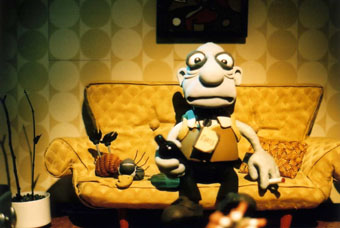
Adam Elliot, Harvie Krumpet, 2003
Adam Elliot is being trumpeted as Australia’s most successful short filmmaker. In June, his 23-minute claymation, Harvie Krumpet (2003, 23min) won 3 of the 4 major prizes at Annecy, the world’s largest animation festival, making it eligible for Oscar nomination. Harvie also won the Best Australian Short Award at the 2003 Melbourne International Film Festival. But Elliot hasn’t come from nowhere: Harvie is the culmination of a unified aesthetic and philosophy, a project begun in 1996 with Uncle (1996, 6min), the first of a trilogy that also included Cousin (1998, 4min) and Brother (1999, 8min). This extraordinarily detailed and richly observed body of work elevates ordinary characters over extraordinary situations and Harvie’s recent success is an apt tribute to Elliot’s finely tuned sensibilities. I asked Elliot how he became an animator.
When I left school I really wanted to be a vet but didn’t have the qualifications, so I studied graphic design. Then I deferred and ended up hand-painting T-shirts at St Kilda market for 5 years. The lifestyle and money were great, but in the end I thought: “Is this what I’m going to do for the rest of my life?” I always liked animation, but never really aspired to being an animator; I had no idea I’d end up as a claymator. So on a whim I went to the VCA Open Day and applied to the film school; I only got in on the 2nd round after someone dropped out. I wanted to do 2D animation until my lecturers convinced me to turn Uncle into claymation.
SBS is very supportive of Australian filmmakers and have a particular affinity for animation. How did they get involved with Harvie?
SBS bought Uncle in 1997 when I graduated, and have supported all my films with presales and broadcast deals. SBS have really been my saviour and we are very lucky to have them. The AFC put a bit of money into Uncle, and fully funded Cousin and Brother in collaboration with Film Victoria. But with Harvie we went to SBS first and got a presale and an equity investment. We then went to AFC for a third of the money, and to Film Victoria for the final third.
Has knocking them dead at Annecy led to further opportunities?
At Annecy, a major distributor snapped up Harvie, after 2 or 3 were in the running. But winning mainly means we get into more film festivals: we’ll now be invited to screen as opposed to having to submit (and we’ll save a fortune in courier costs). When I first started making shorts, I thought that winning a prize meant that someone would give me a cheque to fund my next film. But it never happens like that. Even if we get nominated for an Oscar, it doesn’t really make life easier. It opens doors a little but you still have to push your way through.
You speak highly of your producer, Melanie Coombs. What’s the value of a good producer?
Melanie is everything I’m not. She’s very good at putting budgets together and predicting how much a film will cost. She supports me on every level of the process. So often a director gets all the attention, but what I do is a real partnership with Melanie. She’s been with me right from the beginning of Harvie, although she approached me back when Cousin came out. She said if I wanted to do a longer format, she’d be really interested in producing—not for any commercial reason, but purely because she’s in love with the artform.
What are you working on now?
I’m writing a claymation series called Urban Eccentrics for SBS. There are 13 5-minute episodes and each is a case study about a real urban eccentric who I’ve had to go out and find, which means I’ve met a lot of interesting people! I’m a very slow writer—I’ve done about 6 of the 13 characters–so I probably won’t finish until Christmas. And then we have to finance it. And that can take a year and we need anywhere between one and 2 million dollars to make it. It’s going to be a big task to raise the money. I’ve got some other half-hour ideas in early development. I’d love to do a trilogy of half-hours, but Melanie says that’s not economically viable! A series is a lot more consumable.
RealTime issue #57 Oct-Nov 2003 pg. 19
© Simon Sellars; for permission to reproduce apply to realtime@realtimearts.net
Two Western Australian filmmakers, Andrew Ewing and Jennifer Jamieson, have recently consolidated their position as emerging film talents by securing one of 3 Filmex short film production grants provided by Screenwest. The $62,000 grant will enable writer-director Ewing and producer Jamieson to realise their short drama Automatic, a detailed character study of the relationship between a husband and wife who are challenged by past and present trauma. The pair make a formidable creative team and have previously collaborated on various projects. Both teach screen production and photography at Murdoch University and reflect the strength of the developing inter-campus Screen Academy initiative, which fosters postgraduate filmmaking in WA.
Jamieson has already amassed an impressive list of awards here and overseas. Her short film Soon has screened at several local and international festivals including JVC Tokyo Video Festival (Japan), the European Media Arts Festival (Germany) and Jaffas Down the Aisle (Melbourne). Soon, an evocative meditation on memory and motherhood, has won a number of awards including Best Director, Best Editing and The Kaleidoscope Award at the MetroScreen Kaleidoscope, best film at the SPLIF/ Artrage Festival and the Communication Prize at the Tokyo Video Festival. A recent visit to an international film festival as an invited guest surprised and delighted Jamieson who was unprepared for the passion and corresponding commercial viability the short film scene can generate overseas.
Jamieson is completing her Honours degree at Murdoch University and continues to collaborate with local filmmakers, having worked on, among others, the award winning productions Marama, Resonance and Gaze. Similarly, Ewing is undertaking a higher degree (a screen production PhD at Murdoch). His short film Resonance was awarded Best Narrative Video at the 2002 National Student Film and Video Festival in Sydney and nominated for Best Short Drama at the 2002 WA Screen Awards (WASAs). Resonance was his 4th film as writer, director and cinematographer and stylishly examines Gen X ennui, alienation and the politics of one night stands. His first film, Smile, won the WA Screen Award for Best Experimental film in 1998 and his follow up works, Violence and Capsule, are both screening at numerous national festivals.
Skilled in most areas of film production, Ewing has served as cinematographer on several short films including Tim Holland’s The Malefactor and Sweeper, Jamieson’s Soon and among others, Perplexity and Fade directed by Melbourne based writer/director Stuart Moffat. He has worked on numerous music videos for local Perth bands such as Gata Negra, Headshot and El Horizonte and on the weekends Ewing assumes an alternate identity as a musician, performing on stage in local pubs and nightclubs with his band Thumb.
RealTime issue #57 Oct-Nov 2003 pg. 18
© Mick Broderick; for permission to reproduce apply to realtime@realtimearts.net
Film festivals are places of intersection between national cinemas. This year’s Melbourne International Film Festival provided the space to compare the cinemas of host Australia; and South Korea, which MIFF director James Hewison has championed so strongly and which was represented by 13 features this year.
Both countries are currently contemplating trade treaties with the US in which film and television quotas are potential bargaining chips. Both have production industries that have enjoyed crucial government support through national film commissions. However while South Korea is the success story of recent national cinema, claiming up to 49% of its domestic box office, Australian figures are in the 3 to 4% range. While Korean films are showcased in the growing number of Asian-focused festivals around the world, the conservatism of Australian filmmaking has seen it decline into insignificance at international festivals.
On the basis of what was screened at MIFF, the impressive thing about Korean cinema is the sheer range of production, from commercial genre films such as the wu xia pian swordplay of Bichunmoo and the bloody political allegory of Sympathy for Mr Vengeance, through youth cult movies (Save the Green Planet!, Resurrection of the Little Match Girl) to glossy commercial art-house studies of amour fou (Ardor and Roadmovie) to festival auteurs such as Hong Sang-soo (Turning Gate) and Lee Chang-dong (Oasis). Lee’s recent appointment as Minister of Culture in the new government signals the film industry’s ascension to a significant political force.
This variety of styles and genres in Korean filmmaking indicates a successful meshing of production and screen culture, and impressively most films at MIFF were debut features for directors. The high-level of competence of first time feature directors indicates a strongly supportive industry structure—if not the genius of the system, at least a strong professional cleverness.
By comparison, the label “emerging filmmaker” has taken on a hollow ring in Australia. It is associated with the announcement of “exciting new initiatives” and the consumption of free wine and hors d’oeuvres rather than the building of oeuvres.
Unfortunately the Australian films at MIFF revealed a national cinema that is struggling. Films such as The Rage in Placid Lake, Japanese Story, and Travelling Light stem from an industry context more at home with the theatrical values of Acting and Dialogue than with a vital knowledge of contemporary screen culture. The emphasis on development within film policy seems to be developing the mannerisms that have led Australian filmmaking down to its current state.
Whereas Korean films appealed to a vibrant, technologically savvy, viscerally sexual and violent youth culture, we got The Rage in Placid Lake, a film completely constipated by its own cleverness. Its own startlingly sexist conservatism—boys can fuck around but heroines still have to be virginal—hides beneath a cool which proclaims itself superior to both the right and the left. Style children drink martinis and frolic and are, of course, envied by the unhip straight world that they mock.
It is notable that the major Australian prizewinner from MIFF, Undead, which won the FIPRESCI critics’ award, is a low-budget genre film produced by cinephile enthusiasts without any government funding support. The critics’ citation went out of its way to signal that the film was “everything that Australian films are not supposed to be–popular and disreputable.”
Films are tangible indicators of broader production contexts, and it is worth citing two factors in explaining the differences between Australian and South Korean filmmaking. The first is the relationship of each industry to Hollywood. Korean cinema enjoys the ability to differentiate itself from Hollywood on linguistic grounds. It also has sufficiently strong corporate backing to enable it to compete with moderately budgeted entertainment films. Australian films rely much more heavily on government support, which is smaller and less tied to popular response.
Consequently, Australian cinema has a history of seeking places in the tasteful margins. The cultural capital that has accrued from the Hollywood careers of Australian actors such as Russell Crowe, Cate Blanchett et al has resulted in a national screen culture dominated by a star system that has moved offshore. As the Australian industry struggles for popular success, it is now looking to small local comedies. This is a familiar strategy in many countries. Comedies may not travel well, but if you give up on your international ambitions, you can at least limit the downside, and every so often you get a Crackerjack or The Castle.
A second set of factors concern the way that Korean cinema has grown on the back of an increasingly regional appeal. The Pusan Film Festival has quickly become one of the major sites for regional deal making through which Asian film industries have supported each other so effectively. Screensound’s recent restoration of the 1970s action film, The Man From Hong Kong, perhaps stands out here as a symbol of the path not taken. Australian post-production work on recent Hong Kong/Chinese films such as Hero and So Close provides isolated instances of the opportunities for links with regional production, rather than simply concentrating on an annual Cannes push or the vagaries of international co-productions with Europe or North America.
One conclusion that might be drawn from the Australian films at MIFF this year is that the production of dramatic feature films is beside the point in Australia. It is increasingly evident that the strength of our filmmaking is in documentary production financed by television. The optimist might look to 2003 as Year Zero, the year when we saw it wasn’t working and that we need to try something else.
Australian filmmakers and administrators need to stop pretending that they are “telling our stories”—stories in which we collectively seem to be manifestly uninterested. Let’s propose a new start, which includes going to the movies more often to see what’s emerging in countries such as South Korea.
RealTime issue #57 Oct-Nov 2003 pg. 18
© Mike Walsh; for permission to reproduce apply to realtime@realtimearts.net
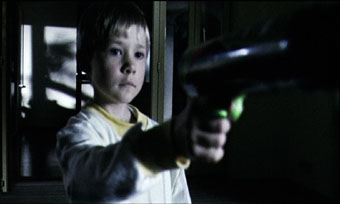
Pests
Victor Abbott started as an engineer. Angela Walsh developed her skills in radio and television. Directing his own short films provided Judd Tilyard with an understanding of “how hard it is to be a director without the proper support a good producer can offer.” Emma Spencer discovered that she “was always the one organising everything for the shoot, and making sure everything got done.” From these diverse backgrounds, a group of promising producers is emerging in Queensland.
Recent decades have seen the producer’s role diluted as discourses of auteurism gained critical and popular mindshare. In contrast to the Hollywood studio heyday, when the producer was the dominant figure, and the director more often “the producer’s brother-in-law” (Gore Vidal), recognition for contemporary producers, even in film culture, is often scant. The image of the demonstrably ignorant financier-philistine producer, rolling onto set occasionally to loudly oversee proceedings before retreating to power lunches, is light years away from the kind of producing done by these Queensland independents. Rather, work in the ‘slog years’ is characterised by long hours and minimal remuneration driven by a personal connection to the work.
Judd Tilyard says: “to me a producer who’s just about putting together the details is a glorified production manager–if they can’t understand why making the film the best it can be is important, then why are they doing it? If you’re seeking money or fame there are better professions out there.” Most producers have to subsidise their work with other jobs; Walsh does voiceovers to support her “filmmaking habit”, and Abbott concentrates on “fewer but quality projects” rather than navigating “the financial instability of being dependent on filmmaking for a living.” For Spencer, producing is just one of many things she does as manager of a multimedia production company.
Philosophically, there is much that unites this group. All, for example, are utterly pragmatic when talk turns to their own creative capacities. “As I can’t direct and am not a masterful writer, but have the skill to work with others, understand a vision, organise things and get things done”, Abbott says, “producing appeals to me.” He adds, “it’s important for the creative producer to understand that their main job is to support the director’s vision.” While Tilyard “hasn’t given up on directing”—he is warmly regarded in the close-knit Queensland film community and in high demand–there’s a certain inevitability (about the job) to which even he seems reconciled. “It’s simply part of who I am.”
Likewise, though Emma Spencer enjoys writing and directing, she finds she needs “to be involved as a producer on some level with every project I work on, it helps me feel a little more in control over a medium that generally runs along the lines of barely organised chaos at the best of times.” Despite numerous awards for writing, Angela Walsh says: “you can be good at something and that doesn’t mean you want to do it.” Work across other media has solidified Walsh’s self-knowledge and her sense of purpose: “I can direct, but it’s not a burning ambition. I get quite excited about finding someone who’s very good at what they do and matching them with someone else… and then making this team who are really excited about a project—there’s nothing better.”
This clear-eyed assessment of individual skills and talents links with a belief in the incontrovertibility of specialisation. For Abbott, “it’s important to get buy-in from the production team”: this means not only being responsive to “what they want to get out of the production” but “respecting crew and cast disciplines—I believe in the tenets of ‘the director directs, the producer produces and the actor acts’.” Believing passionately that “everyone has a gift, and they’re going to look into every facet of that”, Walsh sees the job of producer as primarily about cohering specialisations. Spencer agrees: “it sometimes feels like trying to mix oil and water, but it is the producer’s job to be aware at all times where each of the elements are and to make sure they come together in the end.”
Undoubtedly the greatest challenge for producers, emerging or otherwise, is budget. For Walsh budgets are the biggest trial, outdoing even last-minute shocks like a child actor disfigured by a skin condition the day before shooting. For Tilyard, they are the necessary limitations against which a producer displays their mettle; “it can feel like you’re drowning in problems, but you have to remember, it’s times like these that define a filmmaker’s life–these are the war stories you’ll tell at parties.” Spencer puts it in a typically laconic, Queensland way: “no matter how much money you are given it is never enough and you will always have to find ways to rebuild the Titanic when there is only $22.50 left in the art department.”
Offsetting these budget trials, the producers recount myriad tales of assistance and encouragement from the film community, from donations of equipment and resources to mentorship and exceptional generosity. Tilyard recently worked on a production where camera assistants from interstate offered time and experience, demonstrating that the community is national and “how people pool together to make dreams a reality.” The legendary intimacy of the Queensland community figures largely too: “everyone from suppliers, local professional crew, film school graduates, established producers, production companies and other industry practitioners are all willing to help and offer advice or services,” says Abbott, adding “there’s a real camaraderie and cooperative spirit among Queensland filmmakers.” Walsh decided to pursue her producing ‘up north’: “I quit my job, went freelance and came up here. I thought, if I’m going to be broke I may as well do it where it’s warm!” Her connection to place is common to many Queenslanders: “I’d love to be based in Queensland and have a successful production company here, get stuff off the ground and bring really good actors here and get great new ideas up–get people to live and work in Queensland.” For Walsh, this means work overseas, “to learn from different people, then bring it back here.”
These producers ultimately learn to be masters of realpolitik: “you have to be prepared to just throw everything into keeping the film running,” says Tilyard. Walsh agrees, “the producer’s role is to say ‘regardless, we can make this film happen’.” Abbott’s pre-film career furnishes him with a sense of civic duty: “I guess it’s the engineer in me that wants to see things made for the good of society.” After some serious soul searching he says he “wasn’t interested in TVCs, corporates, music videos etc, but in telling stories about who we are as people that resonate with my spirit.” For Tilyard, it’s only natural “when you surround yourself with talented people they will have great worlds of their own dying to be brought to life.”
Never underestimate a good producer, says Spencer, “they can move (or make) mountains for you if the project needs it and despite the bags under her eyes and the tufts of hair falling out from stress, she will always ensure that there is room in the budget for a slab of beer at all production meetings…A good producer is a woman with her priorities set straight.” Abbott concludes, “filmmaking can often be soul destroying and heart-wrenching but when you see the collective creation up there on the screen, the joy makes it all worthwhile.”
Recent Producing Roles: Angela Walsh Tongmaster, Judd Tilyard Pests, Emma Spencer The Last Hour, Victor Abbott Brace Yourself
RealTime issue #57 Oct-Nov 2003 pg. 17
© Danni Zuvela; for permission to reproduce apply to realtime@realtimearts.net
Looking around and not really knowing where to find new documentary filmmakers (even though, I realise now, they’re all around us, except I don’t always think of them in that way—new/old etc—I mean, does that really matter?) I’m introduced fortuitously to a new series of half-hour documentaries on SBS called Inside Australia. All new directors, several with little or no broadcast or filmmaking experience, and a determined push to put them up the front of the schedule—7pm on a Sunday. What could be better? Let’s see…
Meet George from Aurora Scheelings’ The Trouble with George (the first film on the schedule) except he’s not really trouble, he’s a delight, albeit maddening, infuriating, a handful, 2 handfuls even. George is 81 with the mental age of a small child. Brian finds him living in a bus shelter so he takes him home to his wife, Jennifer, and they look after him. Now, several years on, Brian and Jennifer have parted but Jennifer is still caring for George. “Why?” you might ask, as this film does. George is a character but you know he’s hard work-imagine an irascible old man with a toddler’s temperament-although you can also see why he’s still with Jennifer after all this time. It’s an unusual relationship, partly mother/child but also one of companionship and mutual need, an irresistible emotional call and response. The film’s strength is that it makes sense of it all without wrapping it up too neatly–in the end, we don’t really know what will happen to George and Jennifer but that’s okay.
In Me Me Me and ADHD, directed by Shelley Matulick, Ben is a 21-year old with, that’s right, ADHD—he’s practically bouncing off the insides of my TV, so much energy pouring down the tube. Not that Ben is going down the tube, he’s right there dead centre—I mean, of course, there’s a documentary being made about him-who else? His family are there too, although rather more battle weary and circumspect. They don’t really come alive to the same degree as Ben but that would be hard to do anyway (only the boy who lives down the road, also diagnosed with ADHD, comes close). The film works because it doesn’t try to airbrush ADHD but manages, mainly, to show what it’s like to live with it on both sides, inside and out.
Disturbing Dust (director Tosca Looby) is a very ordinary story in that it is about a woman, Robyn Unger, dying of cancer, an everyday occurrence for somebody, somewhere, and something that is oddly banal for all its awfulness. In this instance, Robyn has mesothelioma, which she contracted as a result of handling asbestos sheeting 25 years earlier. There’s understandable anger that an activity as innocent and matter-of-fact as building a house should lead to such painful consequences decades later, but it’s to the credit of everybody involved that this outrage doesn’t obscure the central, inevitable process of somebody dying with whatever dignity is allowed. In one scene, Robyn farewells her work colleagues who, watch wide-eyed and dumbfounded by what’s happening, even as Robyn chats matter-of-factly about her cancer. At times, Robyn and her husband, Peter, appear incongruously cheery as they prepare for death, in the manner of people trying to jolly themselves along in the midst of great pain because the alternative doesn’t bear thinking about.
There’s nothing lightweight about these topics and the rest of Inside Australia promises more of the same but on the evidence of the first 3 episodes, the effect is undeniably positive. It’s continually amazing–what people can do—and this is something the directors all seem to recognise and value. The episodes are pacey and taut as befits a half hour slot, no gradual unfurling or leisurely settling in-the subjects fill the space and the screen and the immediacy is an obvious counterpart to the intimacy between the directors and their protagonists. The filmmakers are savvy, as are the subjects.
Obviously, in half an hour, there are going to be elisions and lacunae–you sense there must be more to George and Ben and Robyn and their situations (there are hints of this in the films anyway)—but I guess we’re mature enough now in our viewing to understand that this is television and half an hour with these people is far, far better than nothing at all.
The 3 opening episodes, for all their differences, document the pressures of living together today, especially when those pressures are intensified by specific challenges; Inside Australia, in this instance, means indoors, in the family home, and the dramas played out in bedrooms and kitchens. Other episodes promise to take us outdoors, but the focus remains tight-individuals, families, small communities-as if these are the basic units with which to build an understanding.
‘New’ documentary, in this instance, means staying close to home and watching the daily dramas of people trying to get by in the extraordinary everyday. Perhaps these documentaries are a reaction to the seamless gloss of ‘lifestyle’ and faux reality where a simple makeover can seemingly make everything okay. Undoubtedly, too, it’s easier logistically to make these ‘home’ movies, especially for first-time directors. ‘New’ means something well-formed but fresh, a personal engagement that doesn’t necessarily equal ‘SBS documentary’ but ends up there anyway. It takes a fair bit of passion to make documentaries this way-why else would you do it?–but the results speak for themselves.
Inside Australia was commissioned at SBSi by Commissioning Editor Marie Thomas who is upbeat about the state of the documentary as exemplified by the directors in this series: “At the moment I think Australians have every reason to be positive about their industry. I think that it is on the move and we are on the crest of a new wave of creativity. Certainly at SBSi we feel that we have been allowed to renew our remit to invent and change. I sense that the industry is loosening its stays. There are a host of really bright, committed new filmmakers out there-under 35, full of fight, ideas and attitude. Just what an industry needs to thrive.”
Directors mentioned by Thomas as the ‘tip of the iceberg’ (not just new but emerging talent) include Aurora Schellings, Emma Crimmings, Melanie Byres, Zane Lovett, Kate Hampel, Shelley Matulick, Rebecca and Jonathon Heath, Sean Cousins, Tosca Looby, Faramarz K-Rahber and Anthony Mullins and producers Melanie Coombs, Anna Kaplin and Celia Tait.
The challenge now is to ensure that the ‘new wave’ translates into something sustained and sustainable for these directors, with enough impetus, perhaps, to push them toward more, bigger and better projects. Thomas believes that the local documentary scene has been playing it “a bit safe” lately, leaving it to overseas sources to develop new forms and reinvigorate old ones. “Worst of all, this conservatism isn’t bred by lack of funds. That’s fumbling with fig leaves. We’re the cause of it. Filmmakers and broadcasters alike,” she says.
“When I arrived in Australia, I was fresh from the frontline of the terrestrial UK market where a lot of the broadcasters’ time is spent considering who will watch and why, balancing ‘should-be-made’ with ‘it’s-what-they-want’ programming. On my arrival, I was shocked by the ‘bugger ‘em’ attitude towards the viewer that I found amongst filmmakers here. It seemed so counter productive.
“First and foremost, television is a medium that needs to be watched in order to be effective and second, we are dealing with viewers who have been watching television for half century and documentary for longer than that. To assume they can’t make informed choices seems to me to be arrogant. Good ratings don’t equal dumbing down-and yet that was the regular war cry I heard from all around.
“Recently SBSi and the independent sector have been given the thumbs up by the channel’s television management. Ned Lander, Senior Commissioning Editor, and I have been told to give our TV instincts and new ideas a go-ideas that perhaps a year or 2 ago may not have been seen to be fitting or ‘the thing’ for the channel to do. Personally I feel that we are being allowed to open the door to new players and fresh content and being given the opportunity to widen the vernacular of documentary output. From now on, programs can come in different shapes and sizes, as will budgets. We have been given the opportunity to play with light and shade in the schedule.”
Inside Australia isn’t going to change the scenery overnight but it is a good start. Stay tuned.
Inside Australia Sundays 7pm, SBS from October 12
RealTime issue #57 Oct-Nov 2003 pg. 16
© Simon Enticknap; for permission to reproduce apply to realtime@realtimearts.net
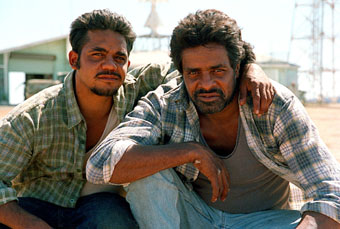
Wayne Munroe, John Moore, Cold Turkey
Where does the short feature film sit in the film industry as a creative form and something to sell? While Australian-made documentaries can fill an ABC or SBS 50 minute slot with some regularity, how often is it we see an equivalent drama on television? And what life is the short feature likely to have in the cinema, except in the most subsidised of circumstances? The Australian Film Commission AFC commenced regular funding of 50 minute films several years ago, partly as a response to cutbacks which had made the funding of low-budget feature length films increasingly difficult. The 50 Minutes From Home—An Australian Film Festival, touring the country throughout September and October, showcases 9 of these recent short-feature productions.
The 50 minute film program has undoubtedly been successful in maintaining a level of production for new directors in a time of increasing financial strain for Federal Government funding bodies, but the turn to 50 minute features also highlights an underlying problem in the Australian film industry. In the 1990s, and into the present decade, directors lucky enough to get their debut features off the ground have rarely been given the opportunity to develop their talent with follow-up features. Audiences are constantly given glimpses of nascent talent never allowed to develop beyond the embryonic stage. 50 minute features have allowed a group of new directors to move from shorts to longer-form dramas, but the program does not address the fact that true directorial development requires a sustained career in feature production over many years. Furthermore, like the current crop of full-length Australian features, most of the 50 minute films reflect a broader stylistic conservatism that seems to plague Australia’s screen industries.
A career bridge?
Carole Sklan, Director of Film Development at the AFC, believes that television is the ultimate home for 50 minute films, since they are generally not viable in a commercial distribution context. This fact is reflected in the heavy involvement of broadcasters in funding these films. Of the 9 short-features in the 50 Minutes From Home festival, 6 were co-funded by SBSi, one was co-funded by ABC drama, and one is an SBSi and NSW Film and Television Office (FTO) co-production. Only The 13th House was entirely funded by the AFC, without any pre-sales to television. The makers instead intend to rely on festival exposure. But as director, Shane McNeil points out, the 50 minute length can present problems in a festival context. Depending on the event, the film is sometimes expected to compete with full-length features, while at other times it is classed as an overly-long short. The AFC and SBSi are to be commended for recognising these difficulties by programming cinema screenings.
While it’s impossible to predict that the 50 minute program will succeed in assisting a new generation of Australian filmmakers to make the leap to full production, Sklan believes it has played a vital role in maturing the filmmakers involved: “When you have to tell a story on screen for a sustained amount of time, it requires the development of story and structure, explorations of character, and a range of emotional tones. I feel that these teams are now in a much stronger position creatively, and in terms of their craft and technical expertise, to handle a feature-length film.” McNeil concurs: “Previously, a director would make a couple of shorts and if they were lucky they would be given a feature. They’d jump in and have to sink or swim. If they sank, it was a long time before they swam again.”
While there can be little doubt that a 50 minute production provides valuable experience for a filmmaker, the program does not solve the problem of the overall shortage of funds for feature production. As already noted, the Australian film industry is full of filmmakers whose careers consist of several shorts and one feature. Unless the AFC can continue to support most of the 50 minute filmmakers, there is a real danger that the scheme will simply produce a generation of directors whose career instead consists of a few shorts and a 50 minute feature. This is not a criticism of the AFC or the 50 minute initiative per se: the organisation has effectively managed to maintain a level of production in a funding environment not of its own making. There is, however, a certain fruitlessness in fostering talent in this way if we, as a nation, are not prepared to then support its full flowering.
The films
Without the financial risk of a feature production, the 50 Minutes program also potentially offers the opportunity to explore the kinds of formal and thematic possibilities so rarely seen in contemporary Australian features. Judging by the films of the festival, however, this has not generally occurred. With the exception of The 13th House, and to a lesser extent Cold Turkey, the films remain firmly within the naturalistic dramatic tradition that has dominated Australian cinema for decades.
Whether this is a result of the AFC’s selection process, or the nature of the projects applying for funding, is difficult to tell. It’s also possible that the involvement of television broadcasters has played a determining role although SBSi is certainly the most adventurous funding body associated with free-to-air television in this country. But it is perhaps significant that The 13th House, by far the most stylised film in the festival and the only work to operate outside the conventions of naturalistic drama, is also the only project made without the involvement of a broadcaster. A metaphorical tale about employees brutalised by corporate culture, the film was originally conceived as a television pilot for a Twilight Zone-style anthology series, which was unable to attract any interest from the Australian television sector. The makers of The 13th House were able to realise their project exclusively on AFC money by working within a budget several hundred thousand dollars below the average of the other films in the program.
Steven McGregor’s Cold Turkey (RT 56, p18), like The 13th House, is formally challenging and continues the trend in Indigenous Australian cinema of powerful dramas not afraid to engage with the country’s social, political and historical conditions. Jessica Hobbs’ So Close to Home also manages to engage, to an extent, with issues outside the interpersonal familial concerns of most of the films, centring on the plight of a young immigrant whose mother is in an Australian detention centre.
Overall, however, the films in the 50 Minutes From Home festival remain within the sphere of the family or interpersonal relations, and tell their stories in a very traditional naturalistic style. Which is not to say they are not of a high standard. Martha’s New Coat in particular is distinguished by an outstanding script and a searing performance from Matilda Brown in the title role. Roy Hollsdotter Live offers an intriguing rumination on the performative nature of the faces we show our friends and lovers, through the tale of a disintegrating relationship between a stand-up comedian and his girlfriend. The film also features some effective passages of expressionistic editing and lighting, punctuating an otherwise fairly straightforward narrative.
50 Minutes From Home played in Sydney’s Valhalla Cinema just a few weeks after the venue hosted the Next Generation 2003 showcase of short films by new German directors, as part of the BMW Festival of German Cinema. The contrast between the range of styles and subject matter on display in the German shorts was striking when compared to the relative homogeneity of the Australian films.
50 Minutes From Home-An Australian Film Festival, presented by the AFC and SBSi, various cinemas around Australia, touring from Sept10-Oct 25
RealTime issue #57 Oct-Nov 2003 pg. 15
© Dan Edwards; for permission to reproduce apply to realtime@realtimearts.net
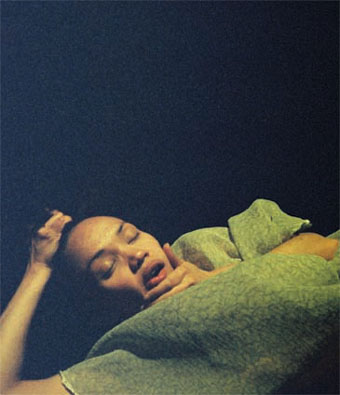
Nareeporn Vachananda’s Konstantinos Tsetsonis
Nareeporn Vachananda’s choreographic development is striking not only because of various performance opportunities—Dancehouse’s open seasons, Great Escapes (1998-9), curator/performer Stephanie Glickman’s Focus 4 (2002), but also from initiating her own, small-scale program of works–in-development: the Inspiration Series 1 and 2 (2003). This series showed her solo work-in-progress Opposite My House Is a Funeral Parlour and studies by Ashley May Mariani (Program) and Ilan Abrahams (Ritual For ReInhabitation). Vachananda has a slight, thin form, which she employs with considerable grace and poise in performance. She worked with the Grotowski-inspired dance-maker Tony Yap in director Michael Kantor’s production of Meat Party (2000). Yap’s often violently ecstatic technique has imparted a radical darkness and ambiguity to Vachananda’s choreography, distancing it from Western cliches of grace in the female Eastern dancer and rearticulating those qualities already embedded within Vachananda’s movement and physique, into a more progressive, avant-garde context. Vachananda’s current project is an ambivalent study of the twisted psychokinesis generated by the meditation of the individual on death and absolute negativity and how this can act in some contexts as a positive journey with an uncertain and potentially revelatory significance for the living subject. The Inspiration showings indicate that Vachananda’s solo is already an arrestingly layered, minimalist work; a style she seems likely to continue to investigate, building on her formalistic study mounted within Focus 4.
RealTime issue #57 Oct-Nov 2003 pg. 14
© Jonathan Marshall; for permission to reproduce apply to realtime@realtimearts.net
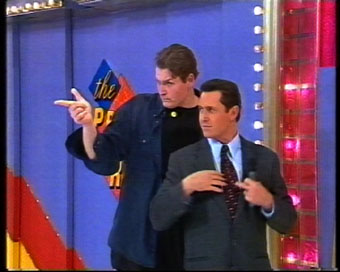
Emile Zile, Larry Emdur’s Suit
Emile Zile is a Melbourne-based artist who reuses media the stuff of television, print and the internet—in a range of works for VJ, performance and installation (www.bubotic.net). A graduate of Media Arts at RMIT, most recently he took part in the Composition show at Degraves Street subway in Melbourne. For this he made a series of “wartime psychosexual” slogans in red vinyl lettering with red neon. They were “mutated advertising jargon for alert commuters; text blobs of compressed meaning: GRASS IS GREENER SUICIDE BOMBER; LICK MY ZIP SAVE MY BEIGE; ENTERTAIN ME WHILE I CHEW.”
His video work Larry Emdur’s Suit is a classic. Finding himself a contestant on The Price is Right, Zile successfully guessed the price of the Nursery package and moved up to share the stage with host Larry Emdur. This is where Zile ‘performs’ himself in a bizarre series of hand gestures and contorted postures to which Emdur responds by mirroring. Zile effectively bends the materiality of television to his will, making Emdur follow his dance. It is hilarious and very, very strange.
His most recent work is Holy Cow, a reworking with original internet audio and video clips of people watching the WTC destruction from their office windows. Zile says, “I hope to excavate deeper levels of meaning in the material than the immediately audiovisual, by re-animating that material in another context, often in live performance-manipulation of the multiple perspectives of one event and magnifying the intersections of personal, social and televised history. I am obsessed by the individual frame that separates a home video from an international news item.”
RealTime issue #57 Oct-Nov 2003 pg. 14
© Linda Wallace; for permission to reproduce apply to realtime@realtimearts.net
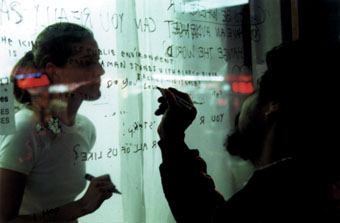
Astra Howard, Public (private) living spaces II, Kings Cross, 2000
Parts of Astra Howard appeared in the Outside In exhibition of works by UNSW College of Fine Art faculty members and PhD candidates curated by Rilka Oakley at Ivan Dougherty Gallery earlier this year. In particular, one of her legs and an arm protruded from a white box high on the gallery wall creating a troubling sense of exclusion and confinement in the bodies free to roam the gallery. The Other (Inside) II is one of a number of public actions captured on video and replicated as a live performance during the exhibition. As well as galleries, Astra has performed this action on the streets of Sydney and Delhi. Winner of a 2002 Samstag International Visual Arts Scholarship, Howard has recently returned to Australia after a year travelling in Beijing, Paris, New York and Delhi comparing attitudes to public and private, stationary and transitory, individual and community and sense of concealment and exposure. In her ongoing project, Vagrant Landscapes for Transitional Bodies she asks, “What are the various contentions experienced by an individual interacting within an urban public space environment, and how can these positions be recorded, activated, manipulated or remembered?” In other actions, Howard has taken to city buildings with a stethoscope (Blindspot: feeling cities, 2001) and in Public (private) > living spaces II, 2000 occupied a Kings Cross tobacconist’s for a week, communicating with passers-by in written conversations on the glass.
RealTime issue #57 Oct-Nov 2003 pg. 14
© Virginia Baxter; for permission to reproduce apply to realtime@realtimearts.net

Rowan Marchingo and Alexandra Harrison
photo Daniel Bereholak
Rowan Marchingo and Alexandra Harrison
Rowan Marchingo appeared in the 4 on the Floor season hosted jointly for 2 years running (2001-2) by physical theatre company Legs on the Wall and Company B Belvoir Street’s B Sharp program. Evident in his work was what appeared to be a new hybrid with the athleticism of physical theatre combined with a sinuous and sexy, more dancerly vocabulary. Marchingo is a graduate of Rusden College (Deakin University, Melbourne) who also trained for a year at the National Institute of Circus Arts. After graduating, he freelanced with members of the band Augie March (Holistic Invention), with choreographer Jodie Farrugia (InOutside at Dancehouse) and Object! with fellow Rusden-graduate Gerard Veltre. He also worked on a number of youth and community projects including Cyberdance involving 100 participants, before moving to Sydney in 2000 to join Legs on the Wall. Together, the work he choreographed for 4 on the Floor was a duet for Marchingo and Alexandra Harrison focussing on the difficult balance between sameness and difference with which we all struggle in relationships. AFTRS student Madeleine Hetherton’s film of this work is in post-production for release in 2004. Rowan Marchingo balances his workload with Legs (including a recent tour to Berlin and creative development on 2 new works with Wesley Enoch and Chris Drummond) with forays into the community dance arena, working as choreographer and tutor. This year, he’s participated in a creative development with Fling, a young dance company in Bega and choreographed Group Dynamic, a short dance piece for the Australian Choreographic Centre’s Quantum Leap Youth Ensemble.
RealTime issue #57 Oct-Nov 2003 pg. 13
© Virginia Baxter; for permission to reproduce apply to realtime@realtimearts.net
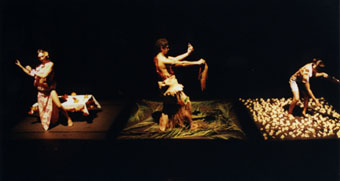
Polytoxic
Ioanne Efeso Sidney Fa’anana is a New Zealand-born Samoan raised in Ipswich, Queensland. Efeso became Fez when his Australian teachers “would pause then stutter when it got to my name on the attendance roll!” This early experience of cultural friction finds contemporary resonance in Fez’s work with Polytoxic, the dance company he founded with Lisa Fa’alafi in Brisbane in 2000. Suzuki-trained Leah Shelton joined the group in 2002. The “poly” in the company’s moniker refers to their Polynesian roots and to the polyvalent voice they are finding as they fuse traditional Samoan dance with hip street and physical theatre sensibilities. Working extensively with the Youth Arts network in Queensland, Polytoxic have performed at events as diverse as the Asia Pacific Triennial at the Queensland Art Gallery and, soon, at uber-cool Valley nightclub, Family. They have collaborated consistently with local indigenous groups as well as other Polynesian communities in Brisbane and want, in Fez’s words, to “create performance that can reach and relate to as many cultures, subcultures and sub-subcultures as possible” in order to push dance genre boundaries and debunk orientalist notions of Polynesian dance as “floor show” entertainment for Western tourist consumption. Their forthcoming production, Teuila Postcards, a collaboration with Brisbane design, art and music outfit Rinzen, for instance, detonates reductive stereotypes of dusky island maidens “combing their hair on a rock” and Hills-Hoists in taro-leafed Samoan Australian backyards. Fez’s sharp satiric eye (which he attributes to an early diet of Young Talent Time and the Solid Gold dancers) combines with an astute cultural-political sensibility. Polytoxic is a formidable, innovative company worth watching.
RealTime issue #57 Oct-Nov 2003 pg. 13
© Stephen Carleton; for permission to reproduce apply to realtime@realtimearts.net





















































